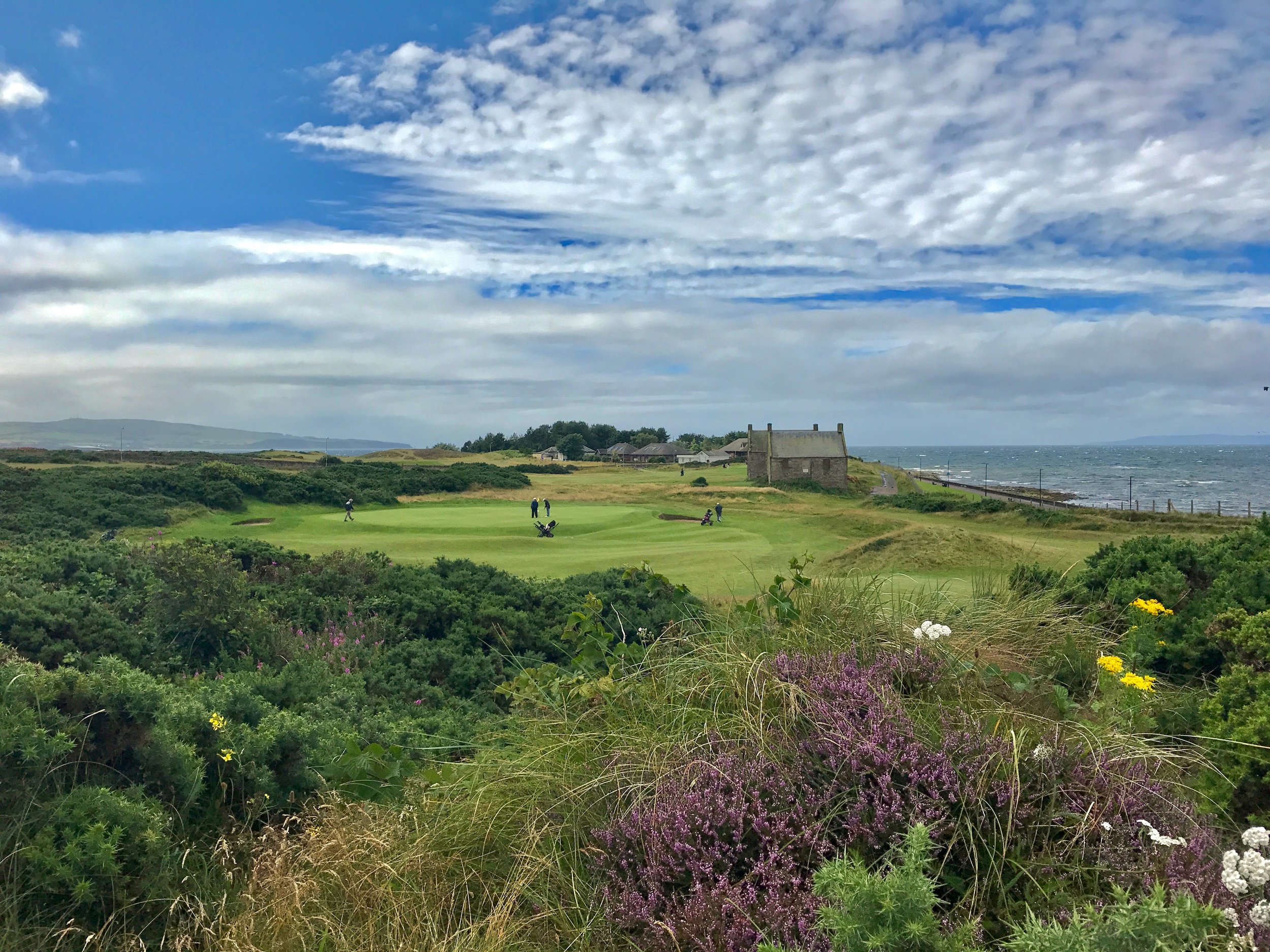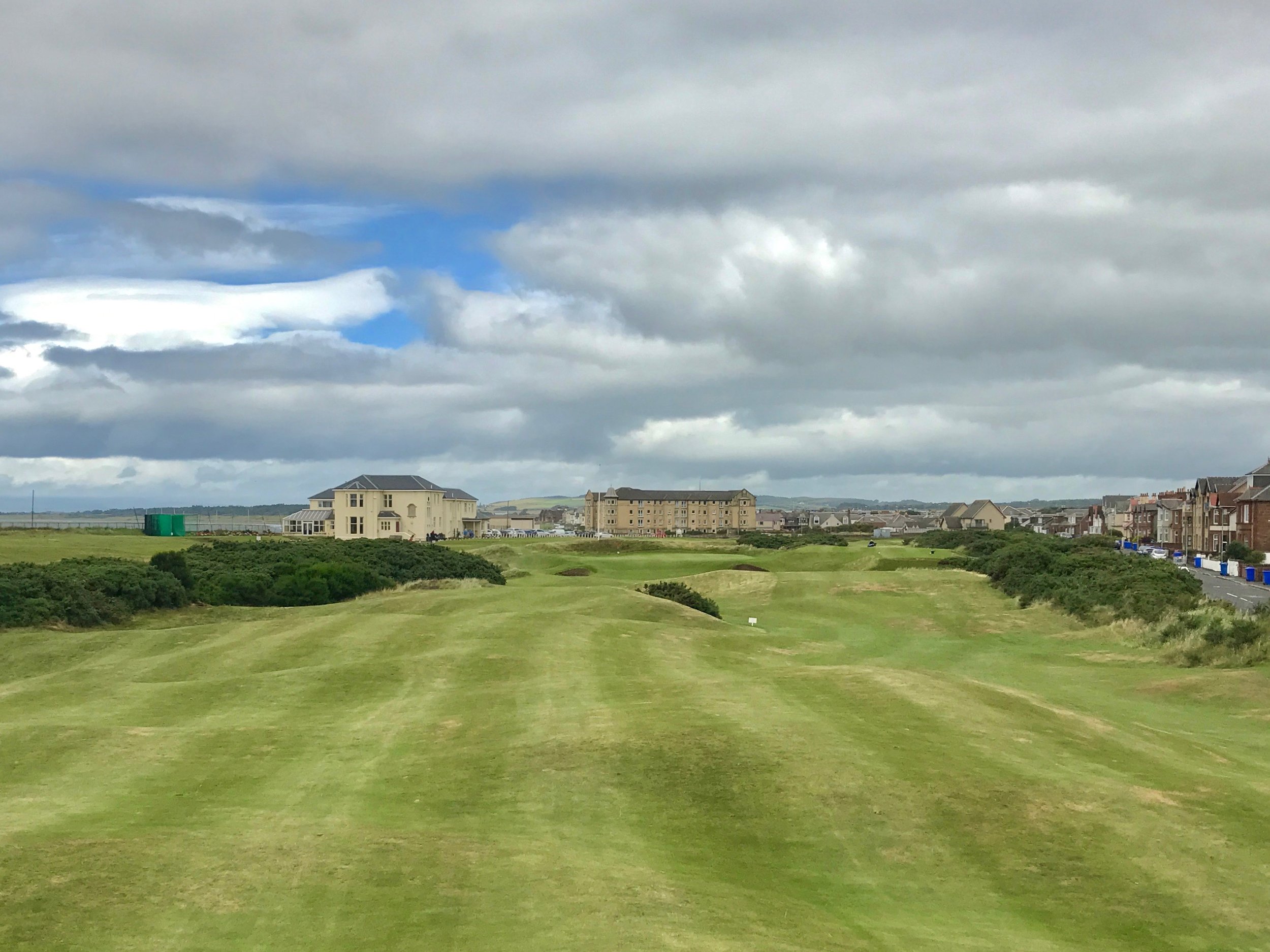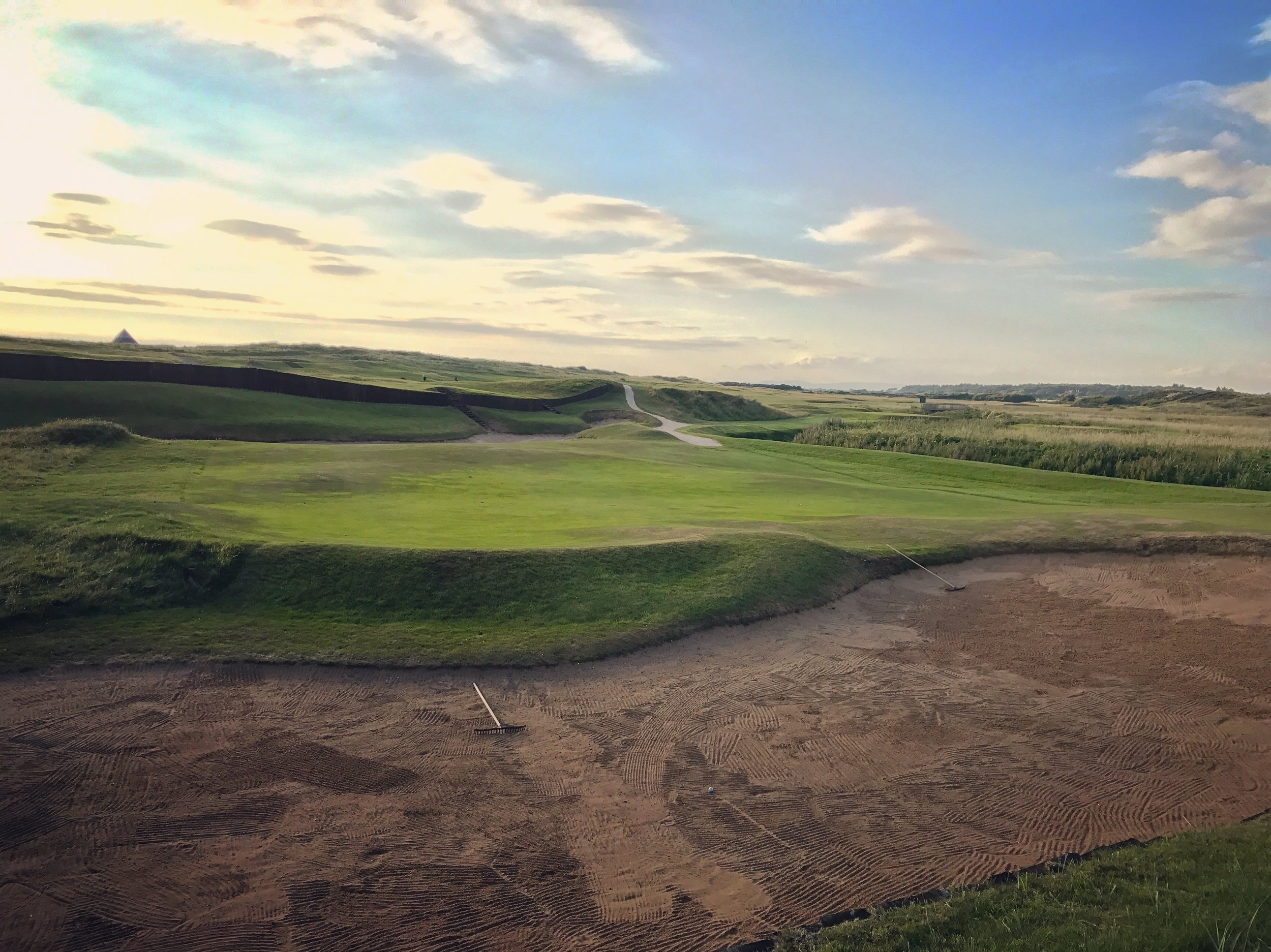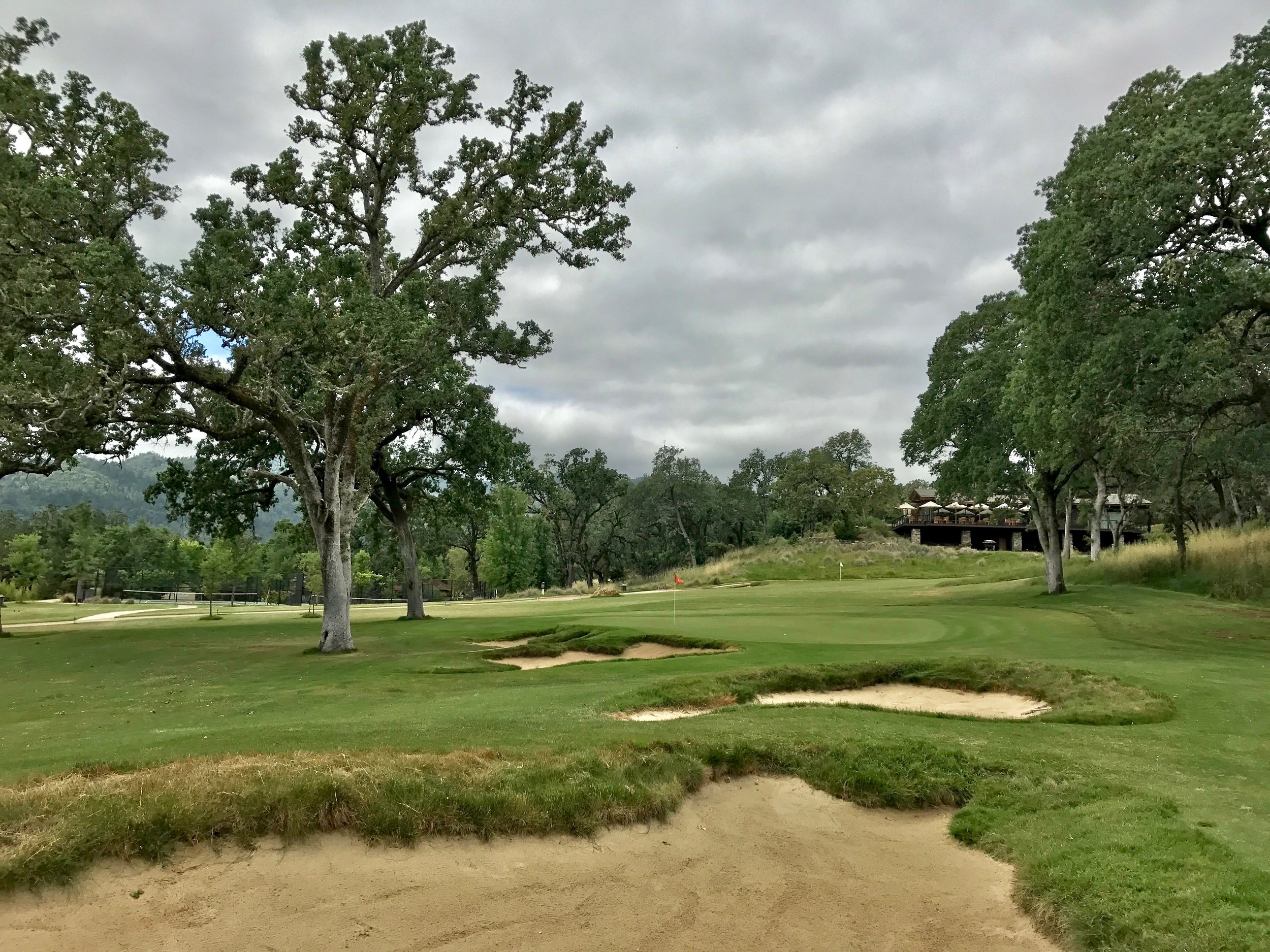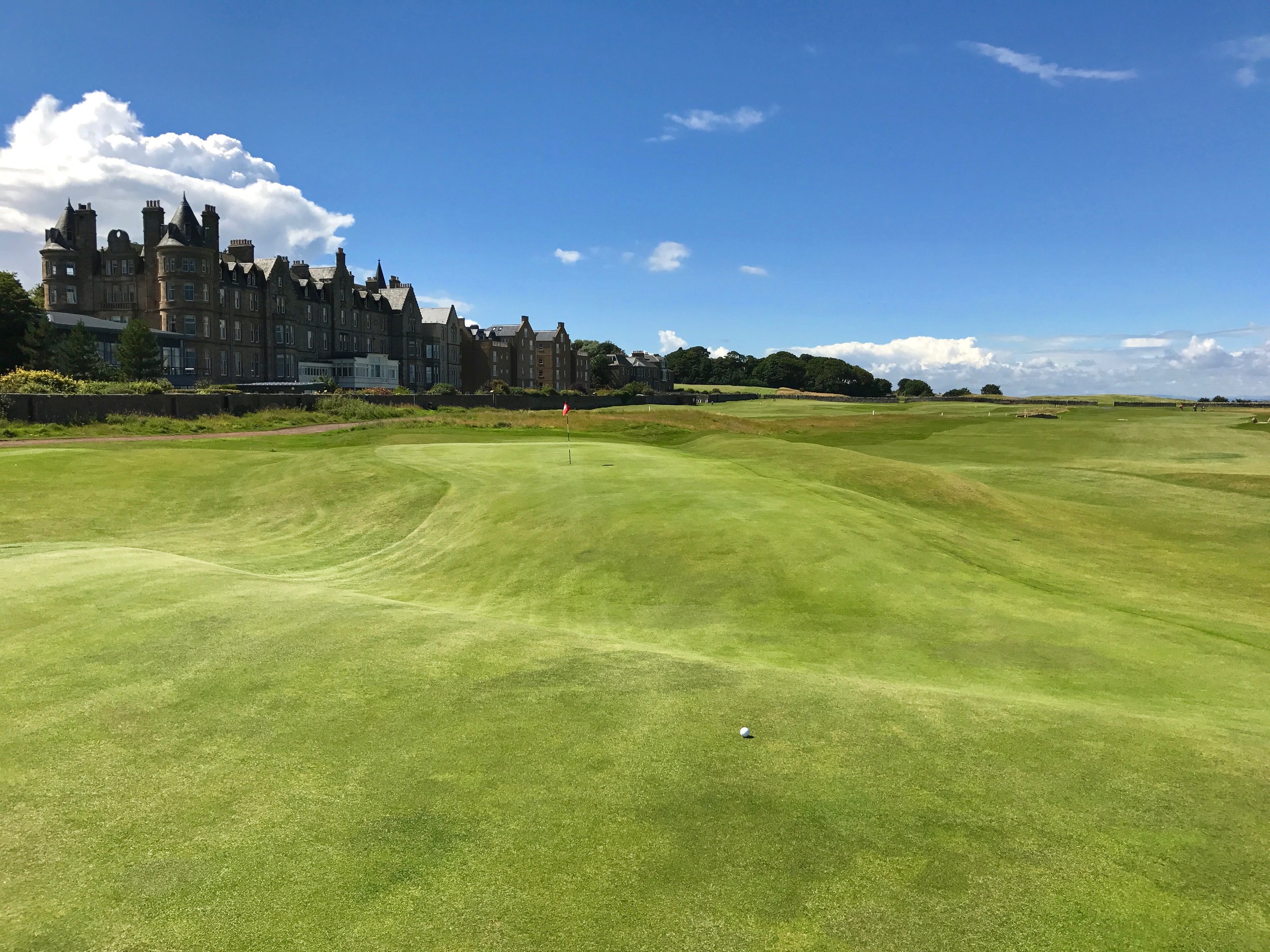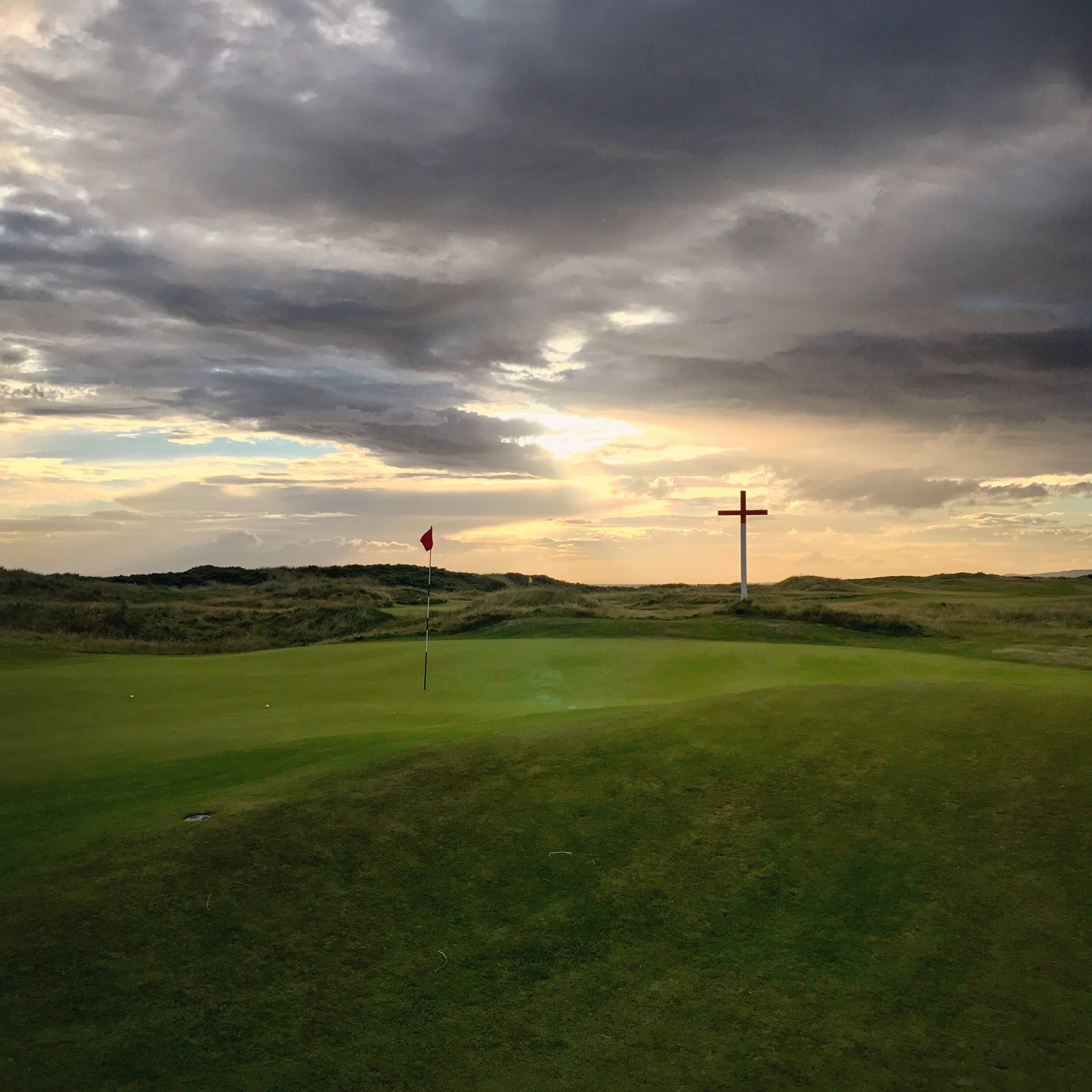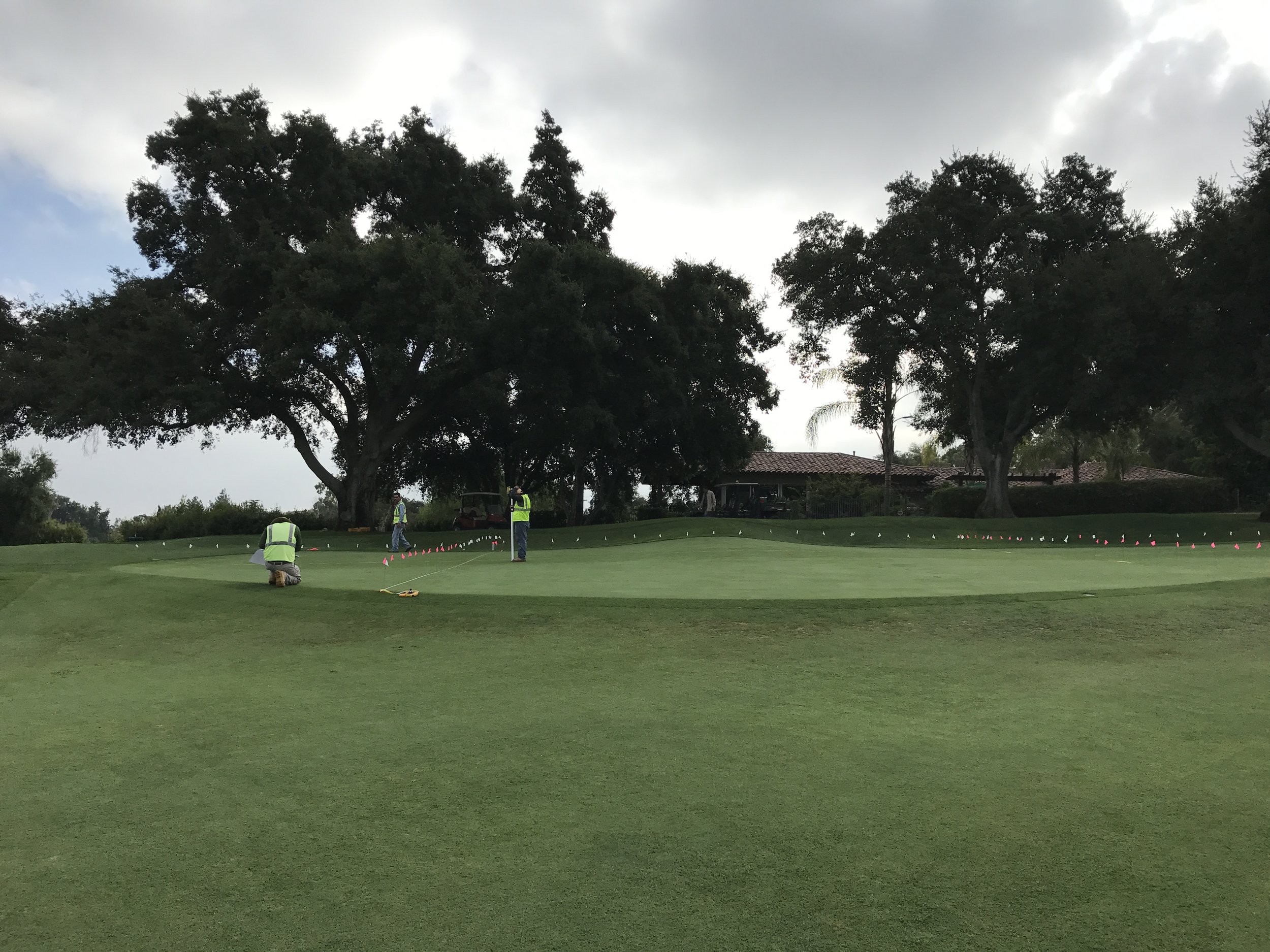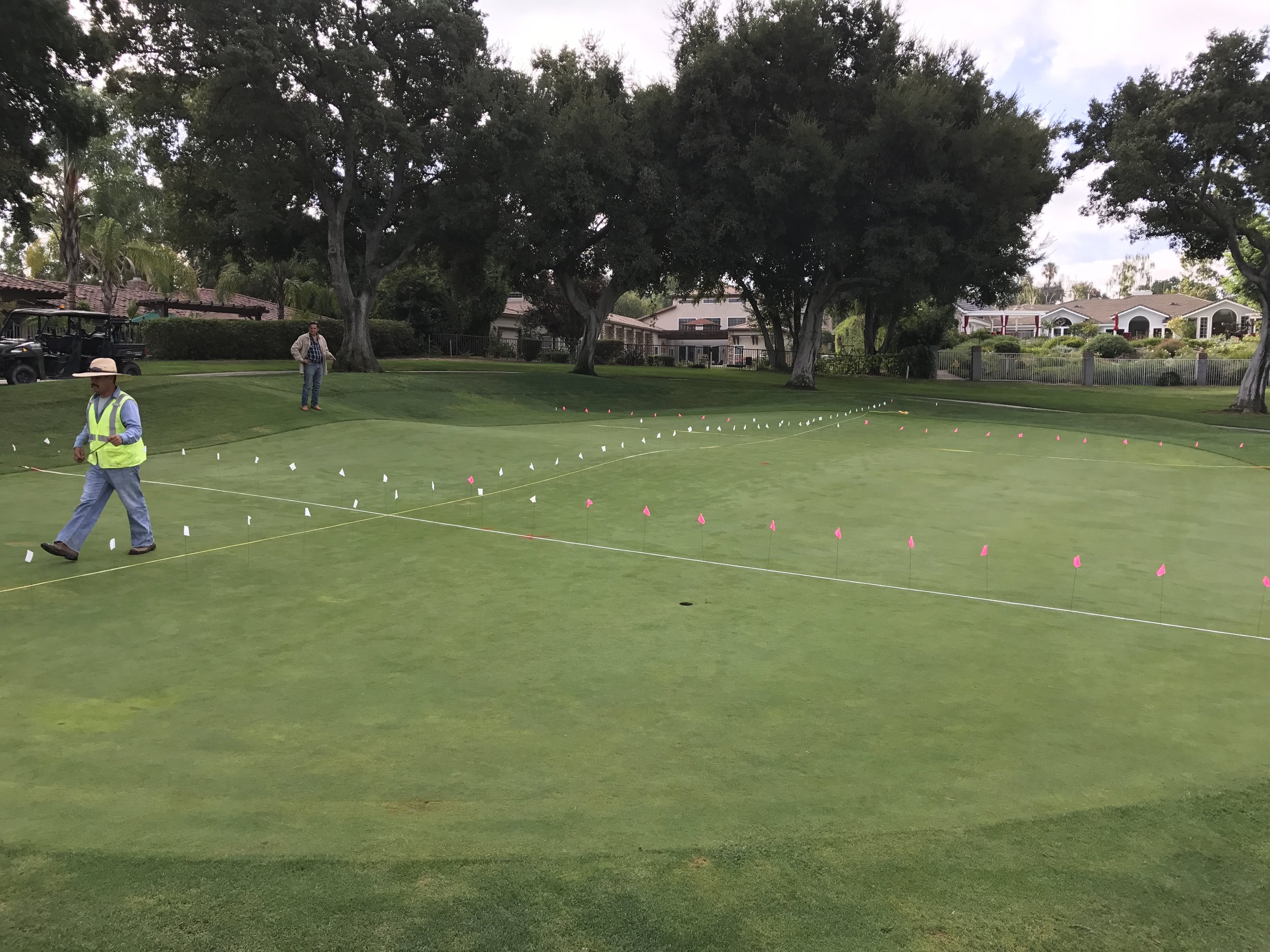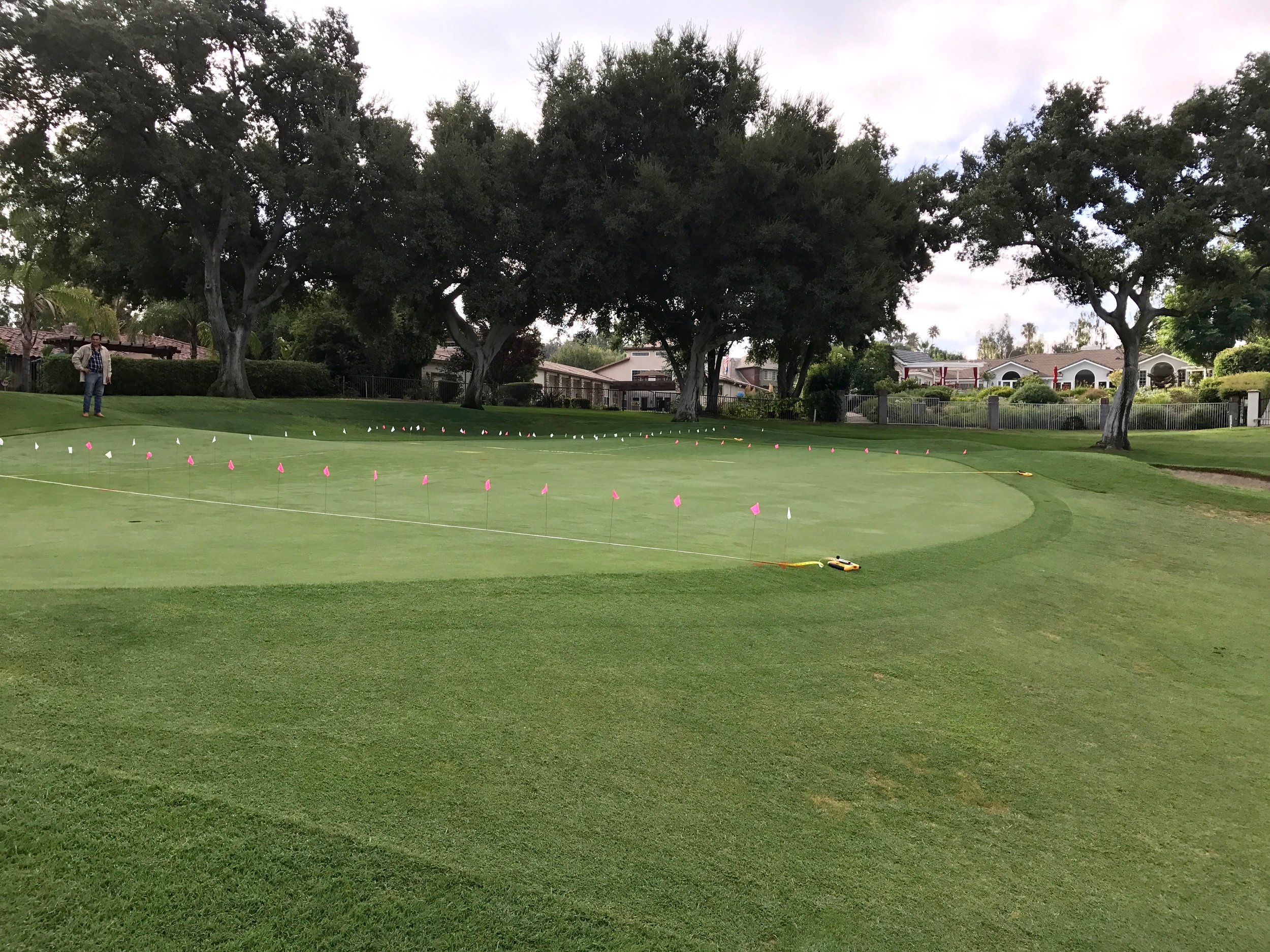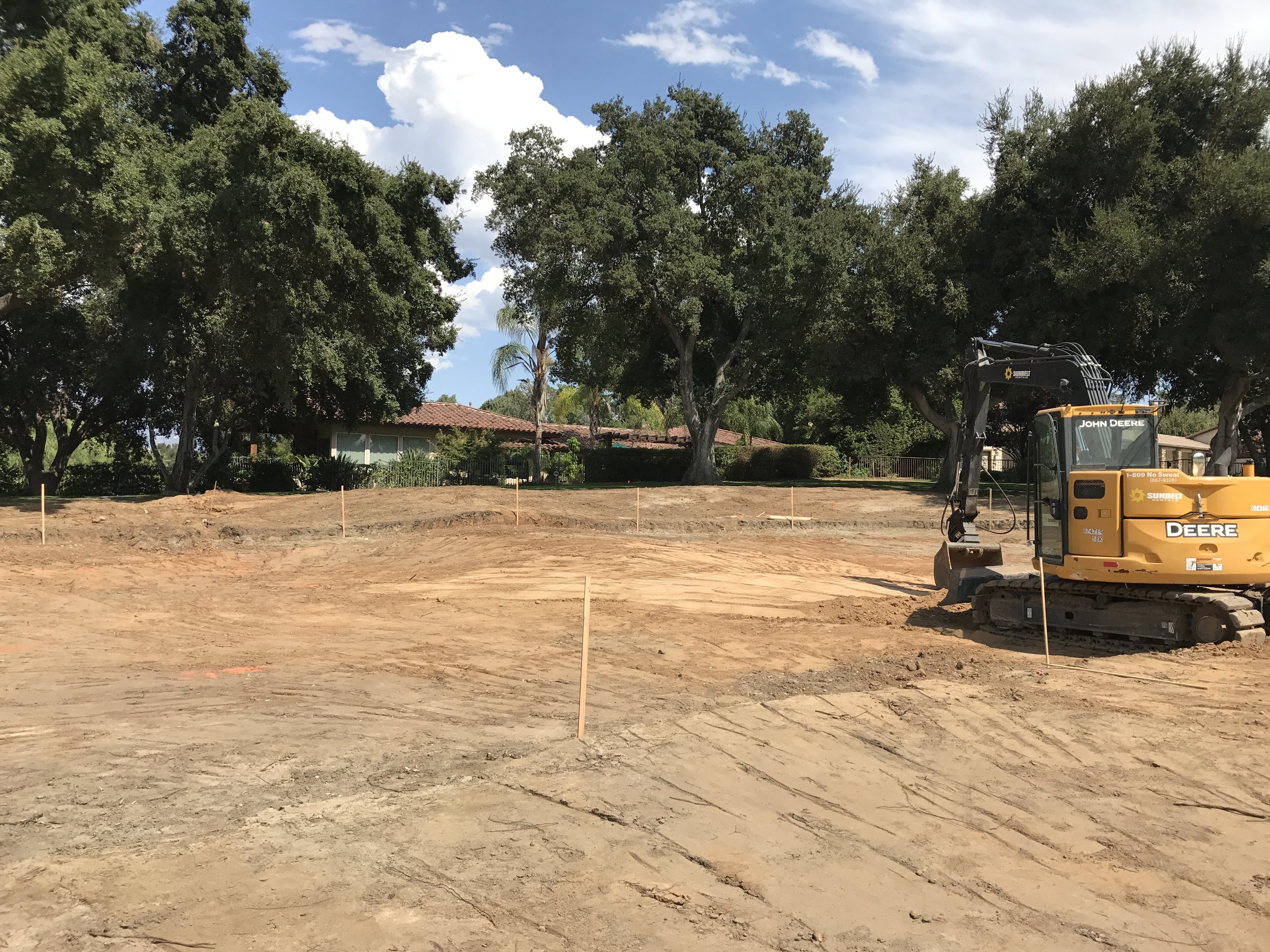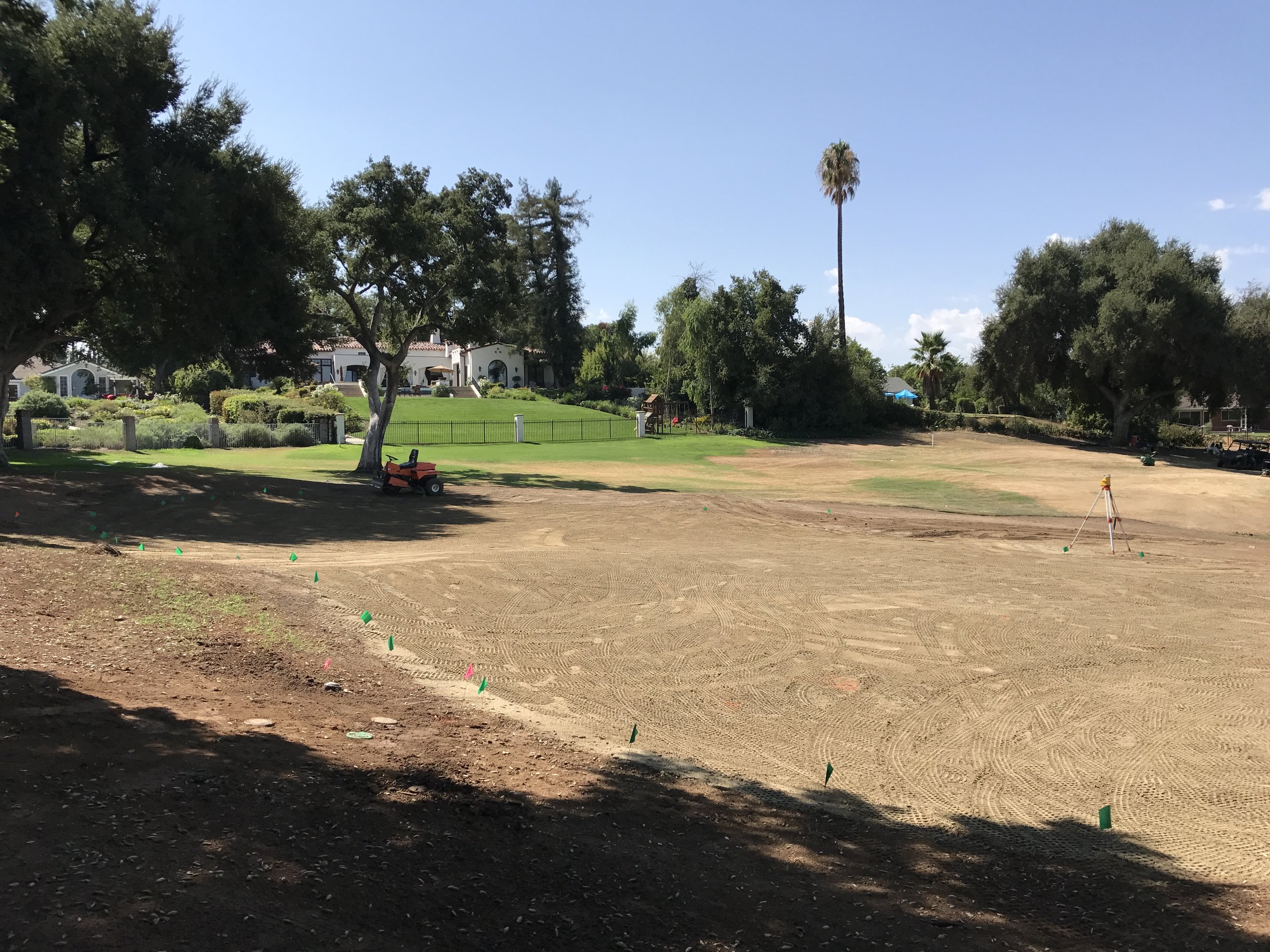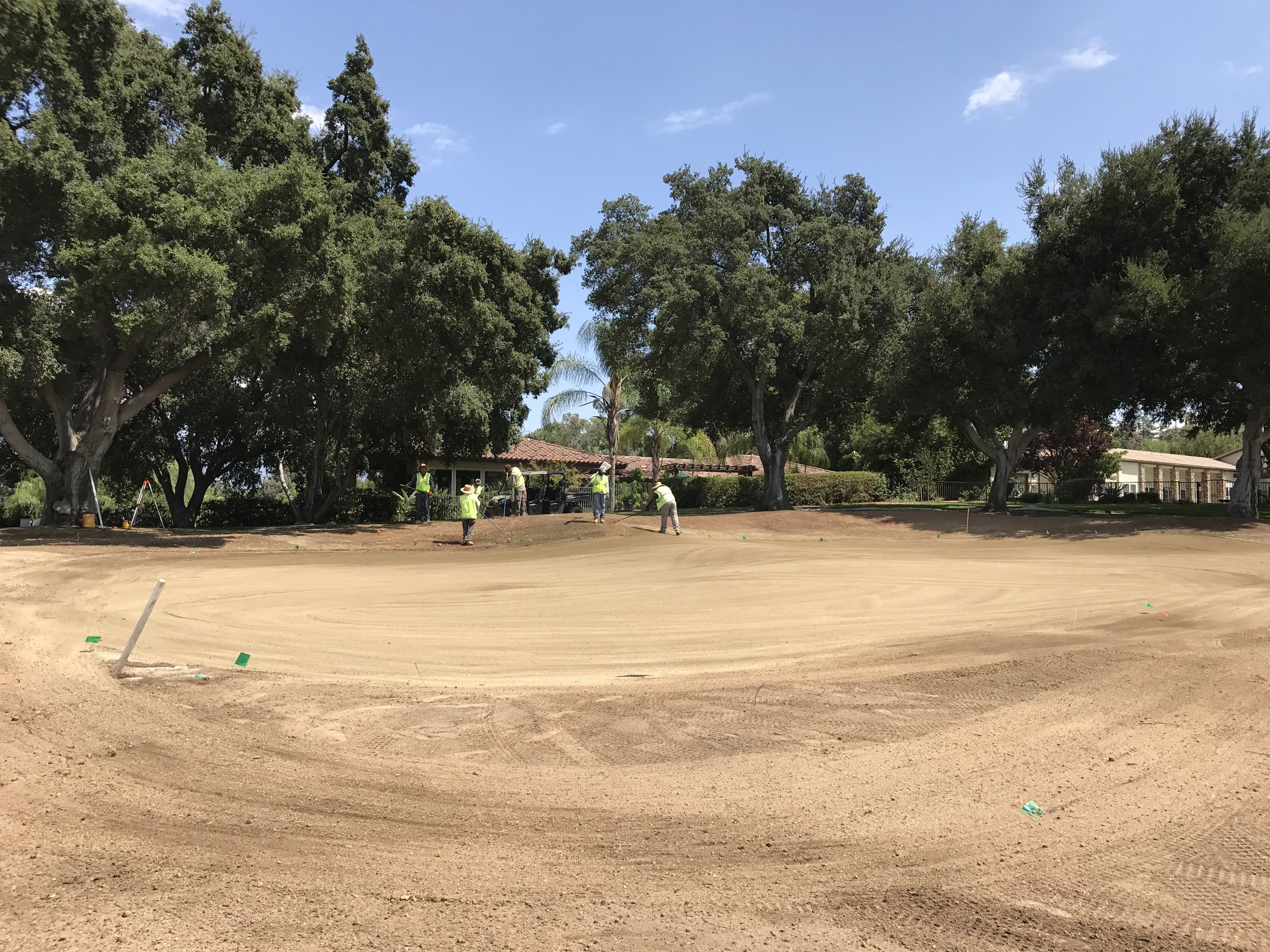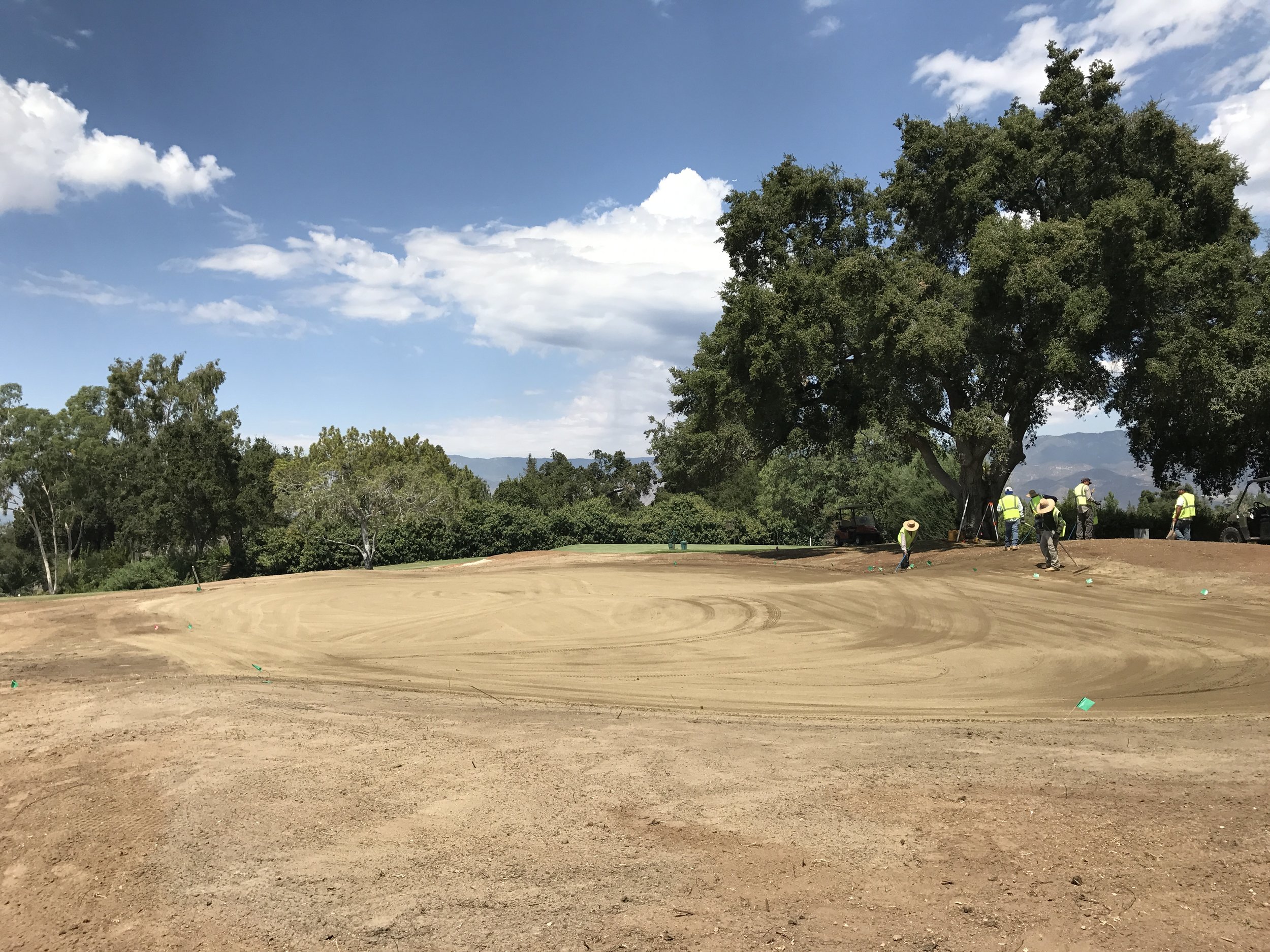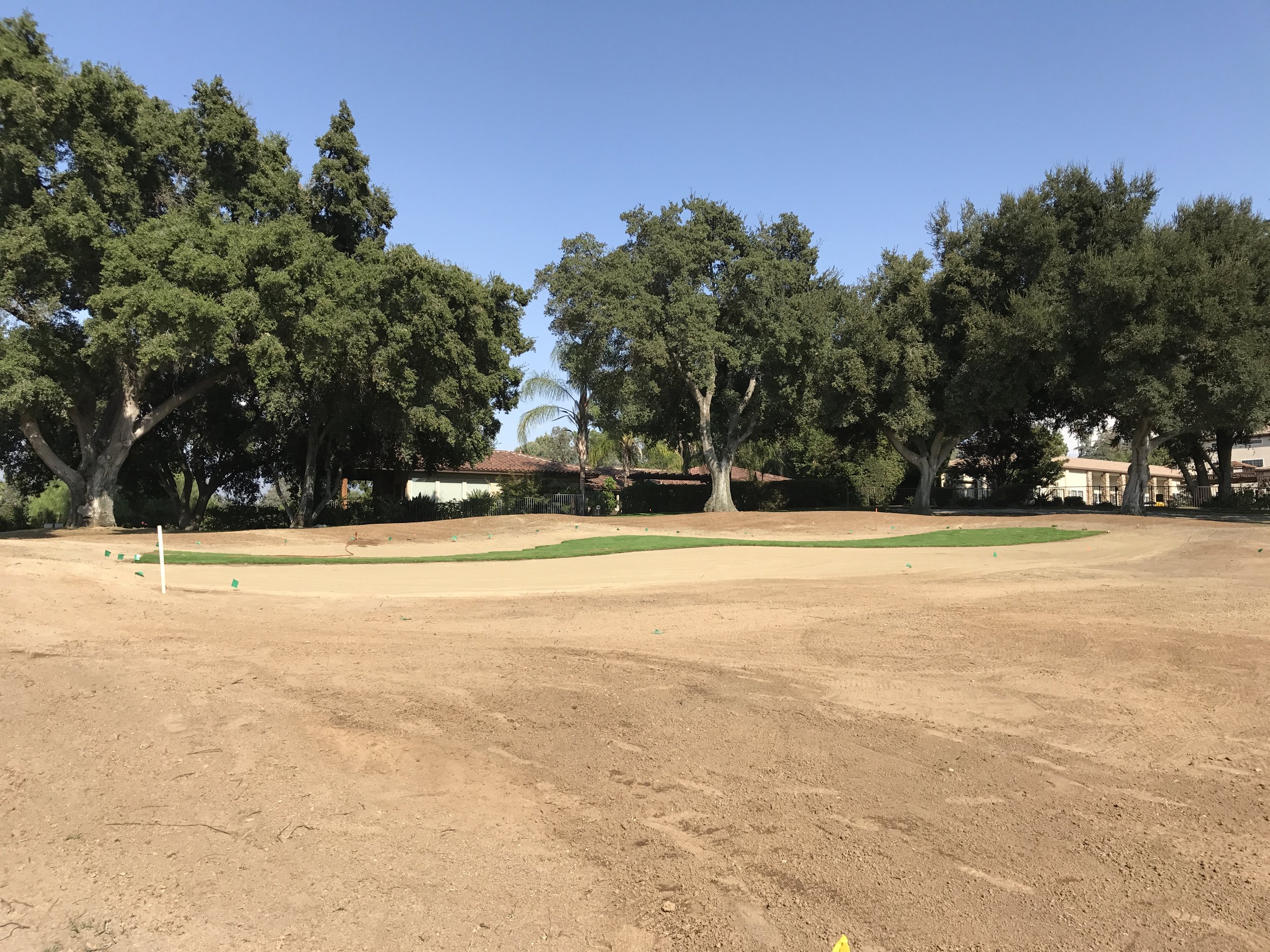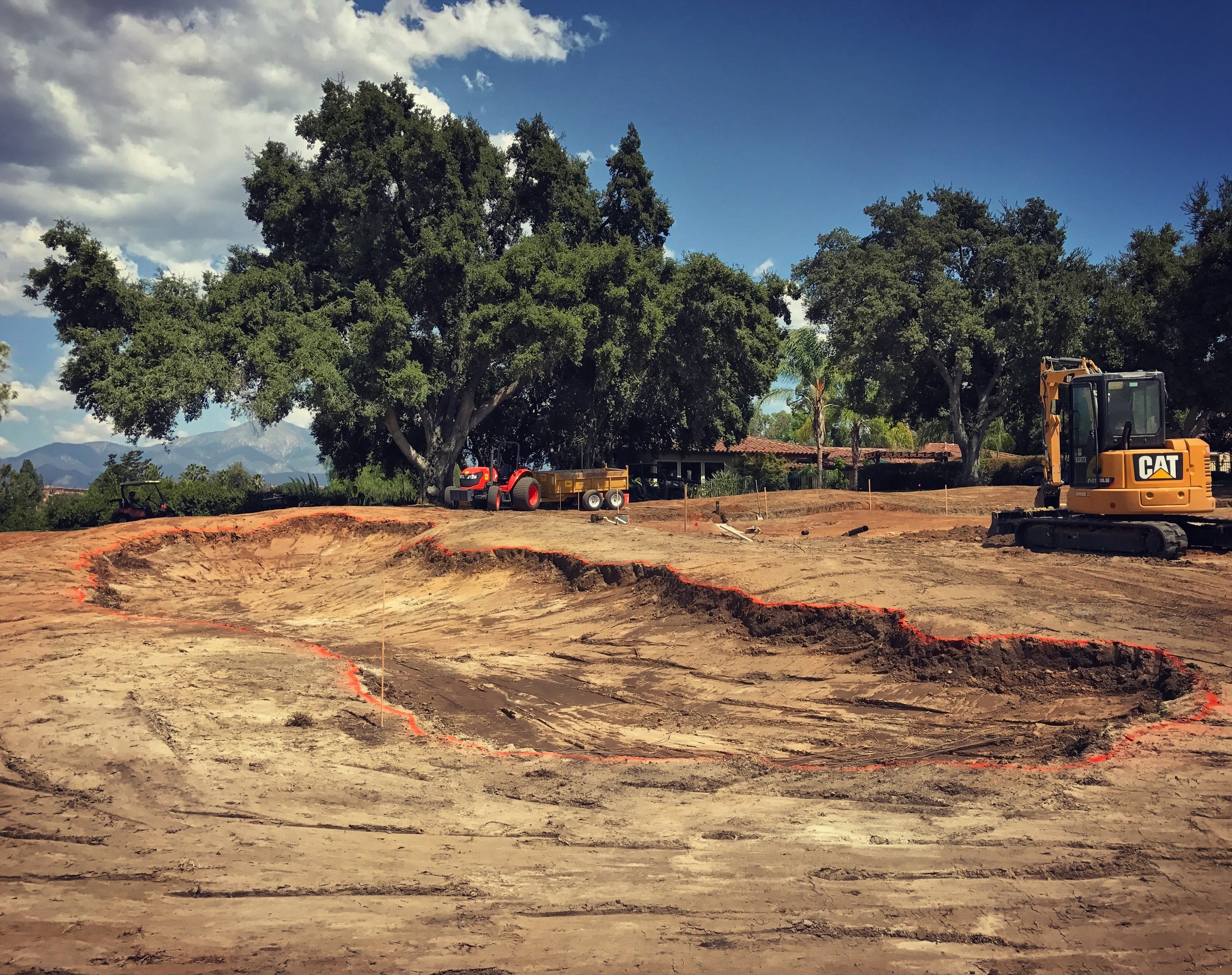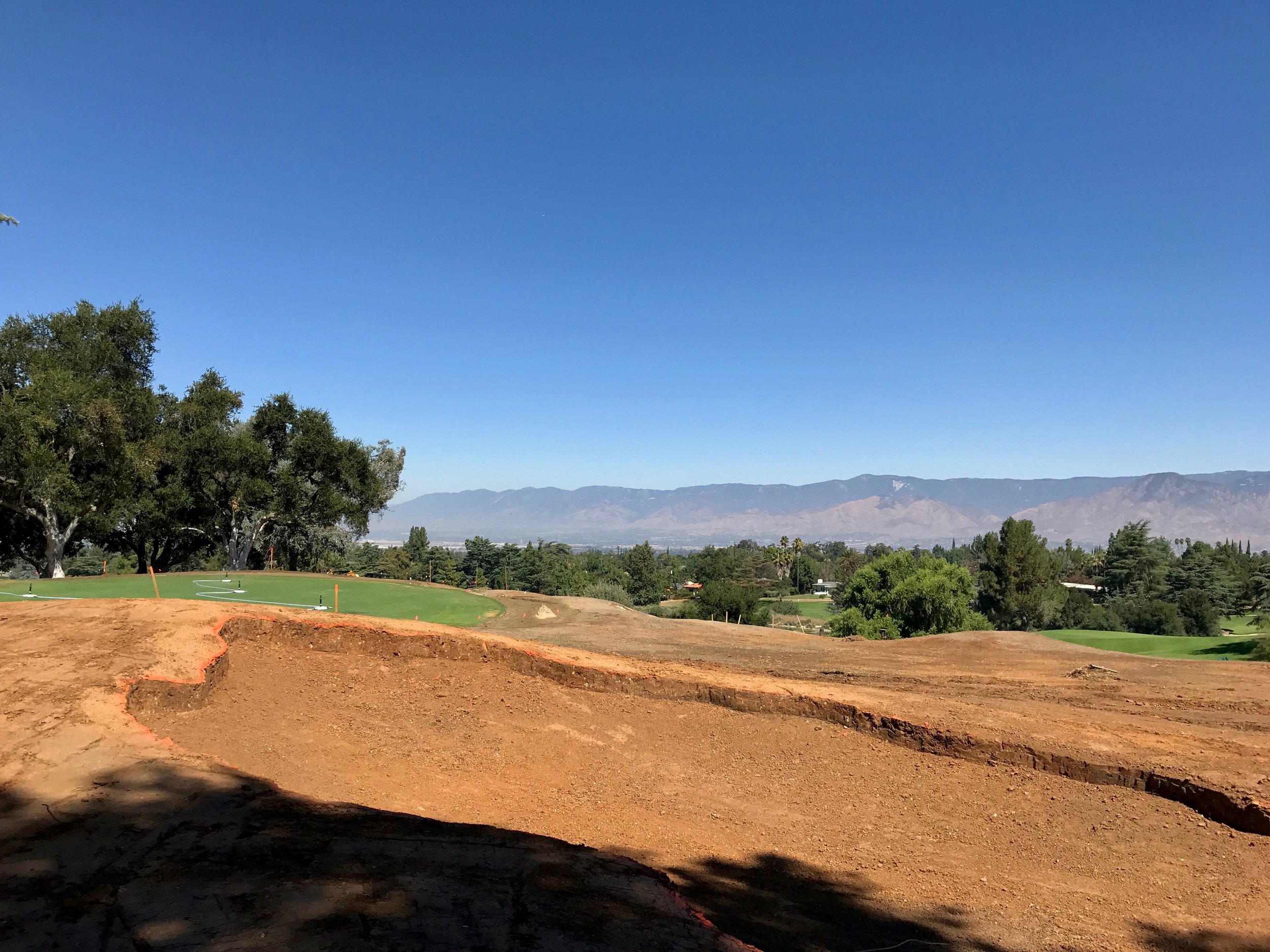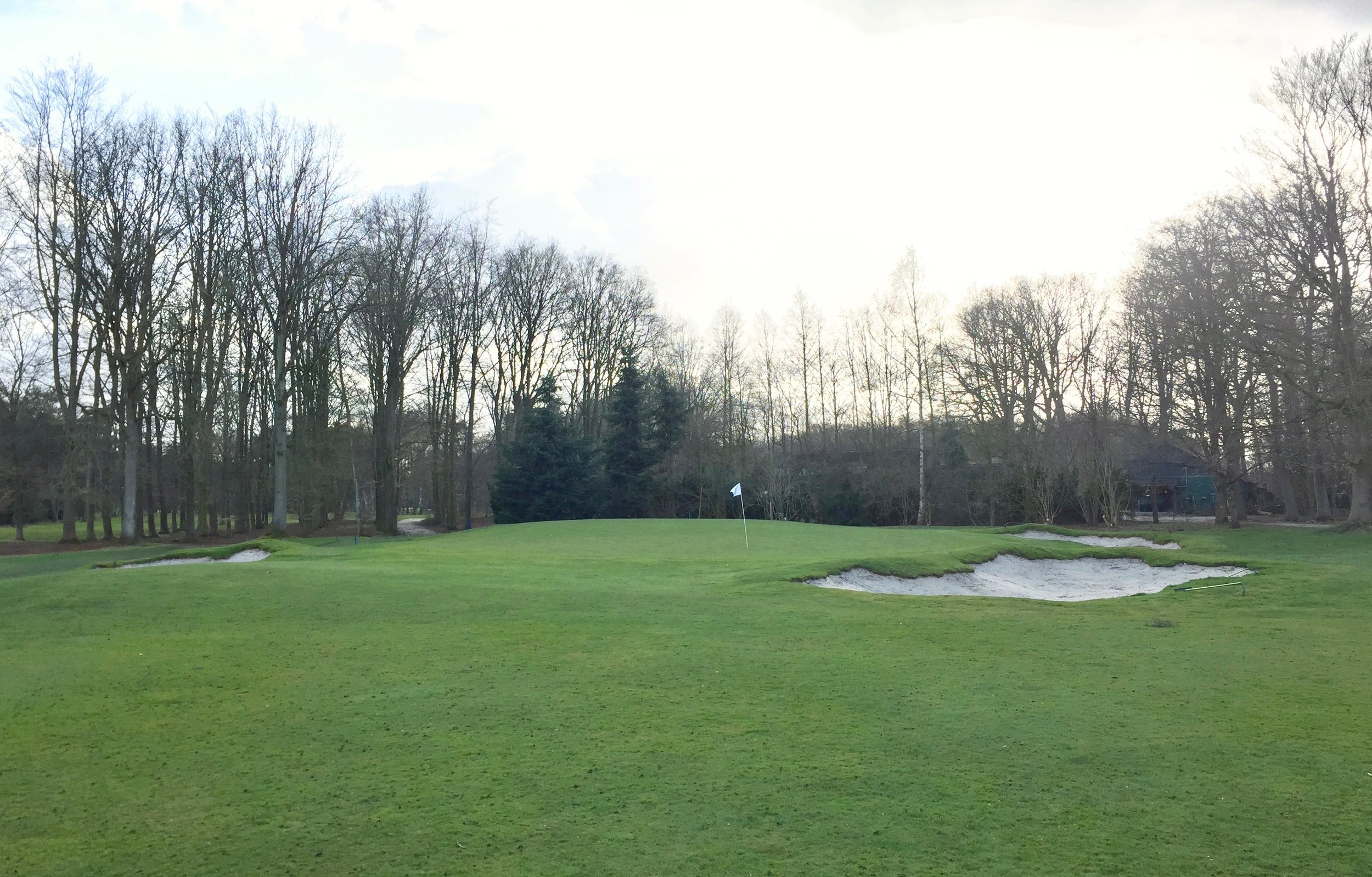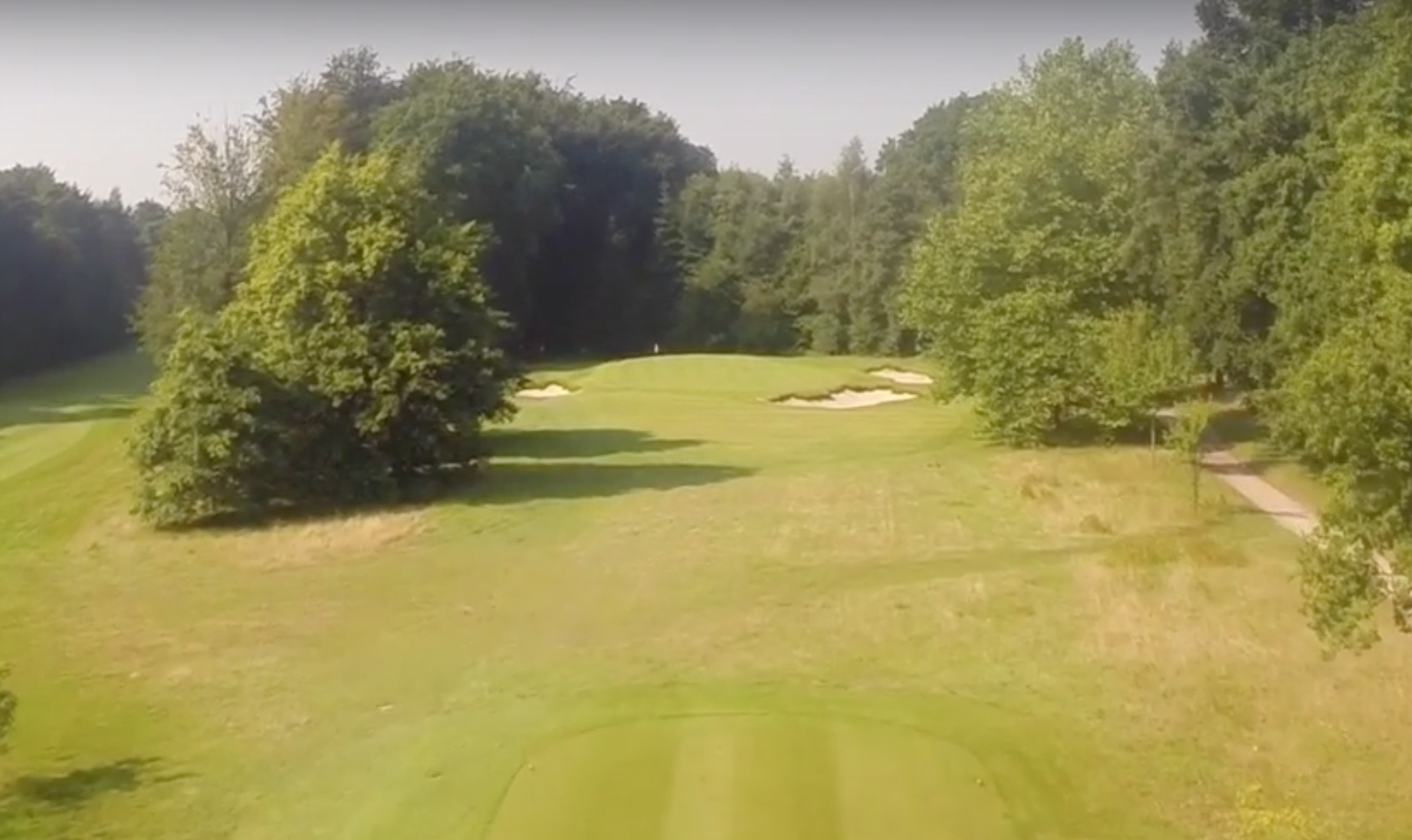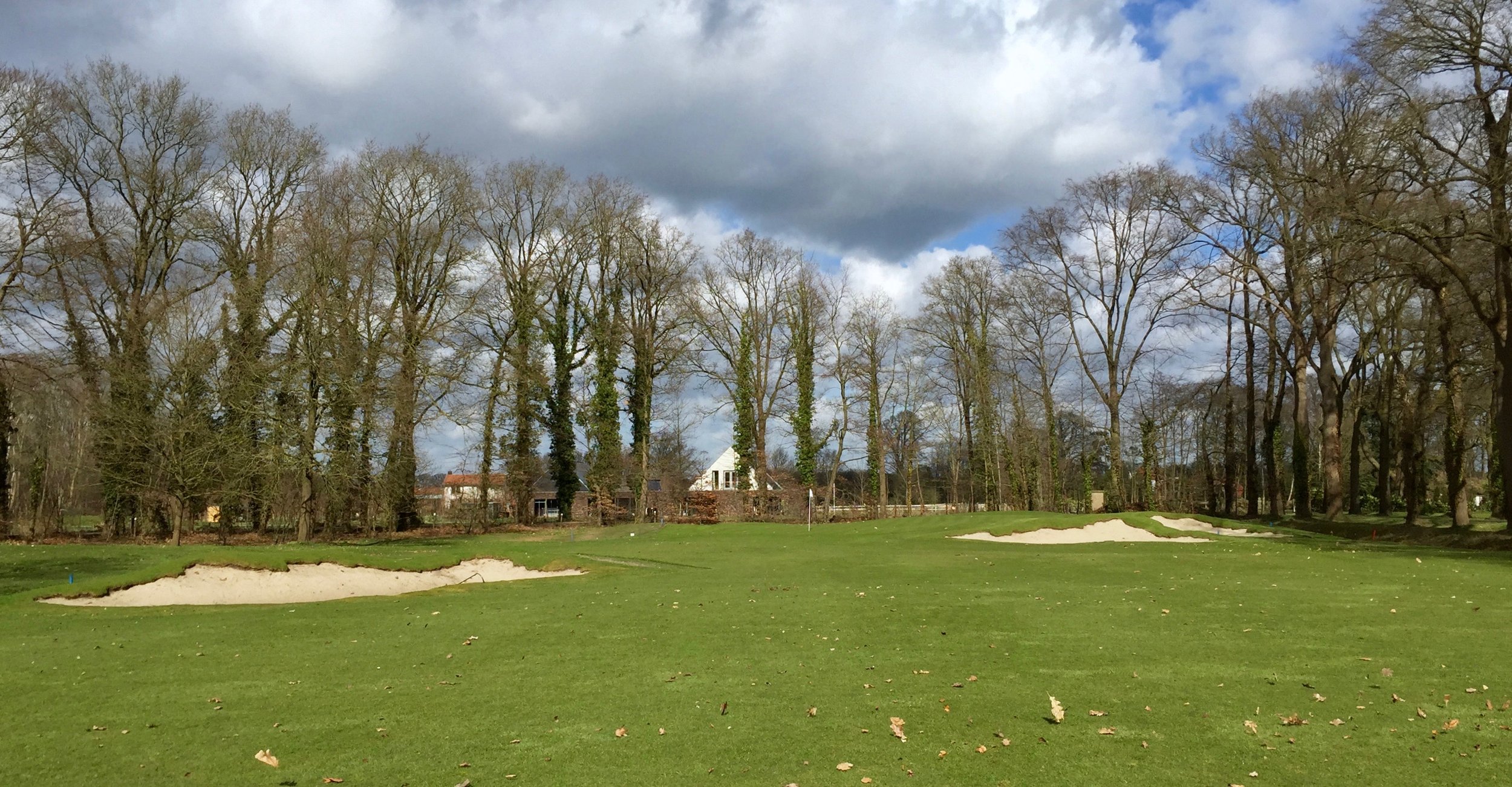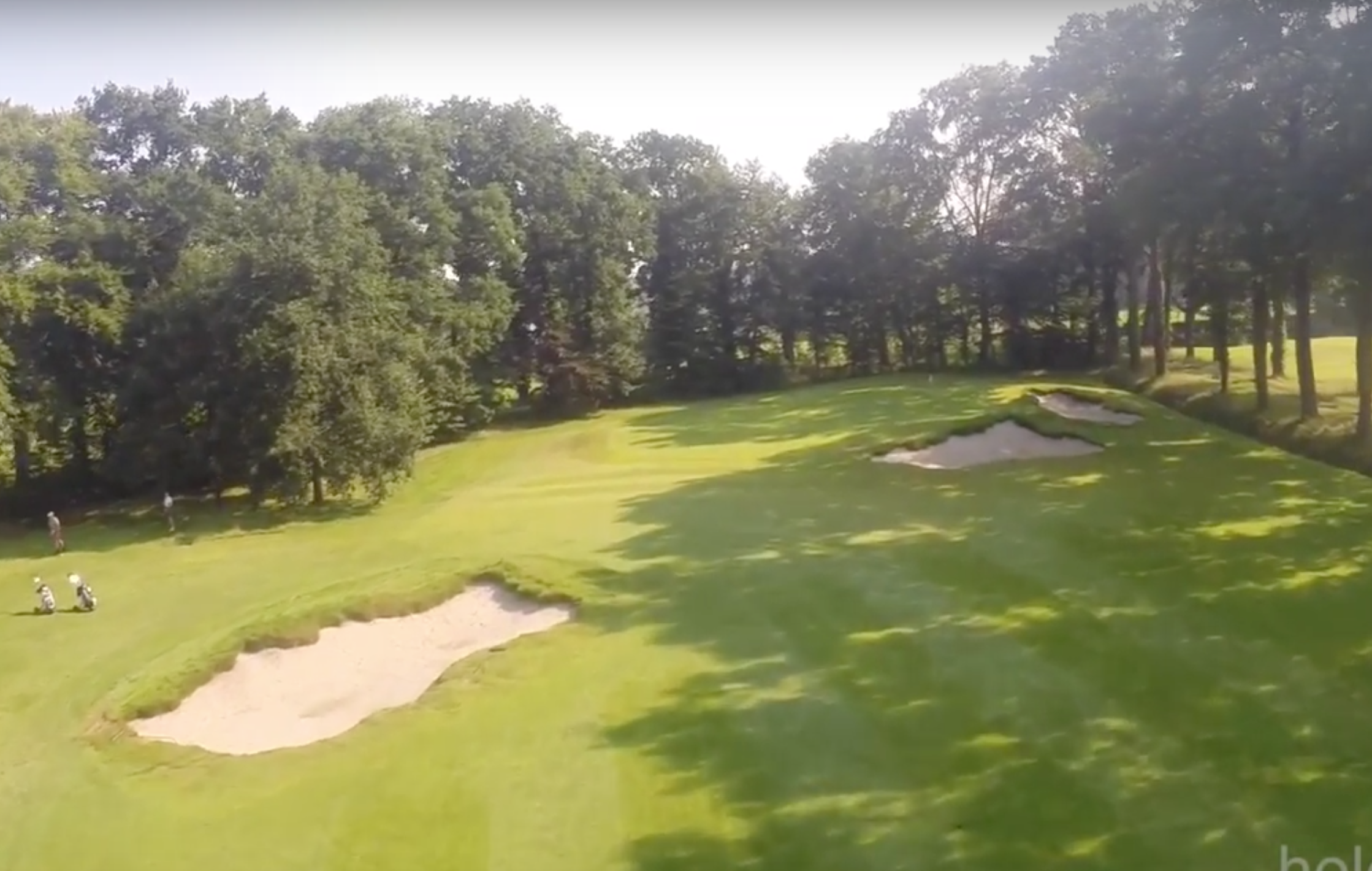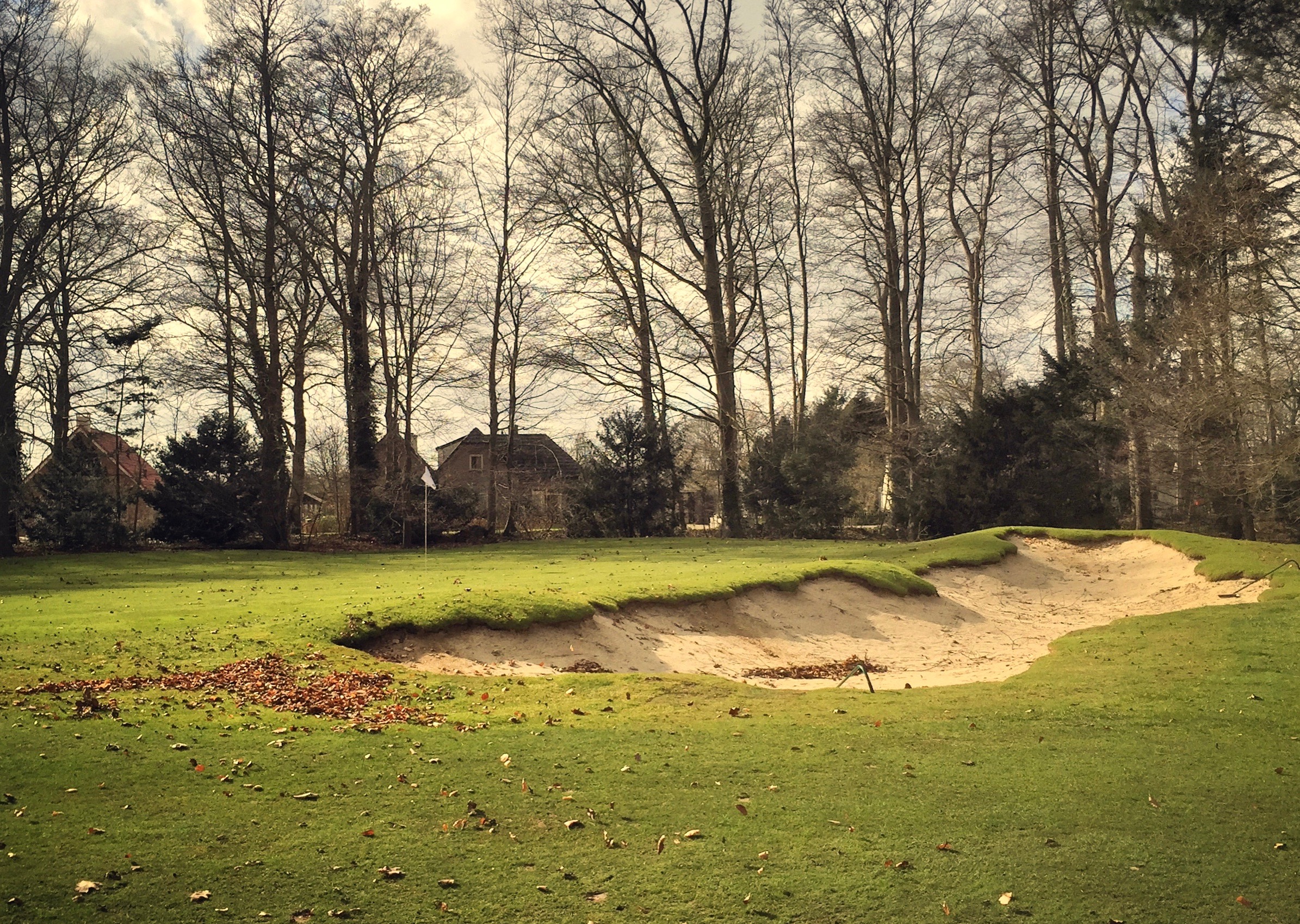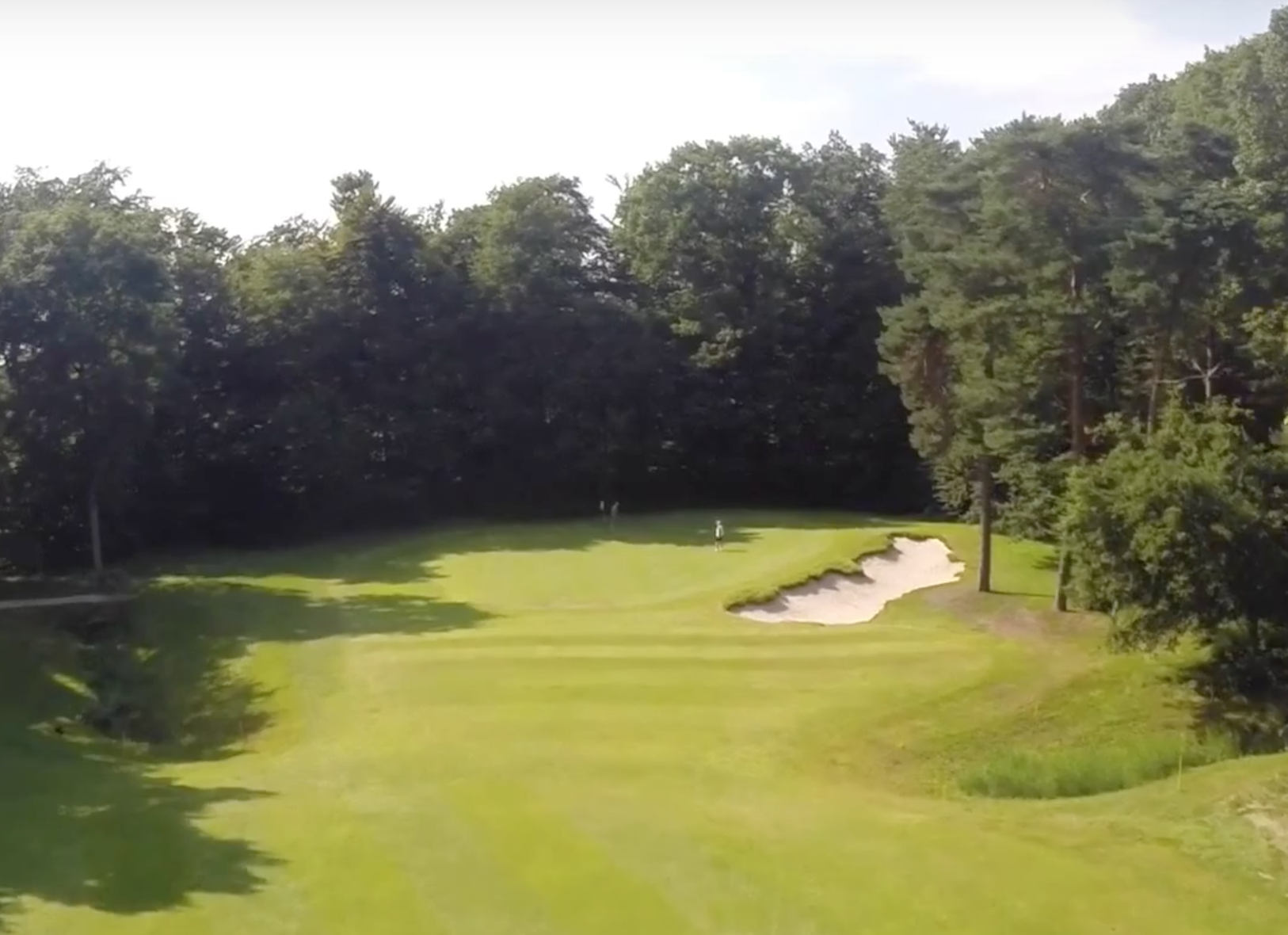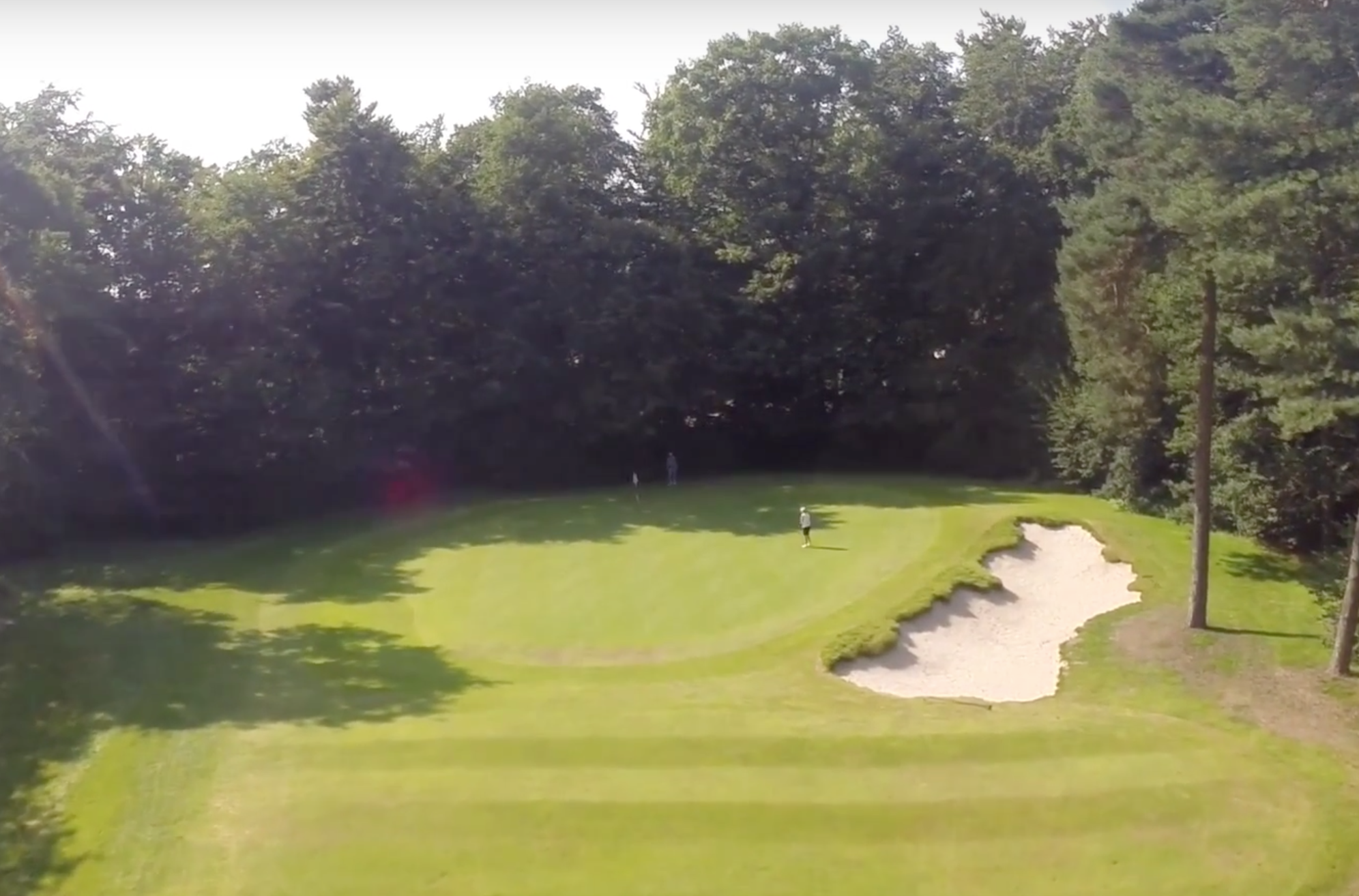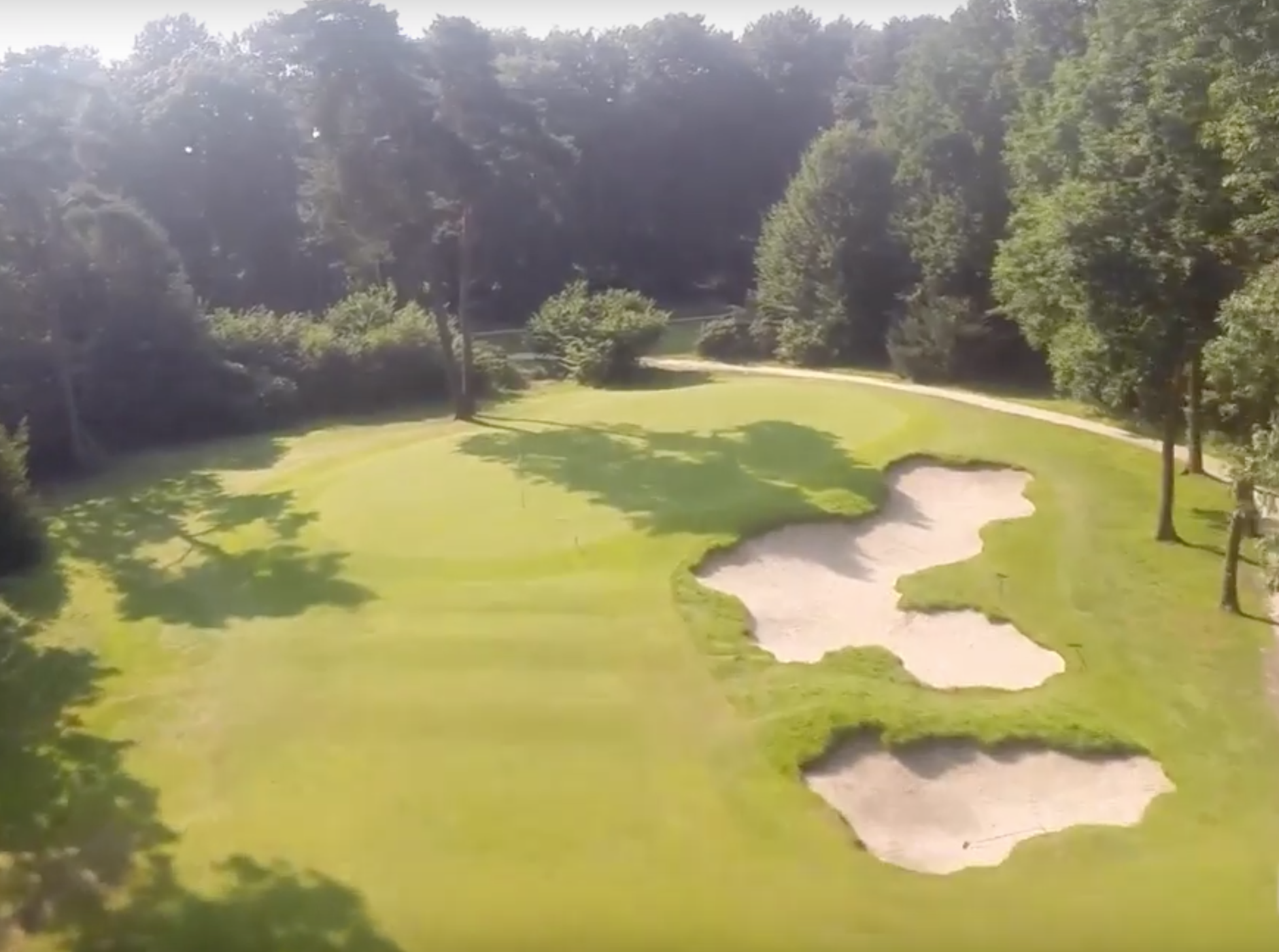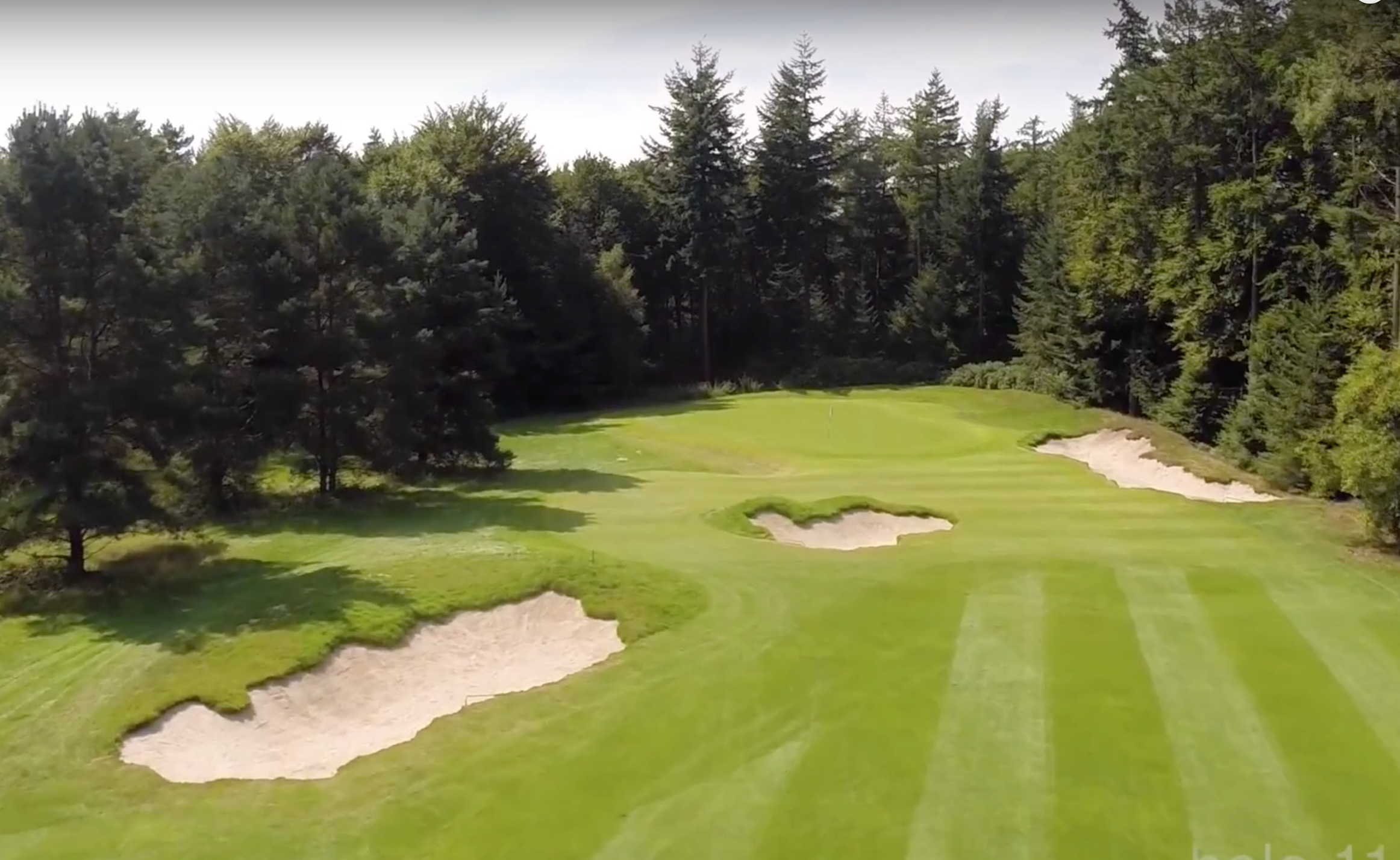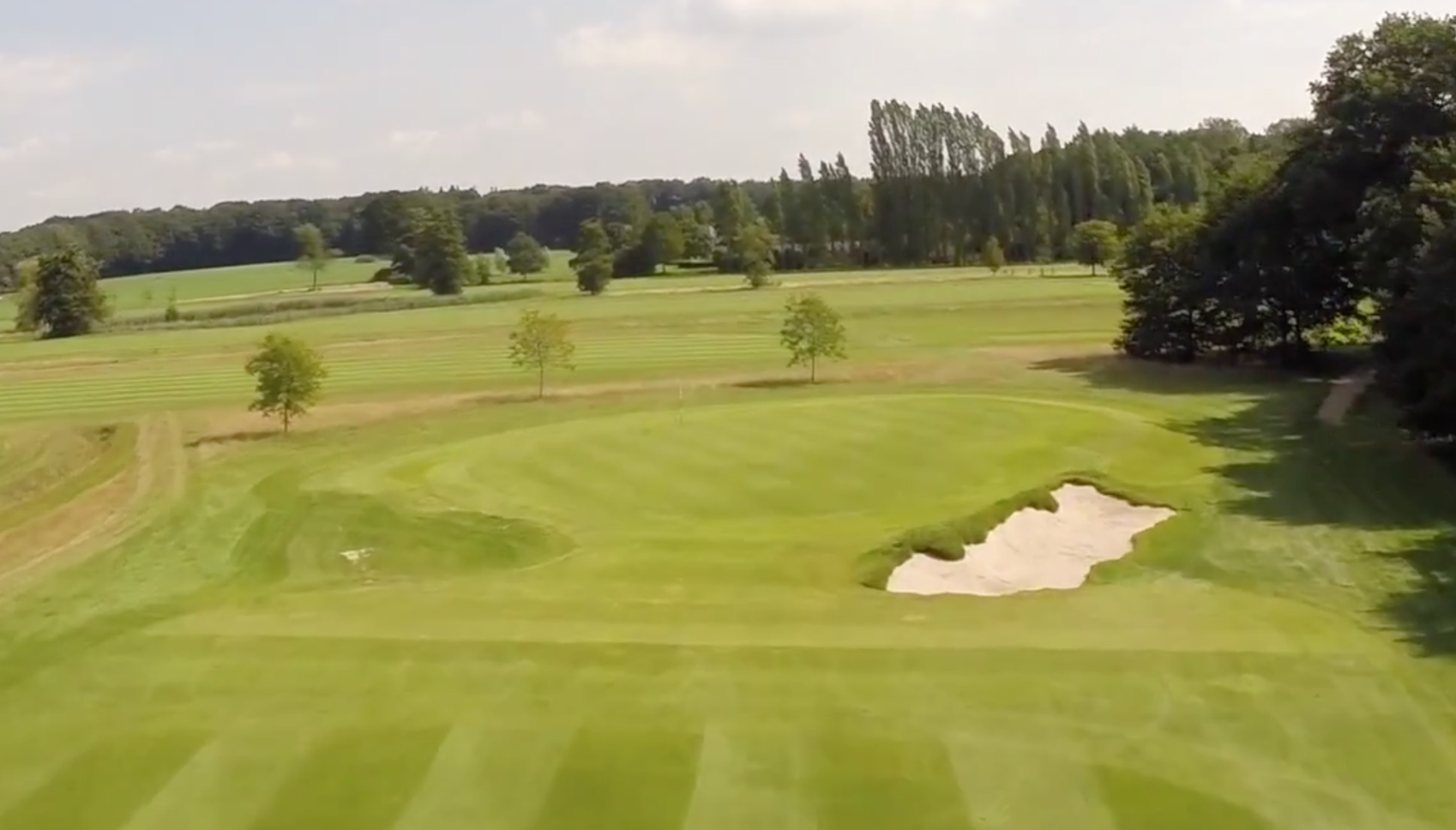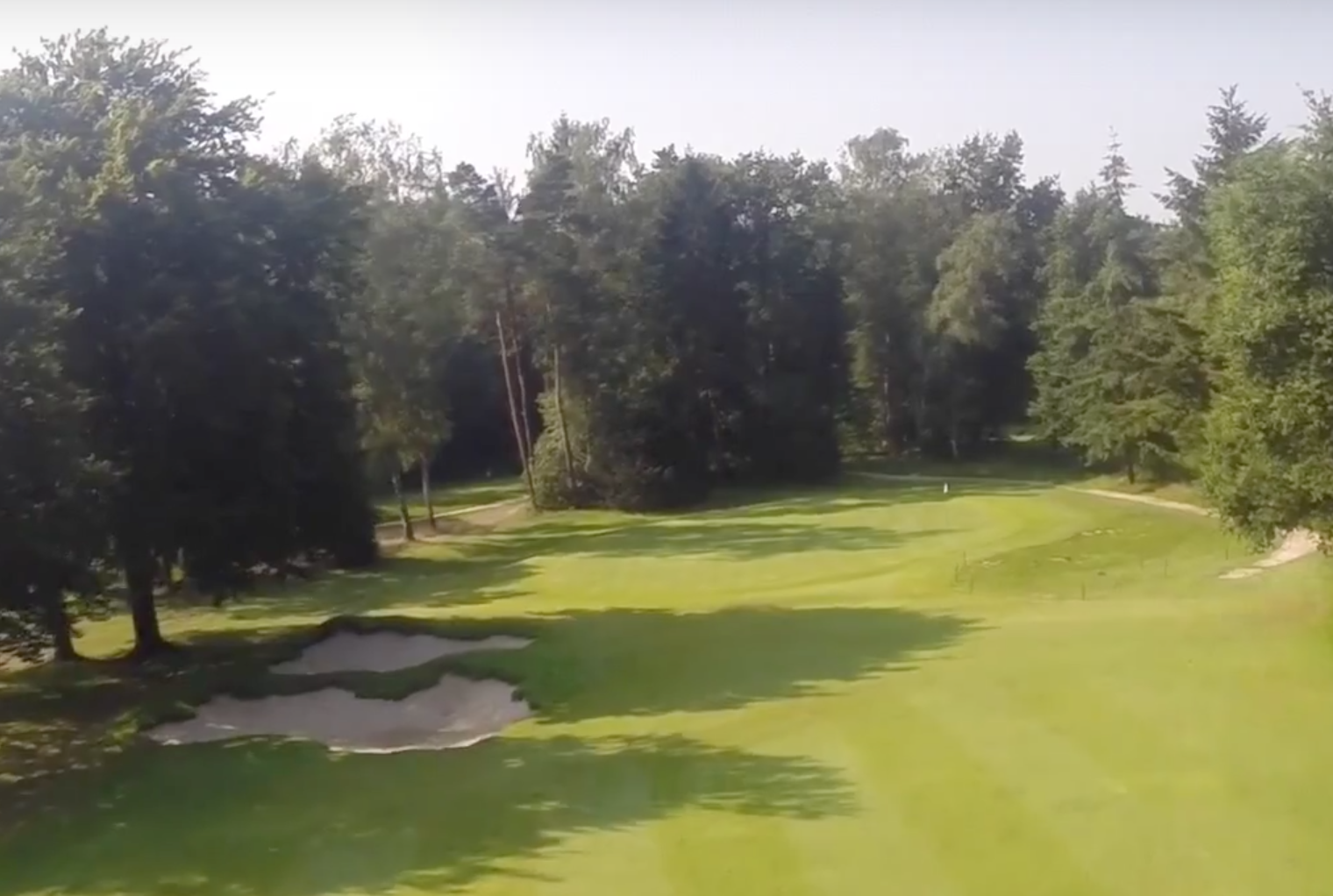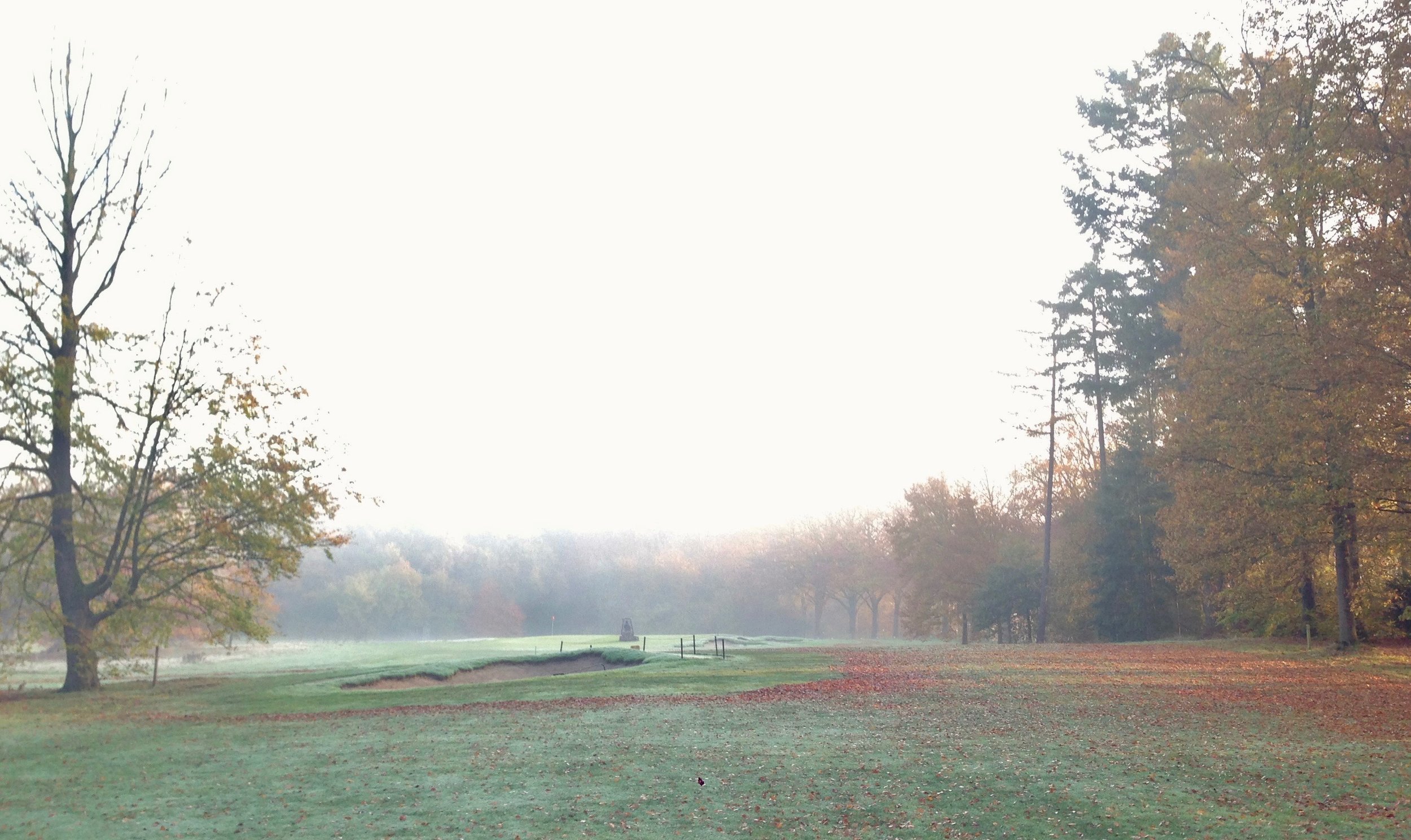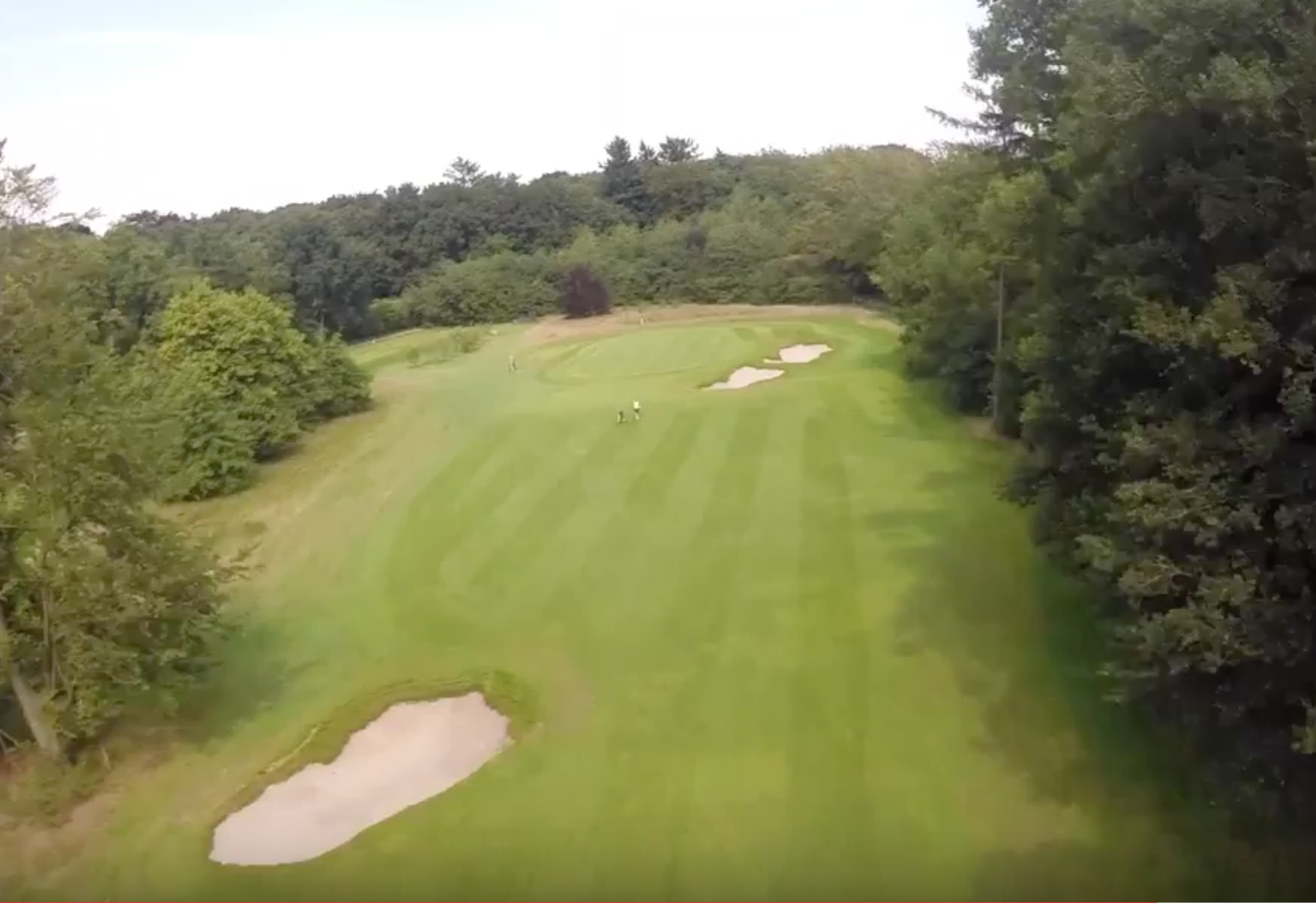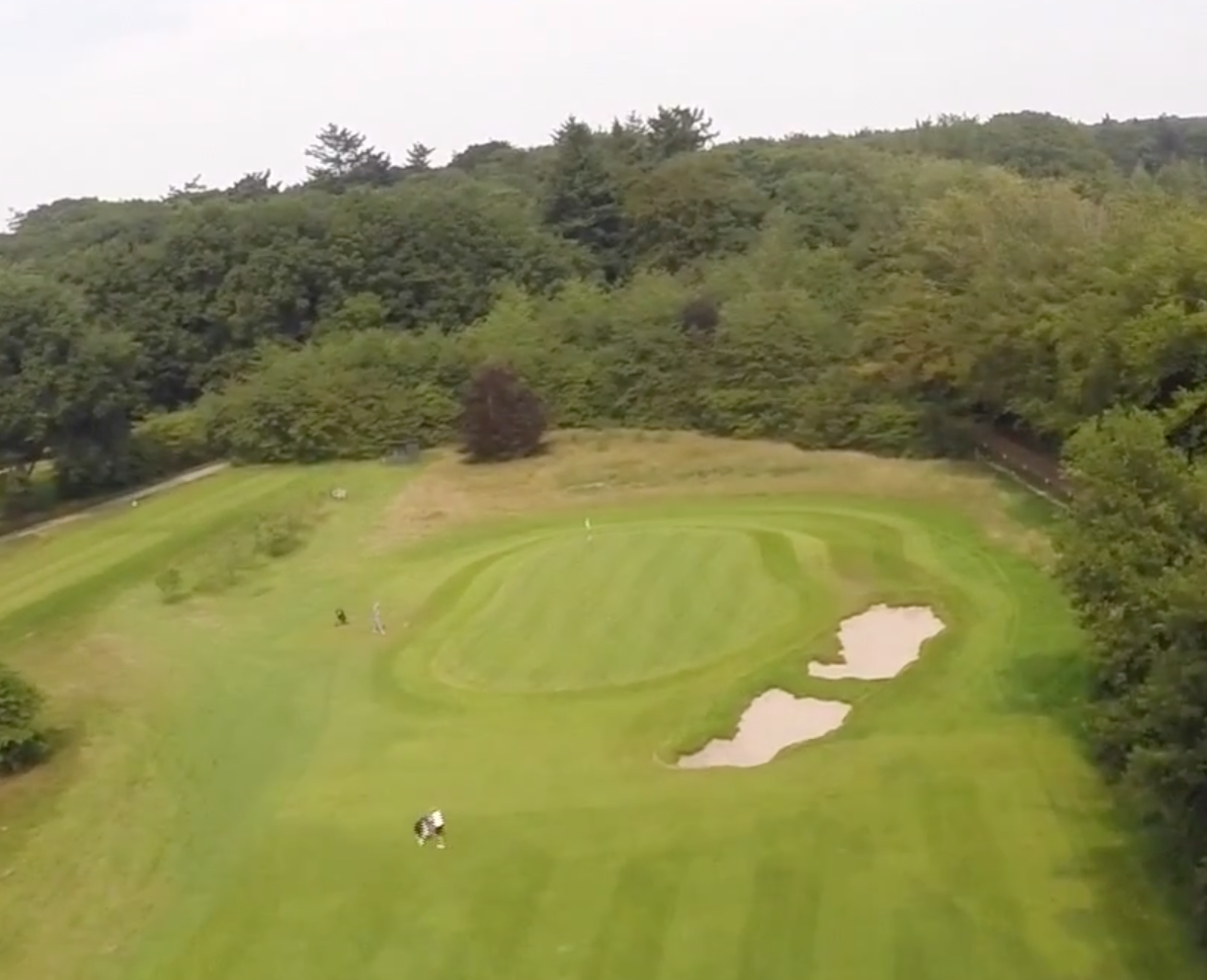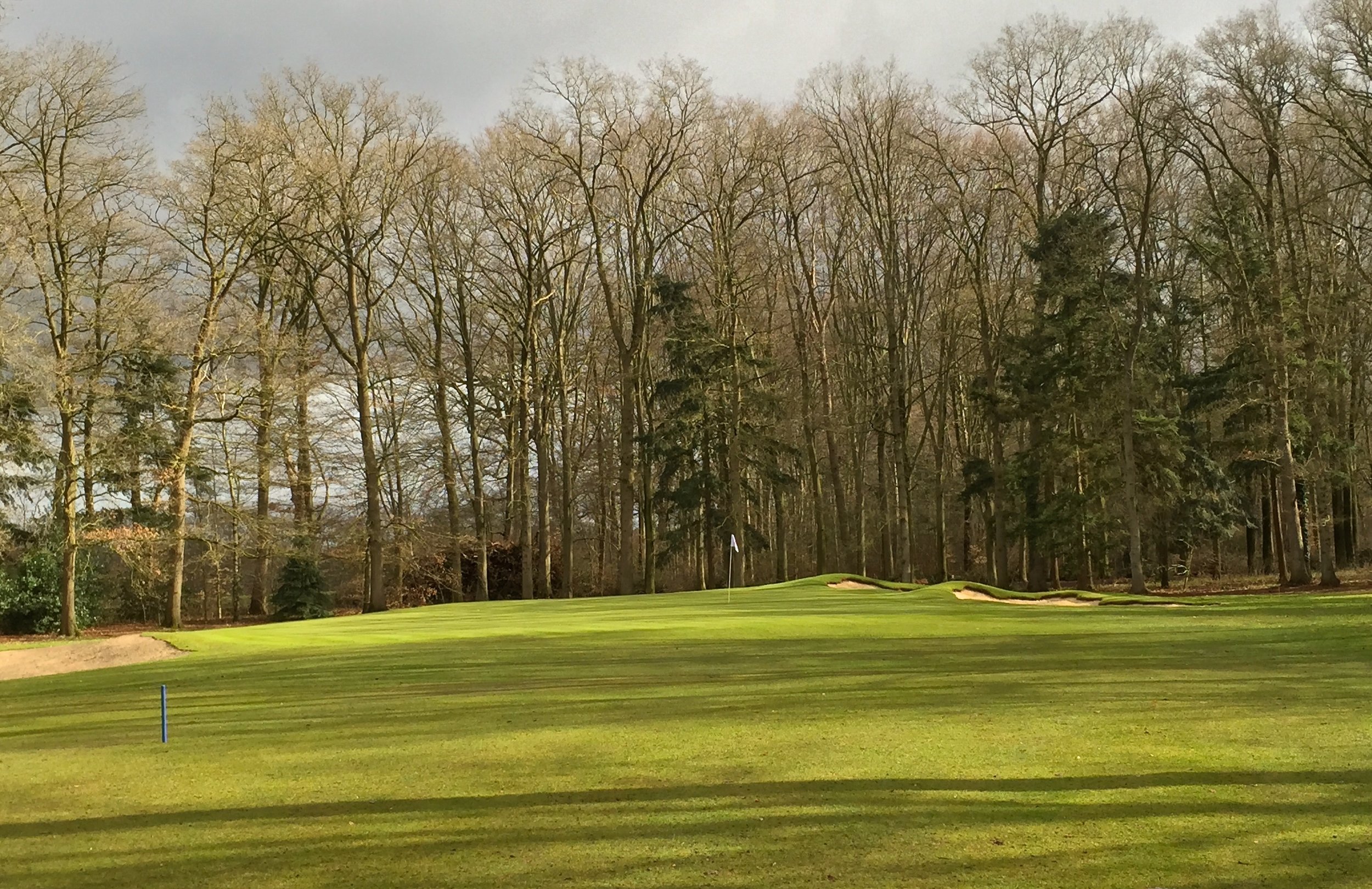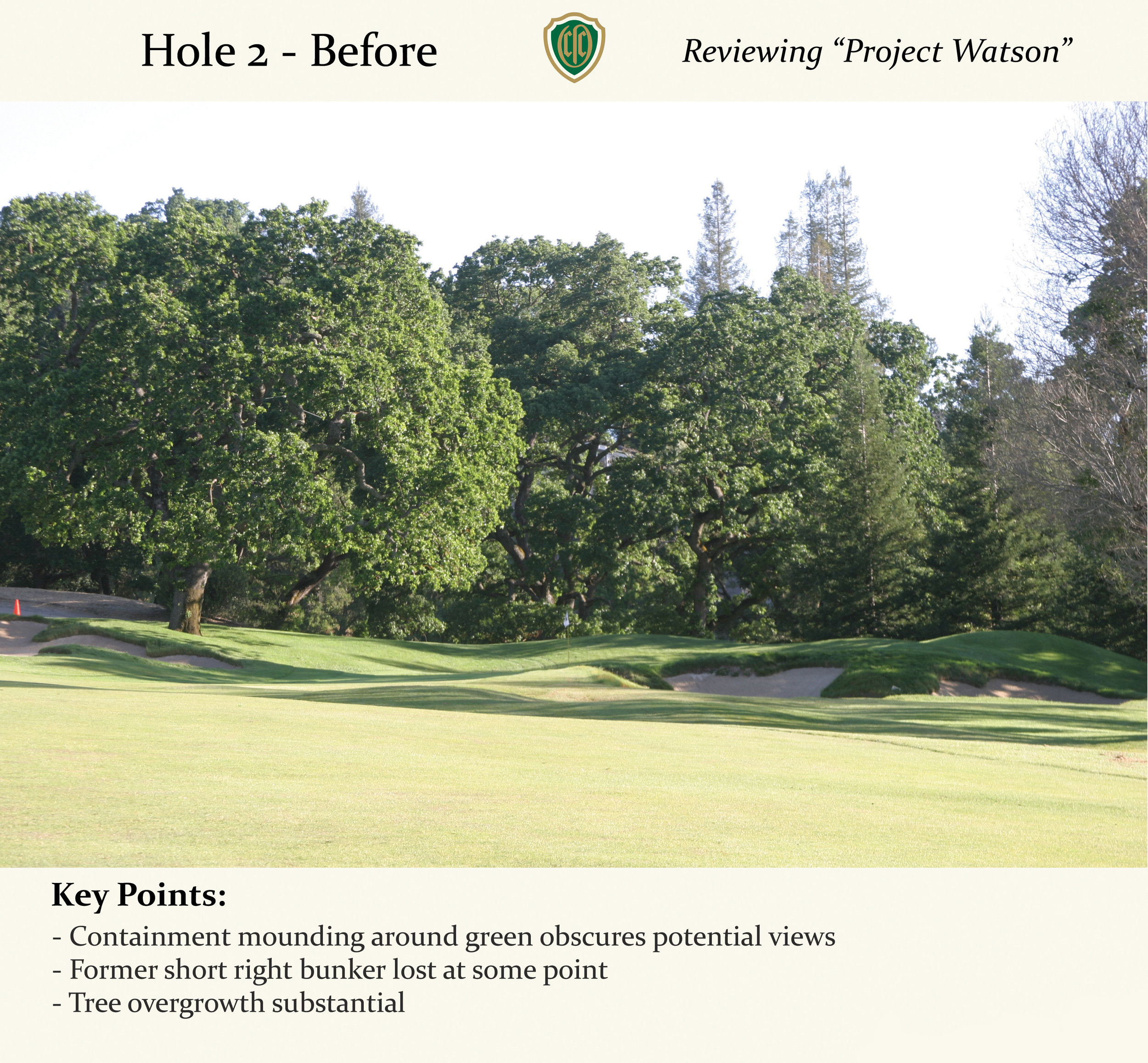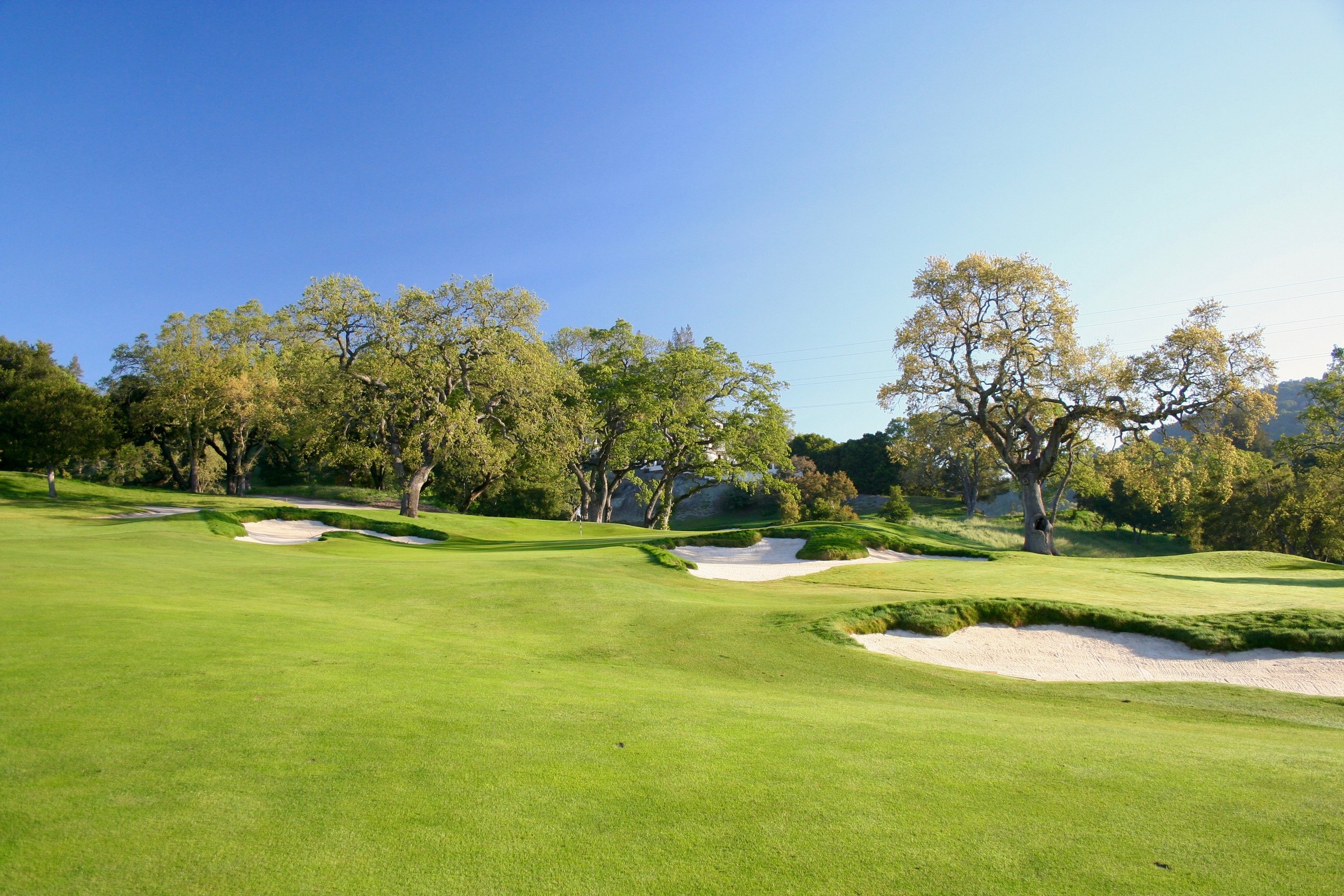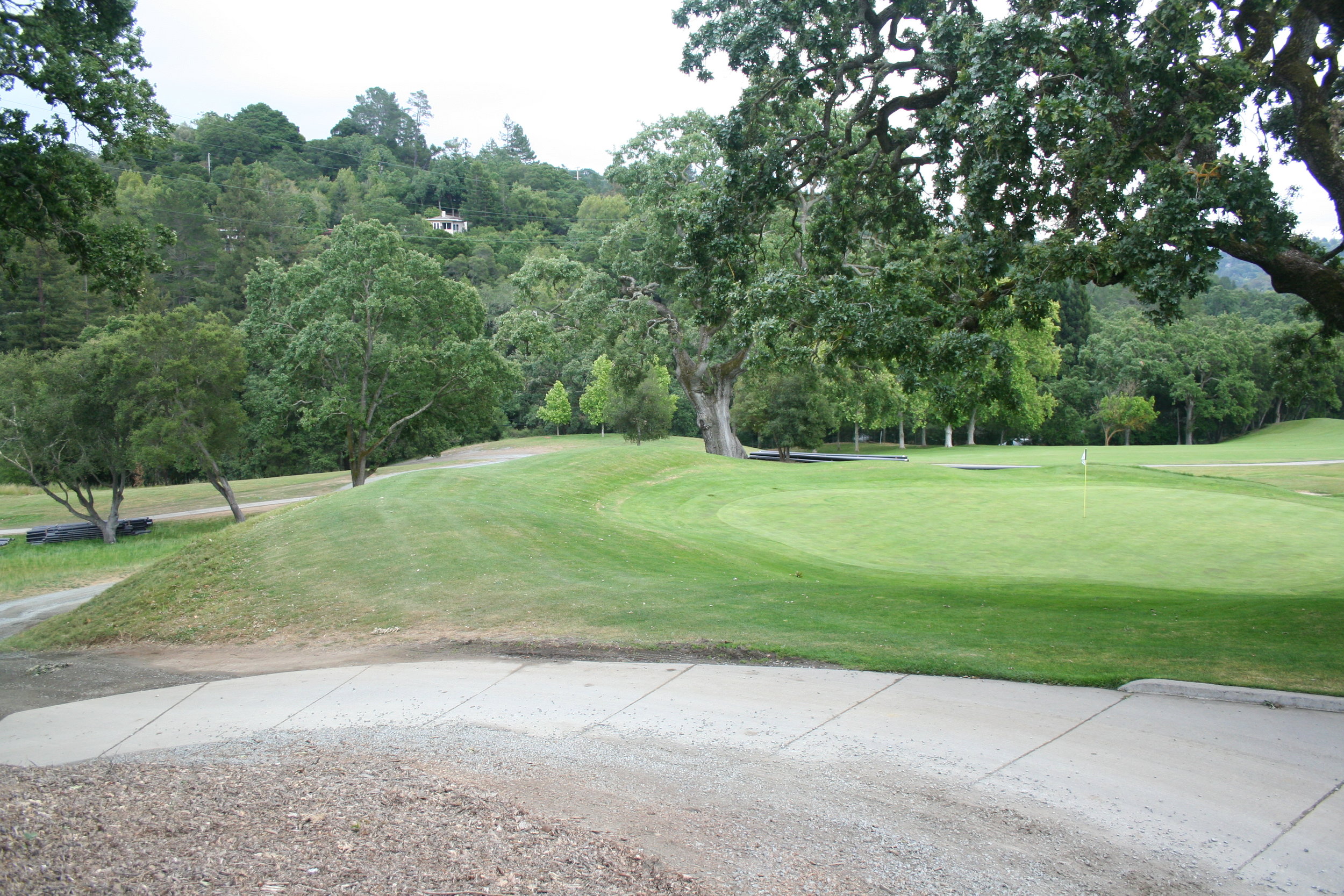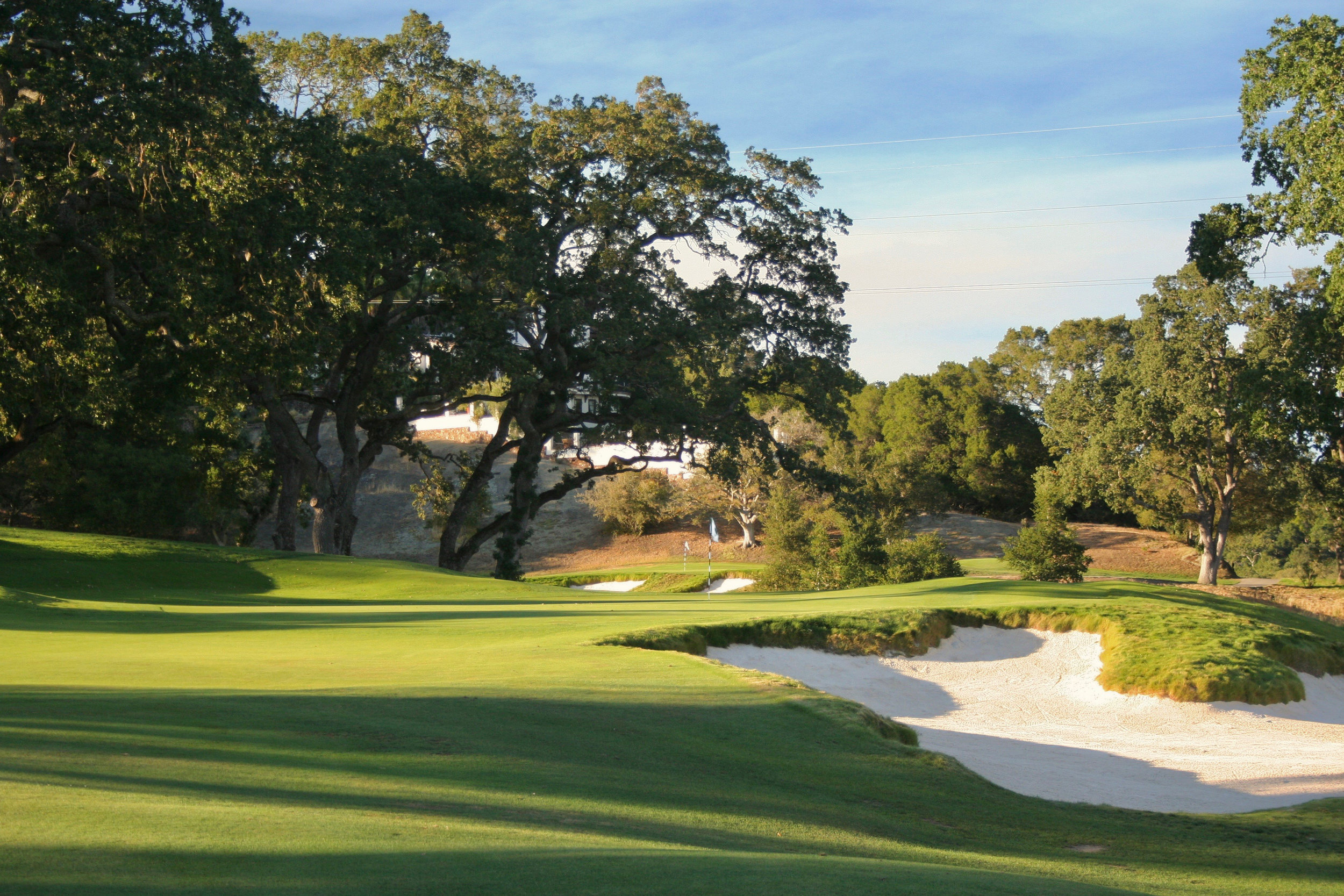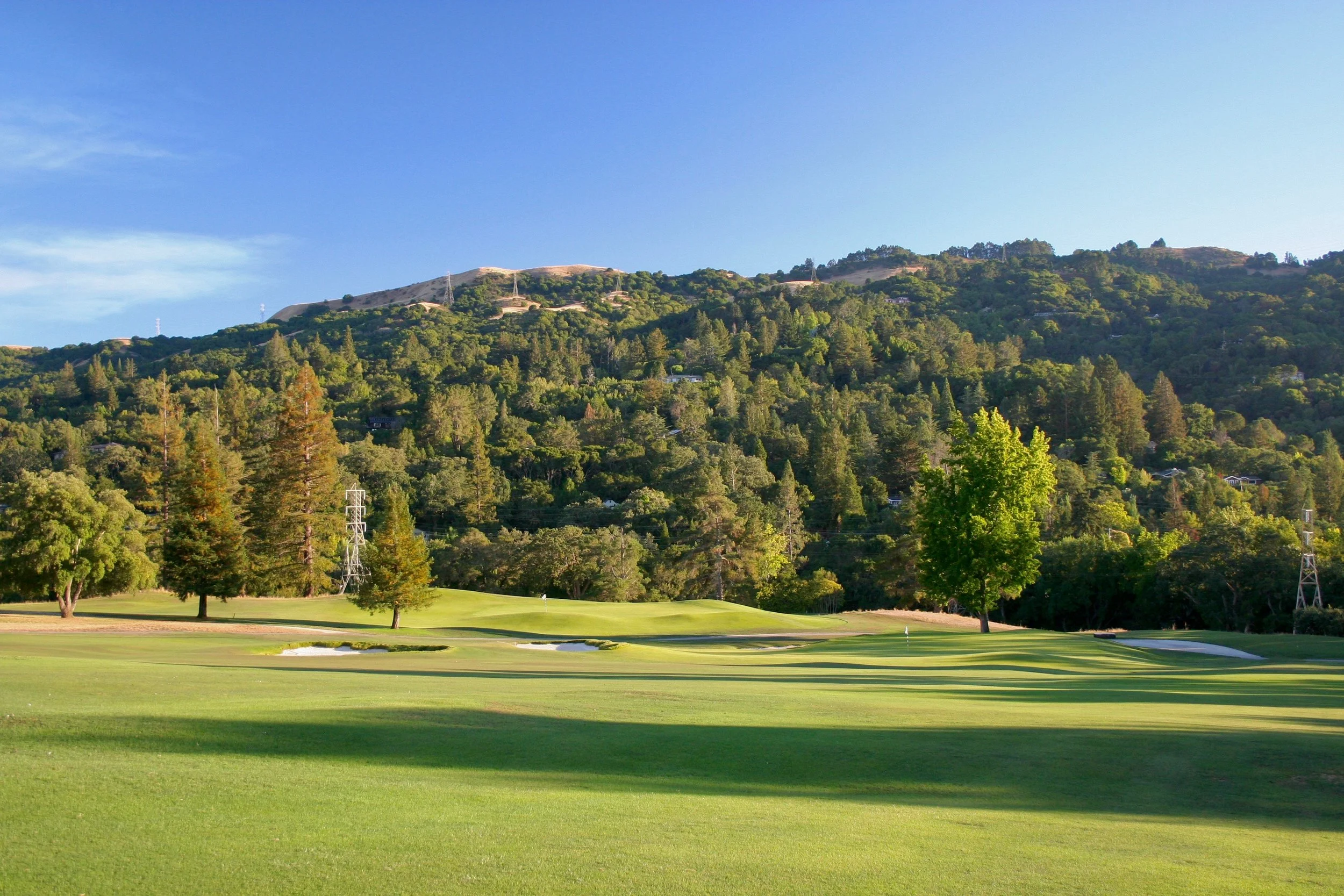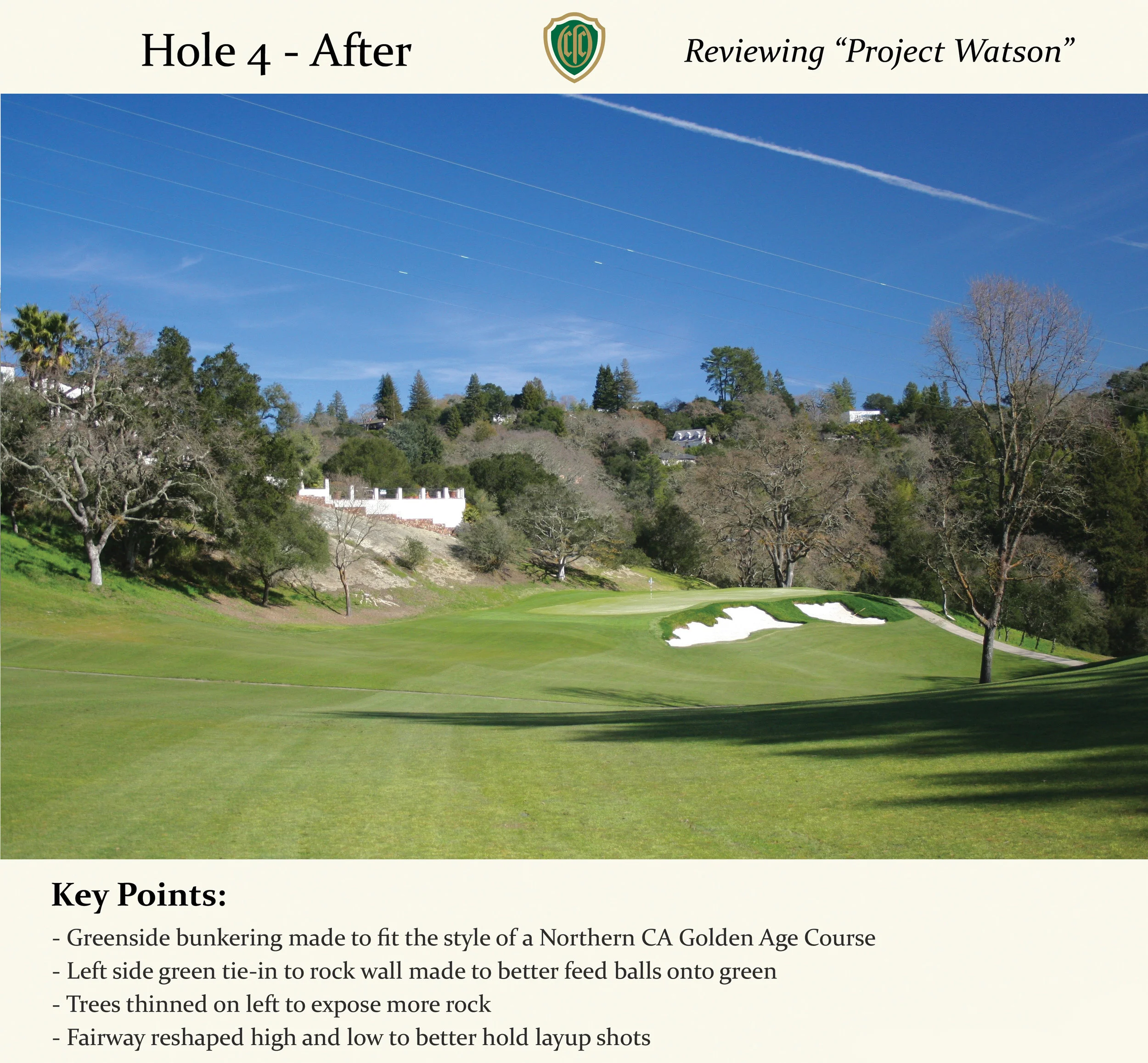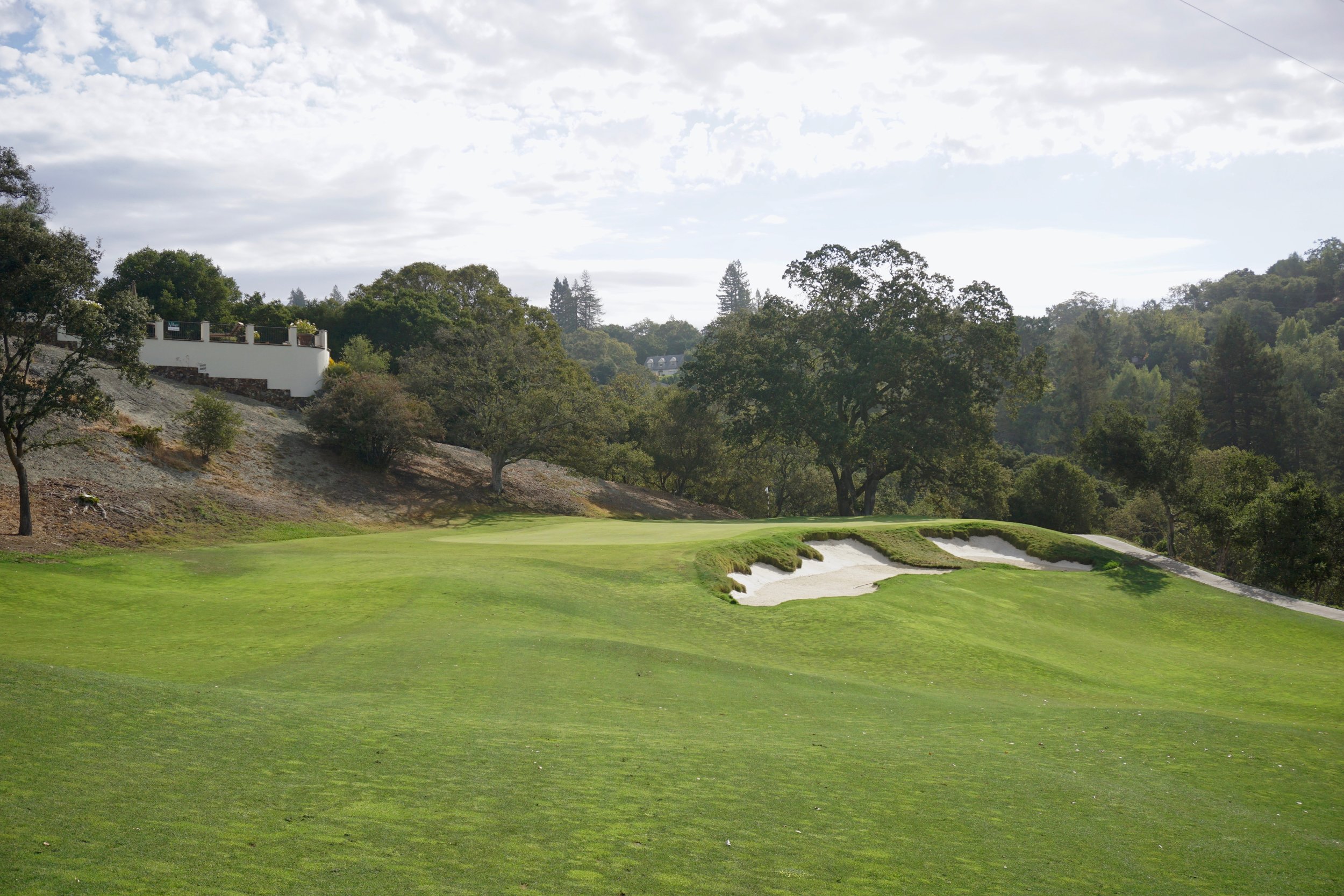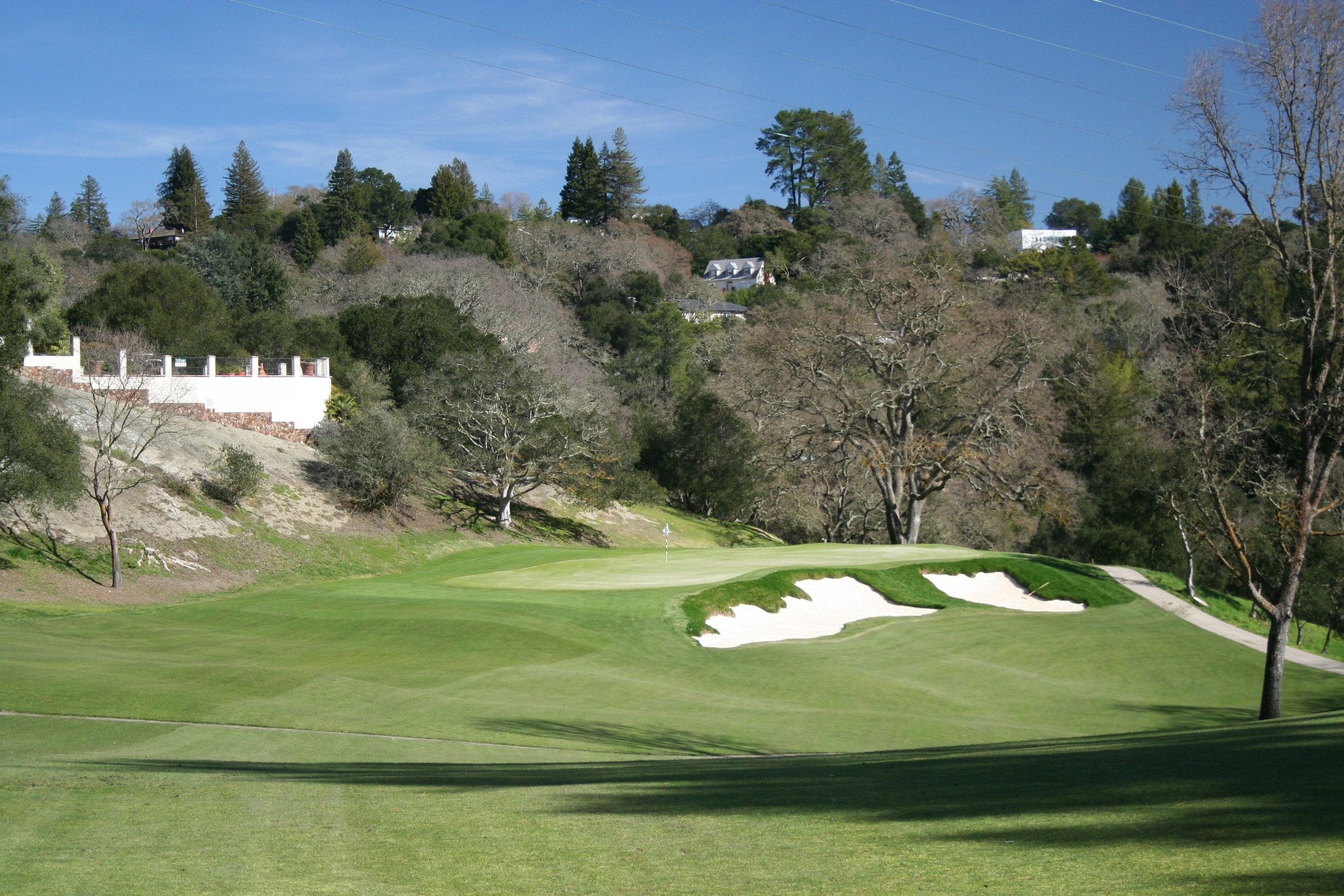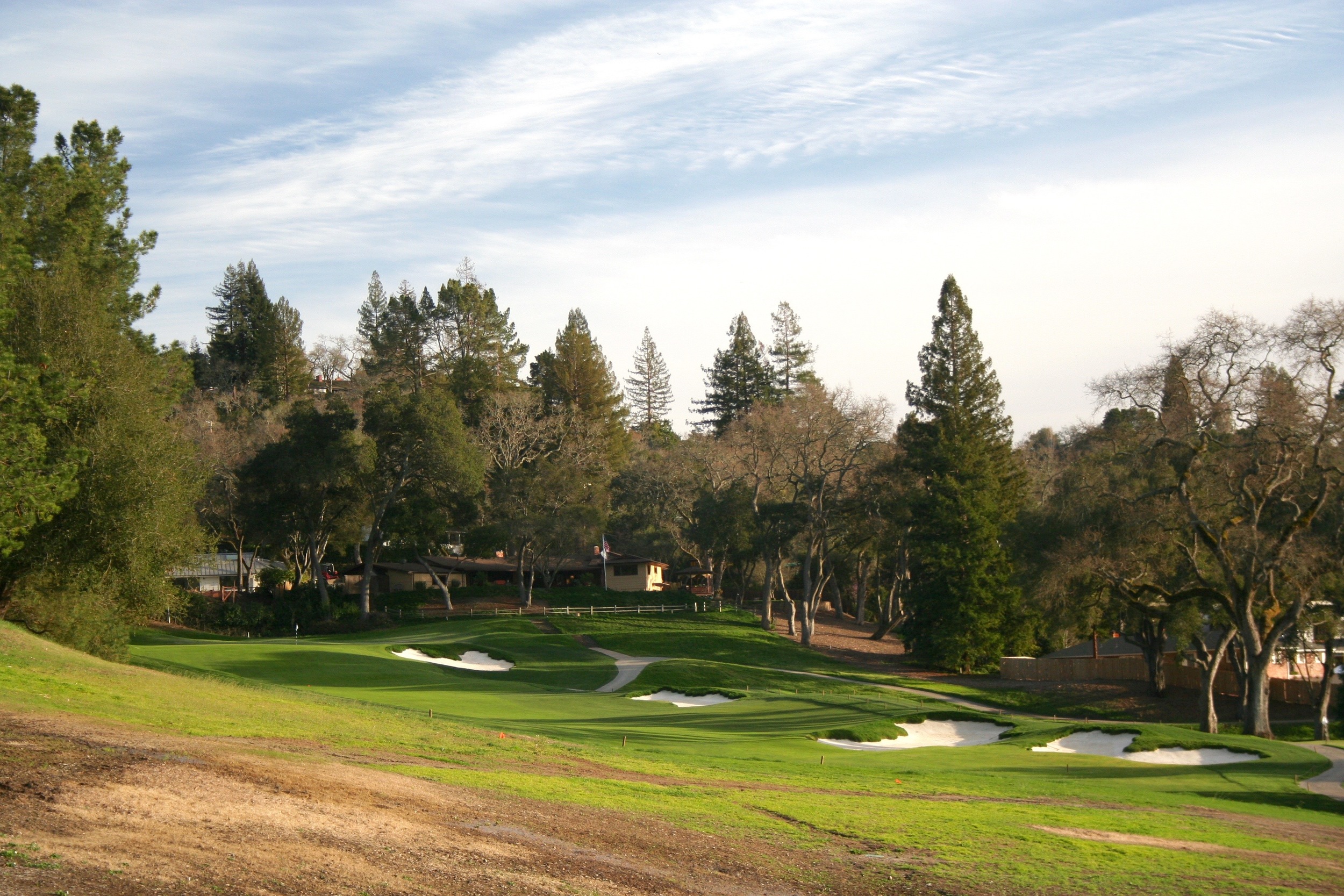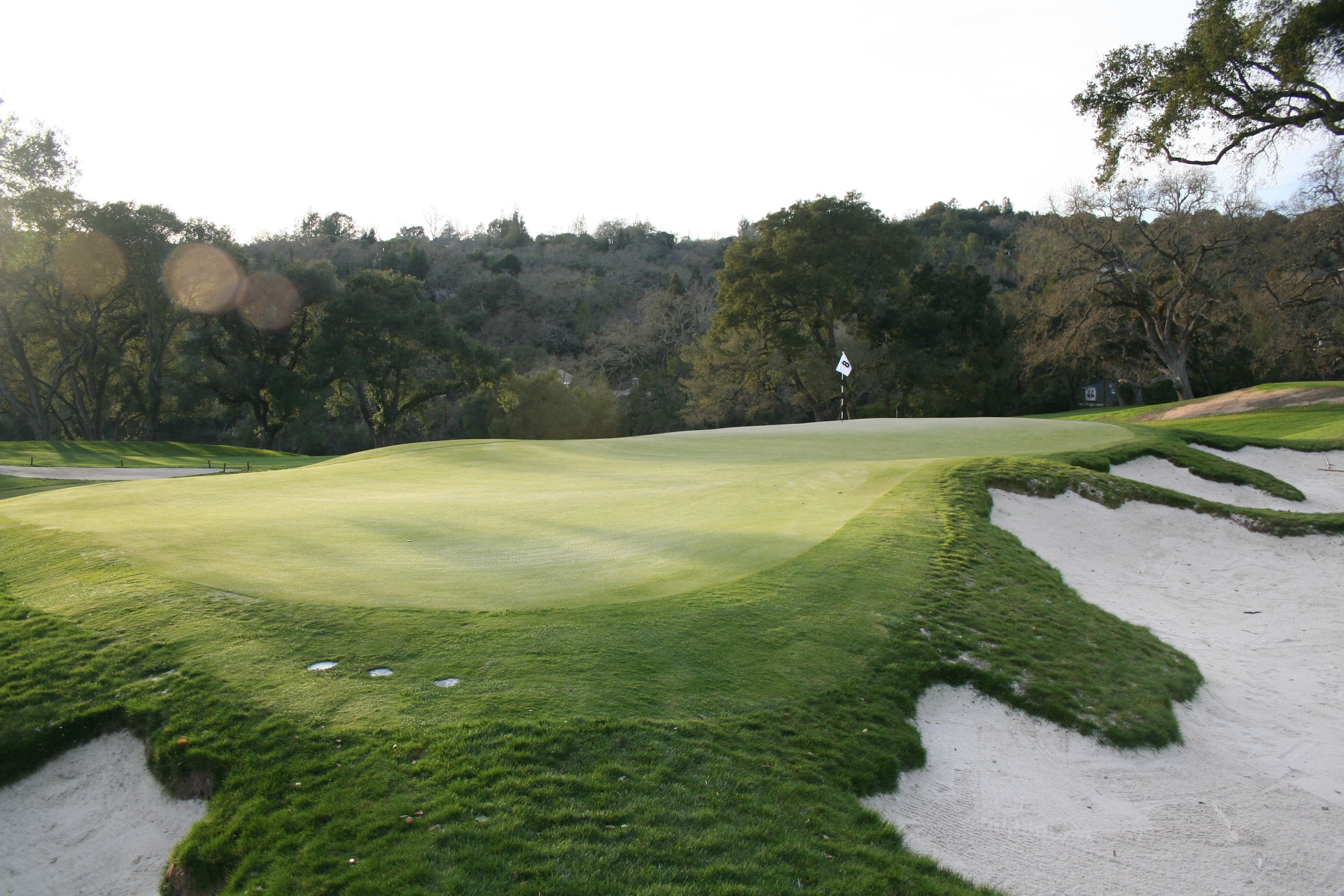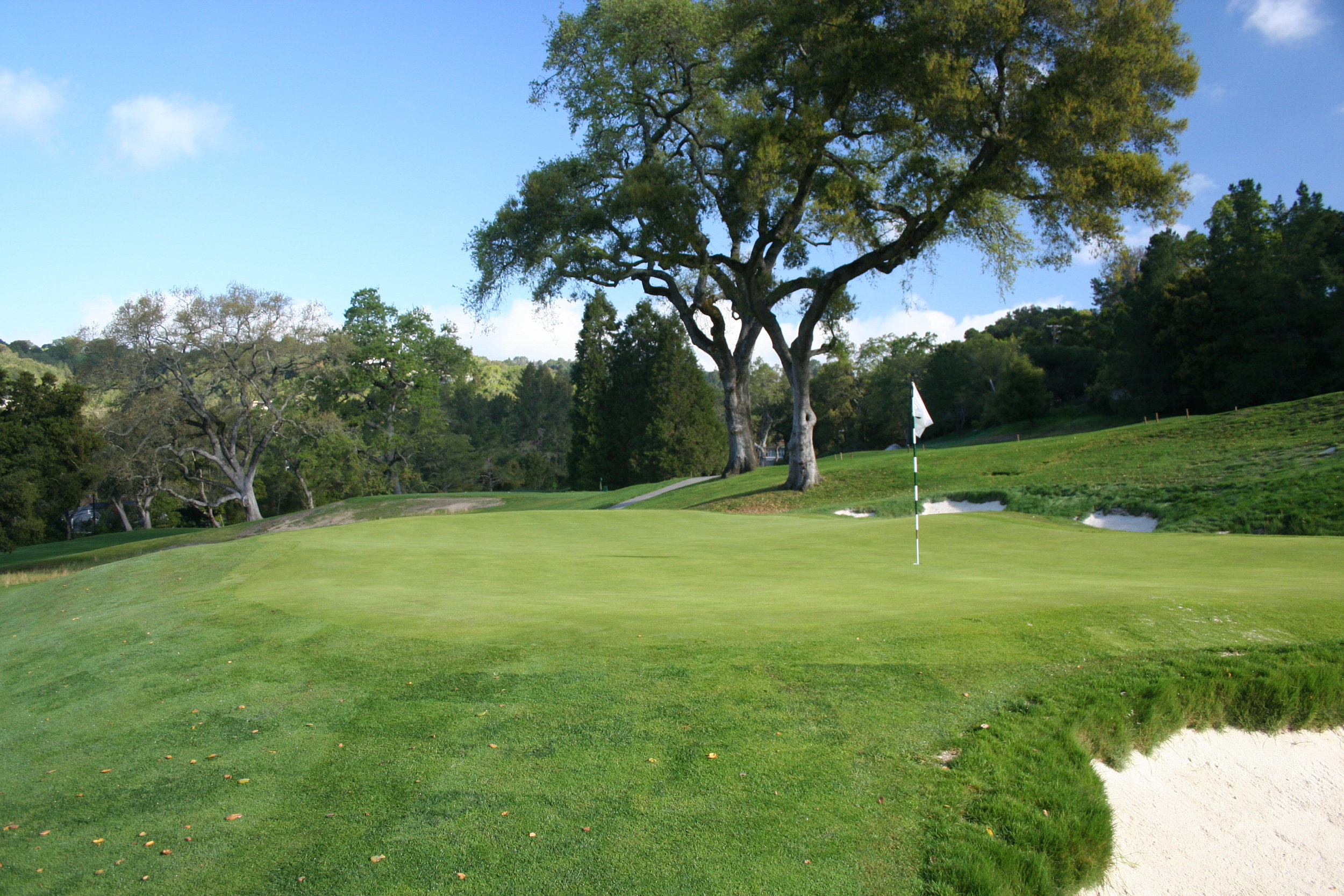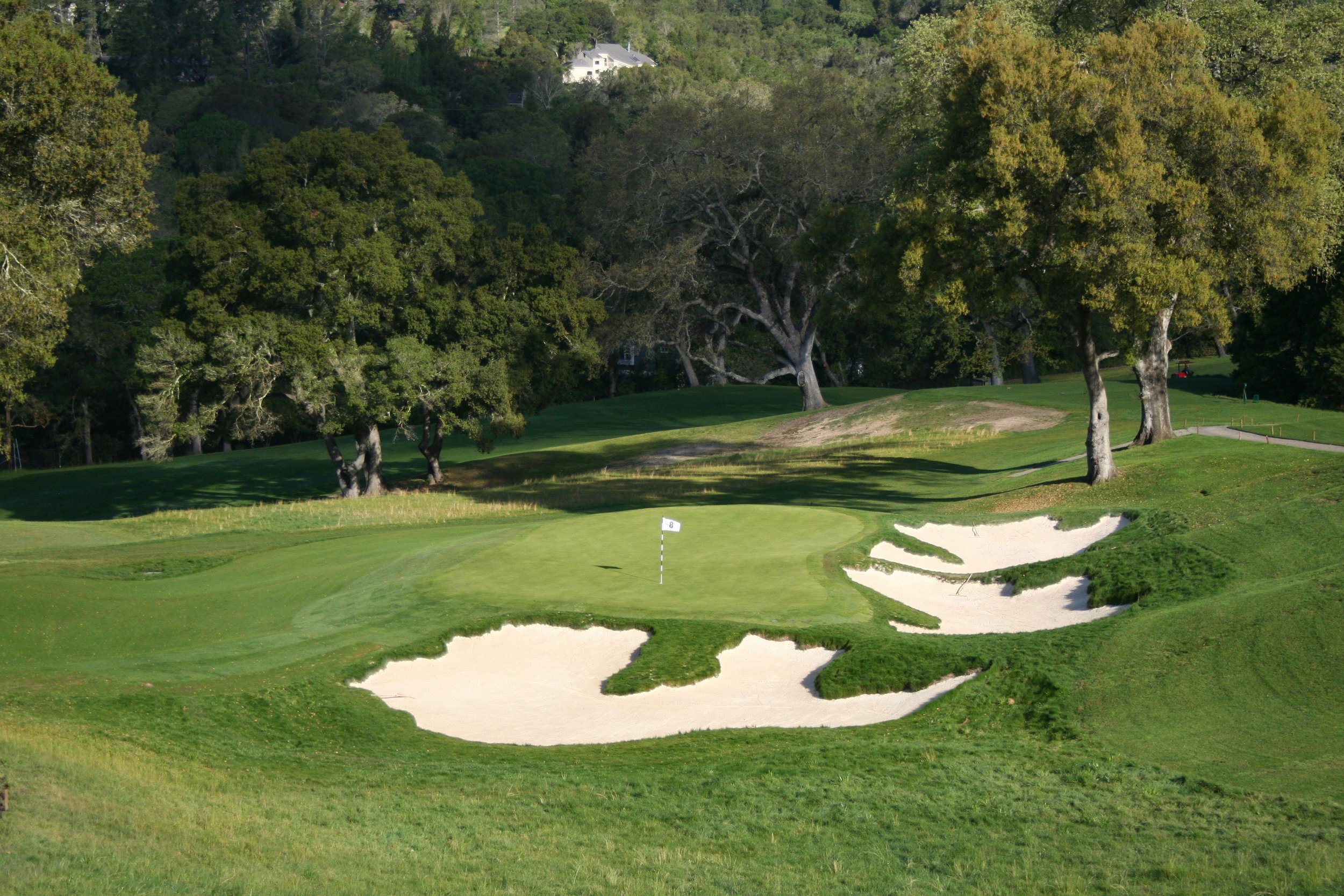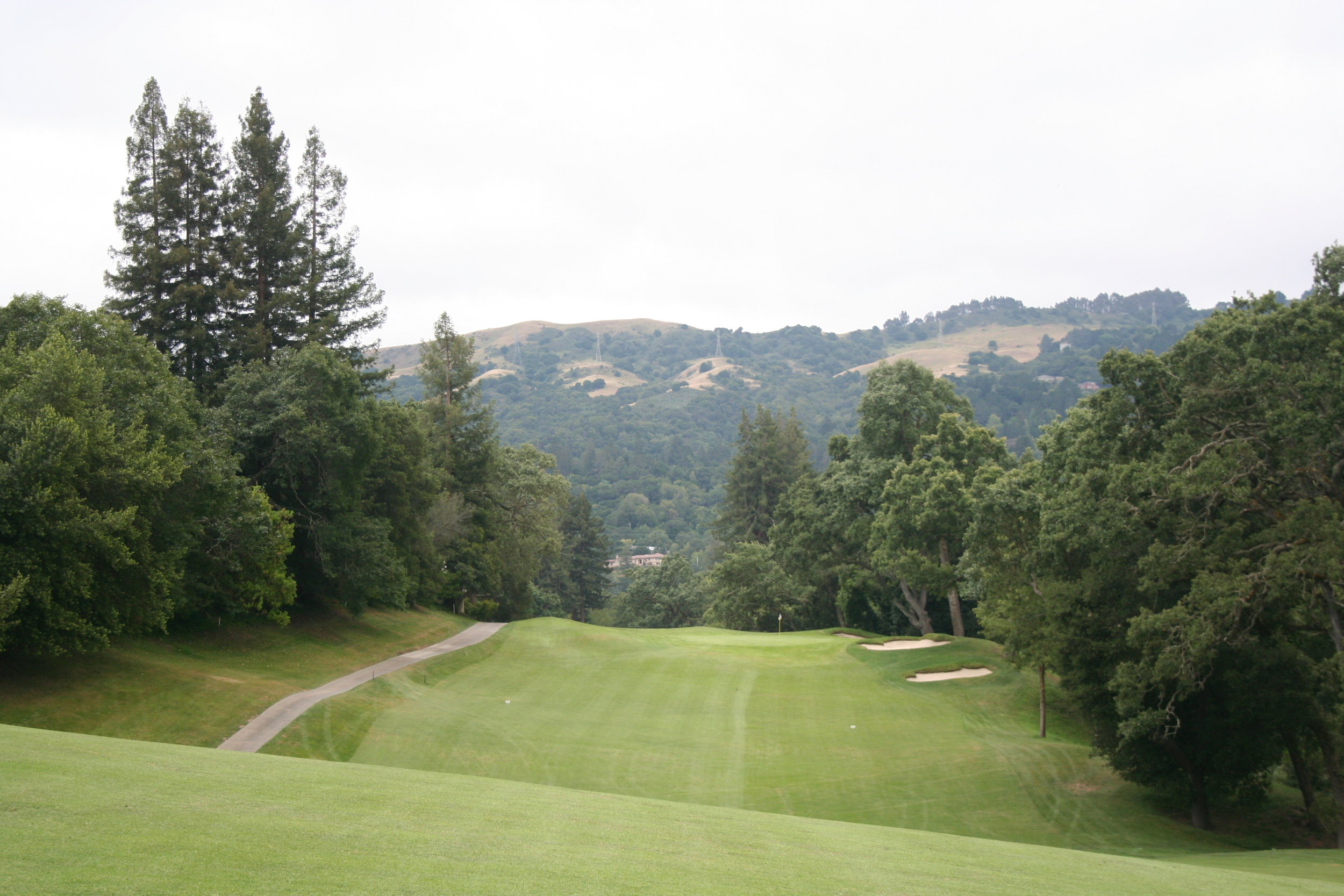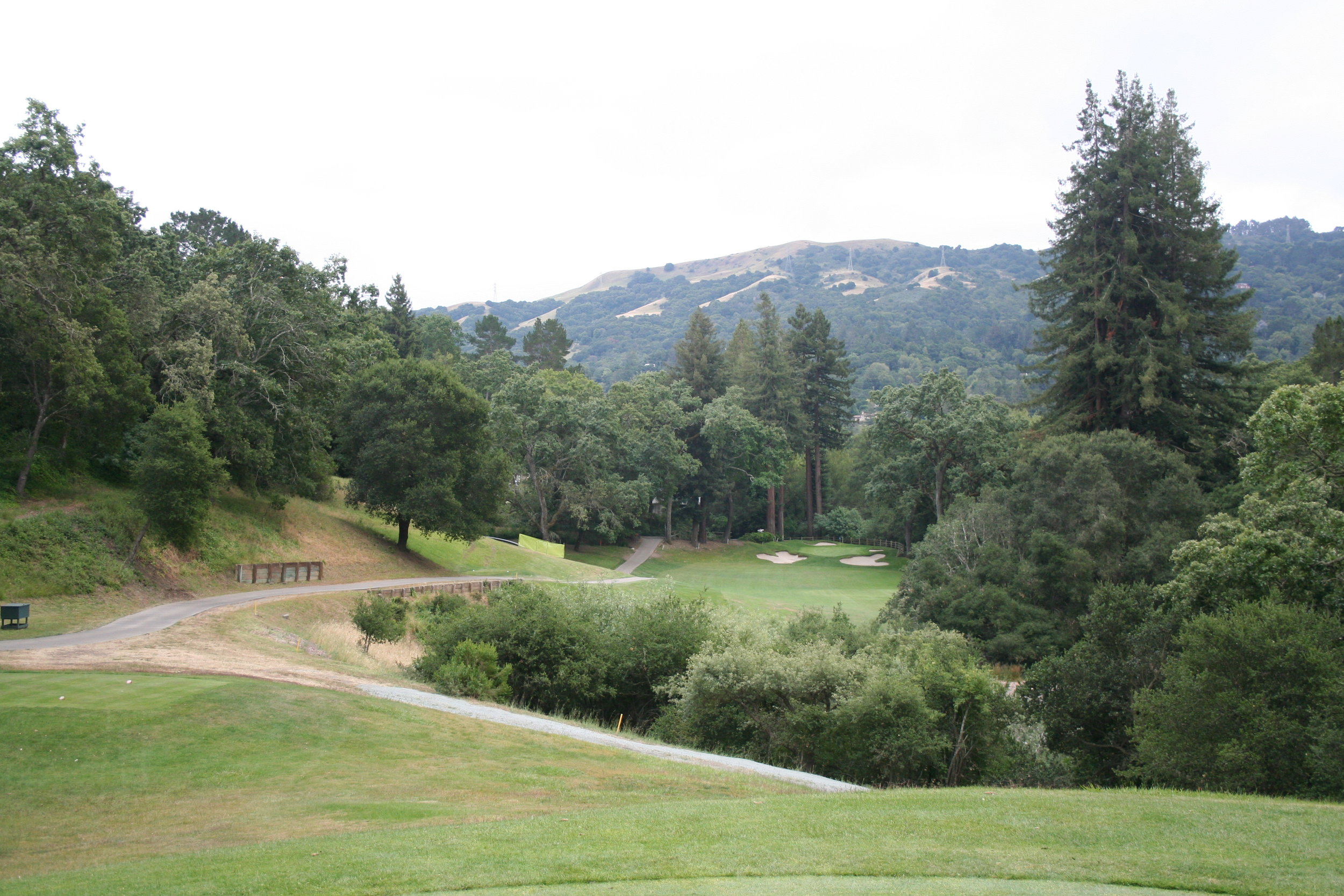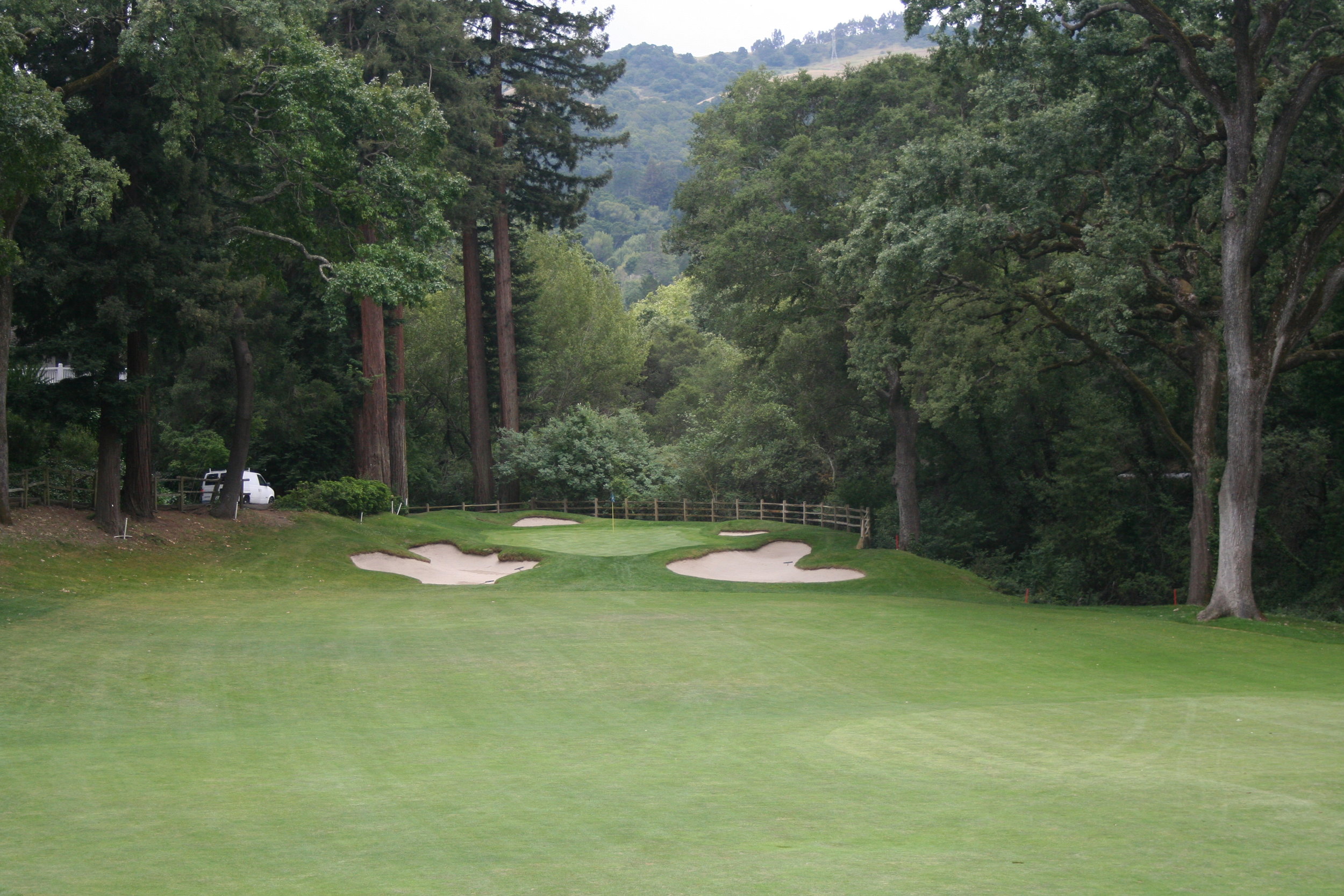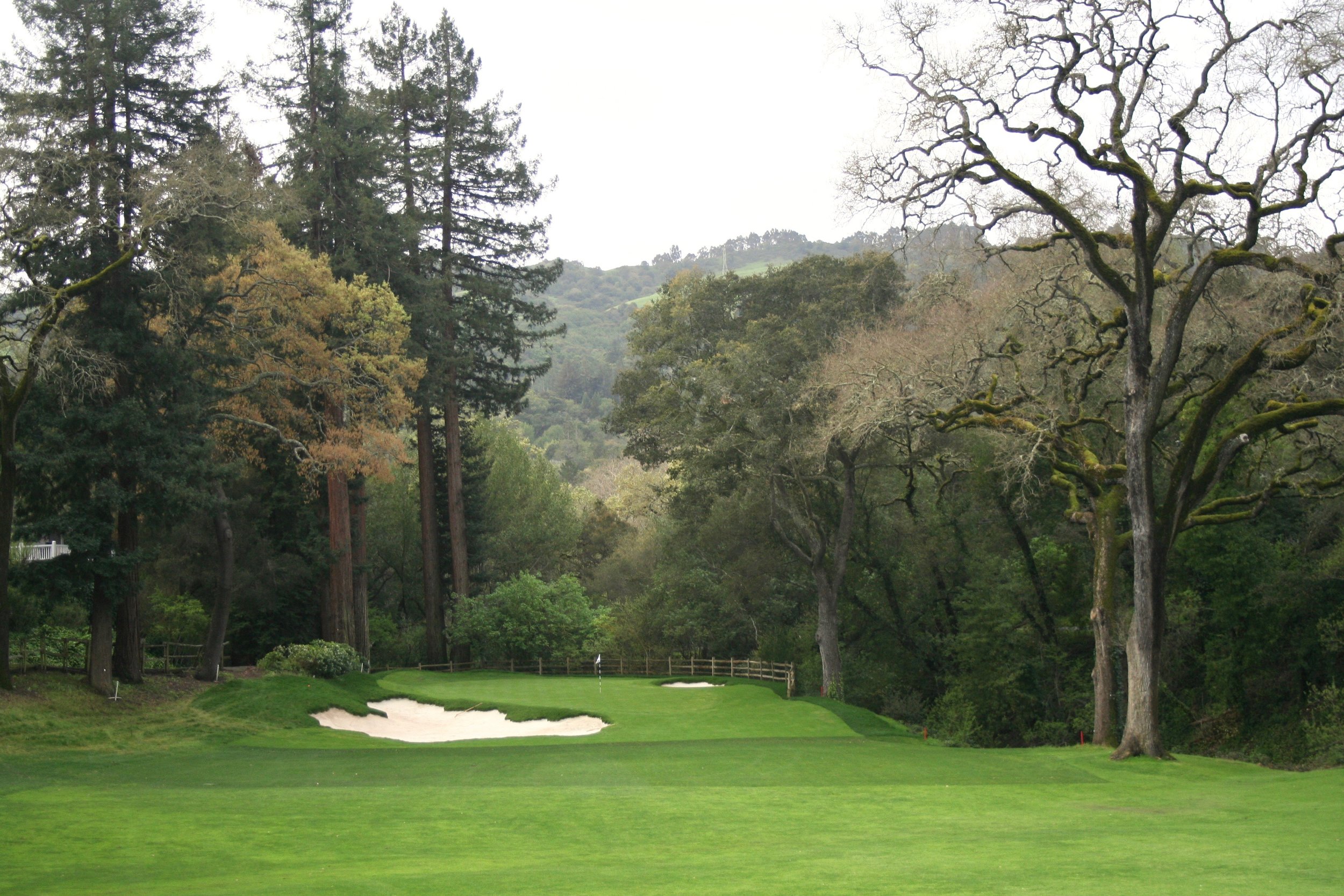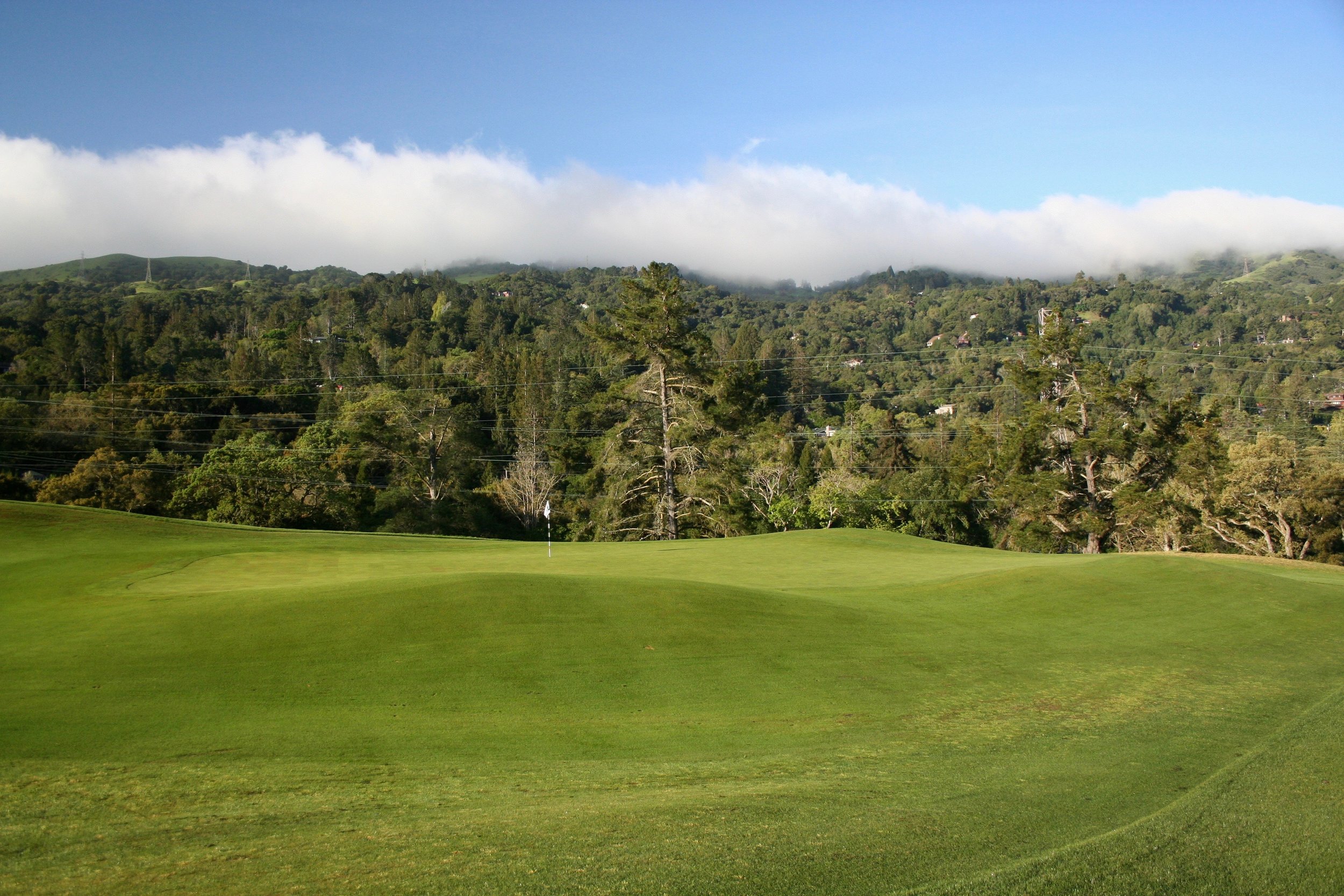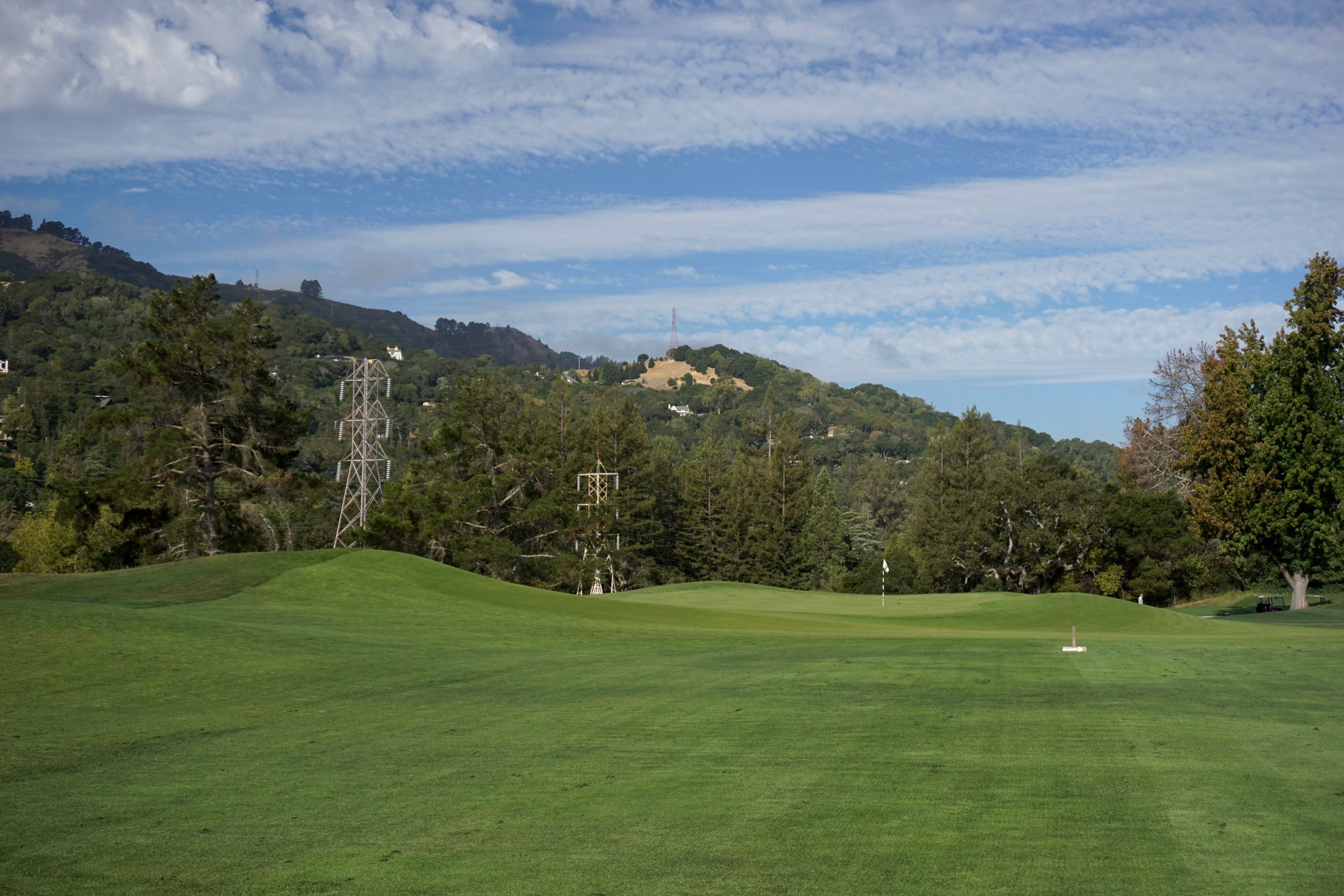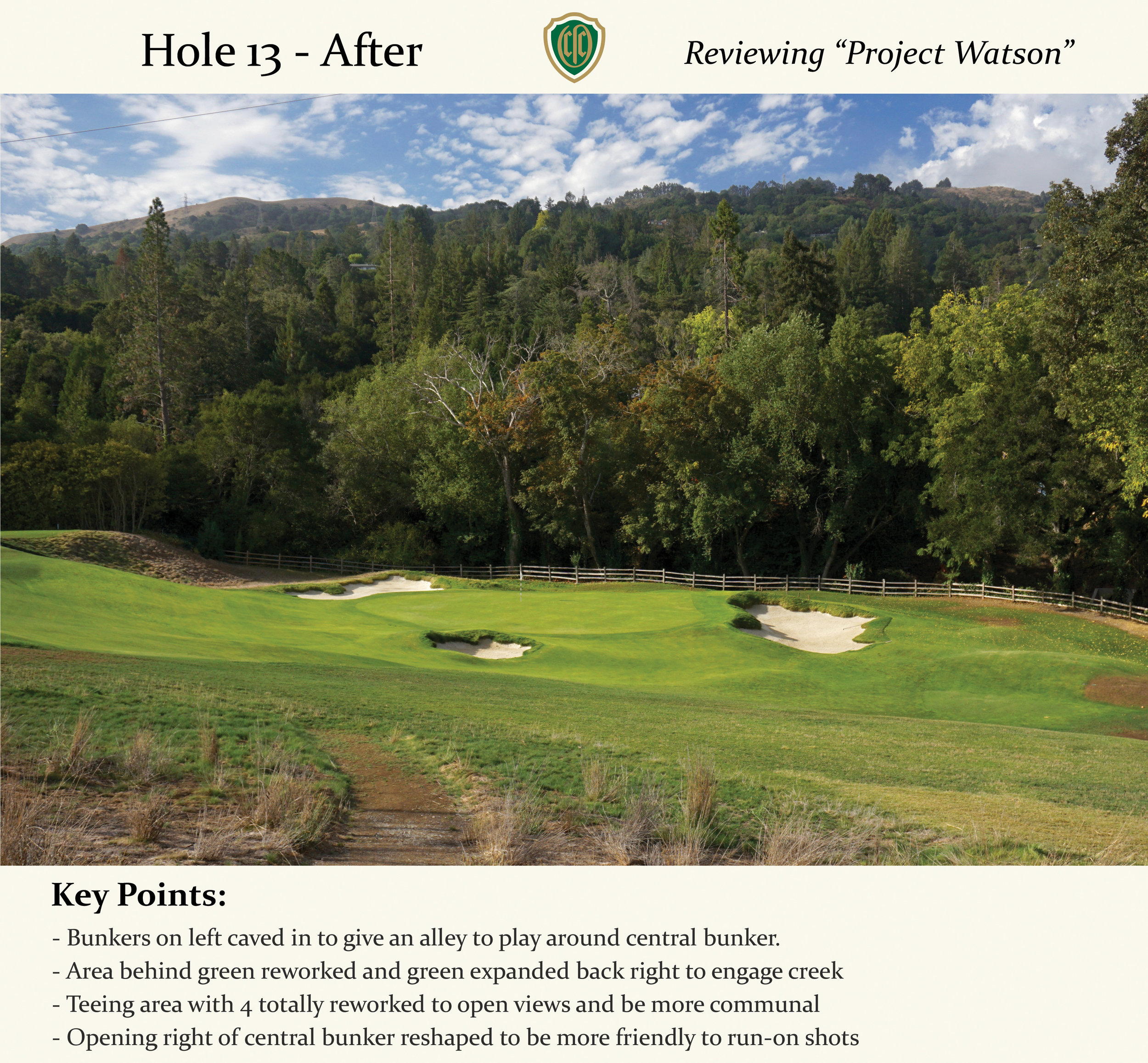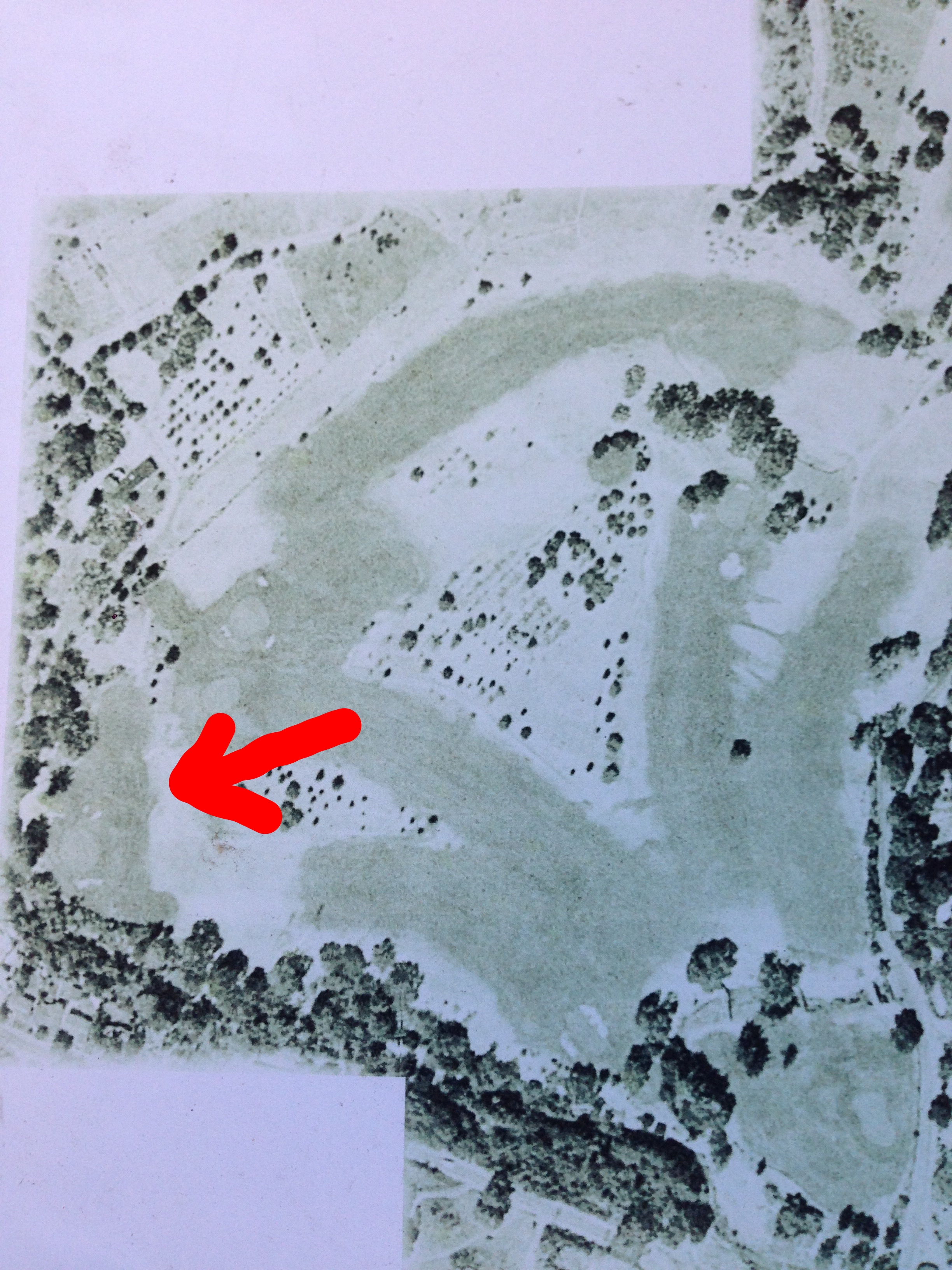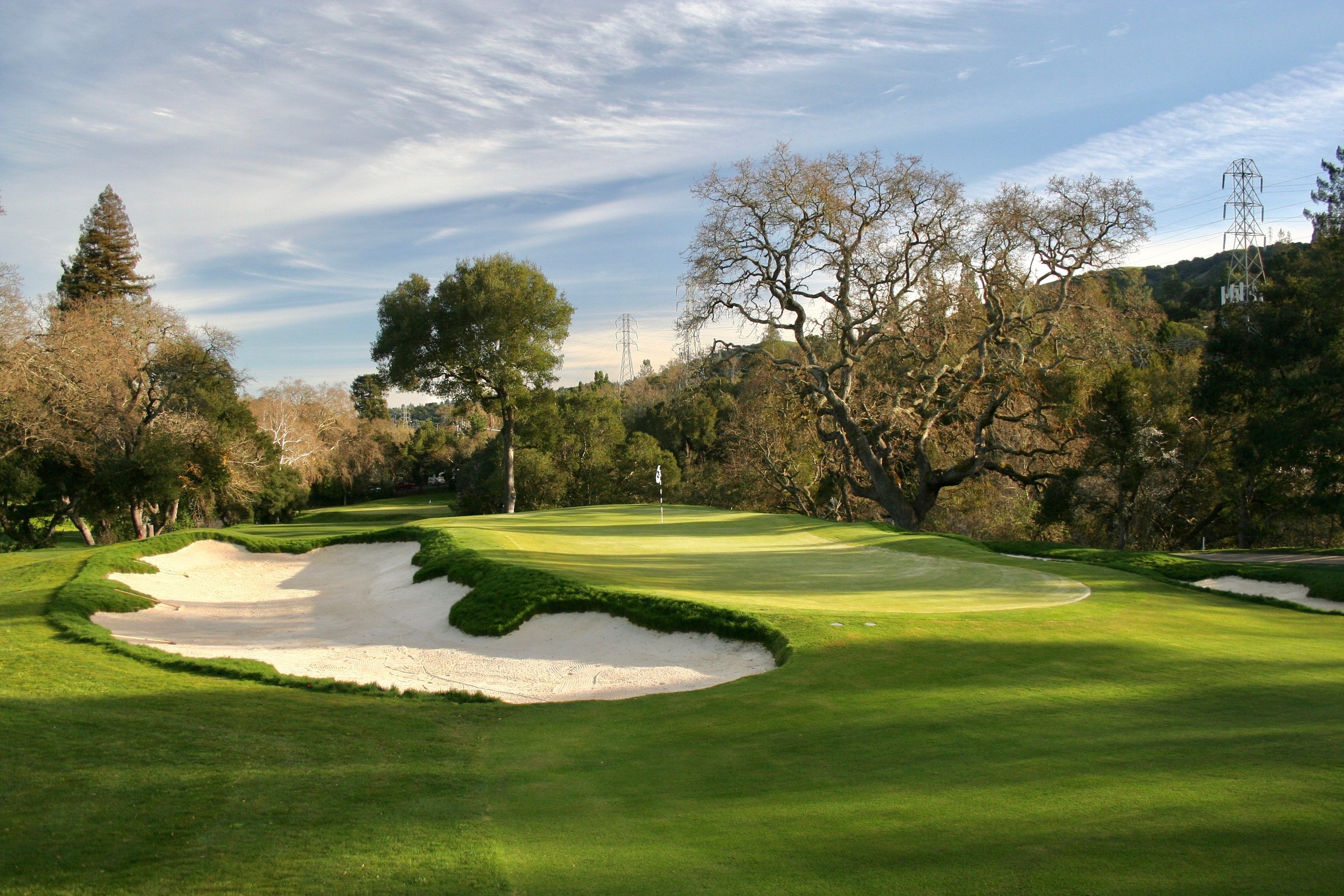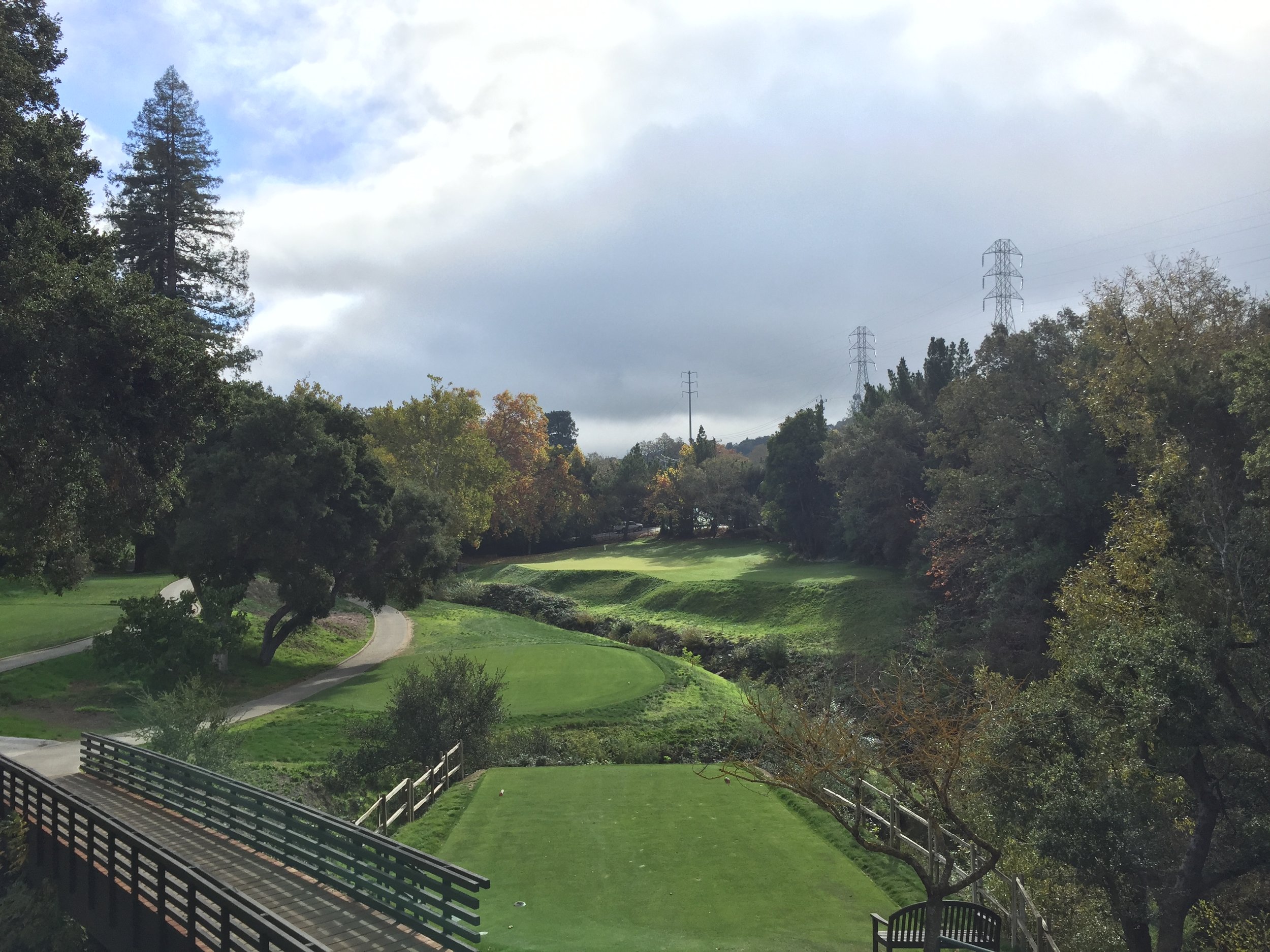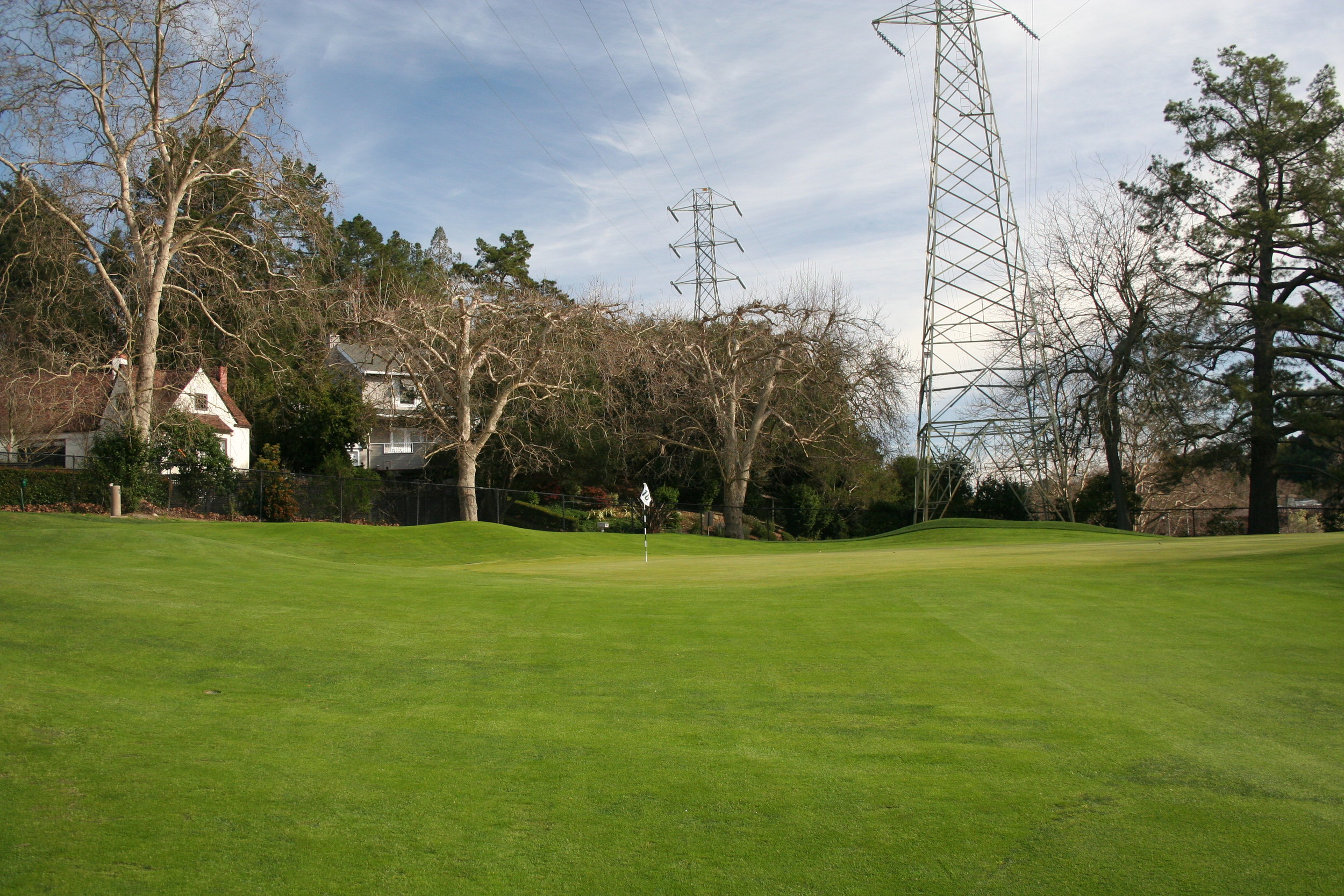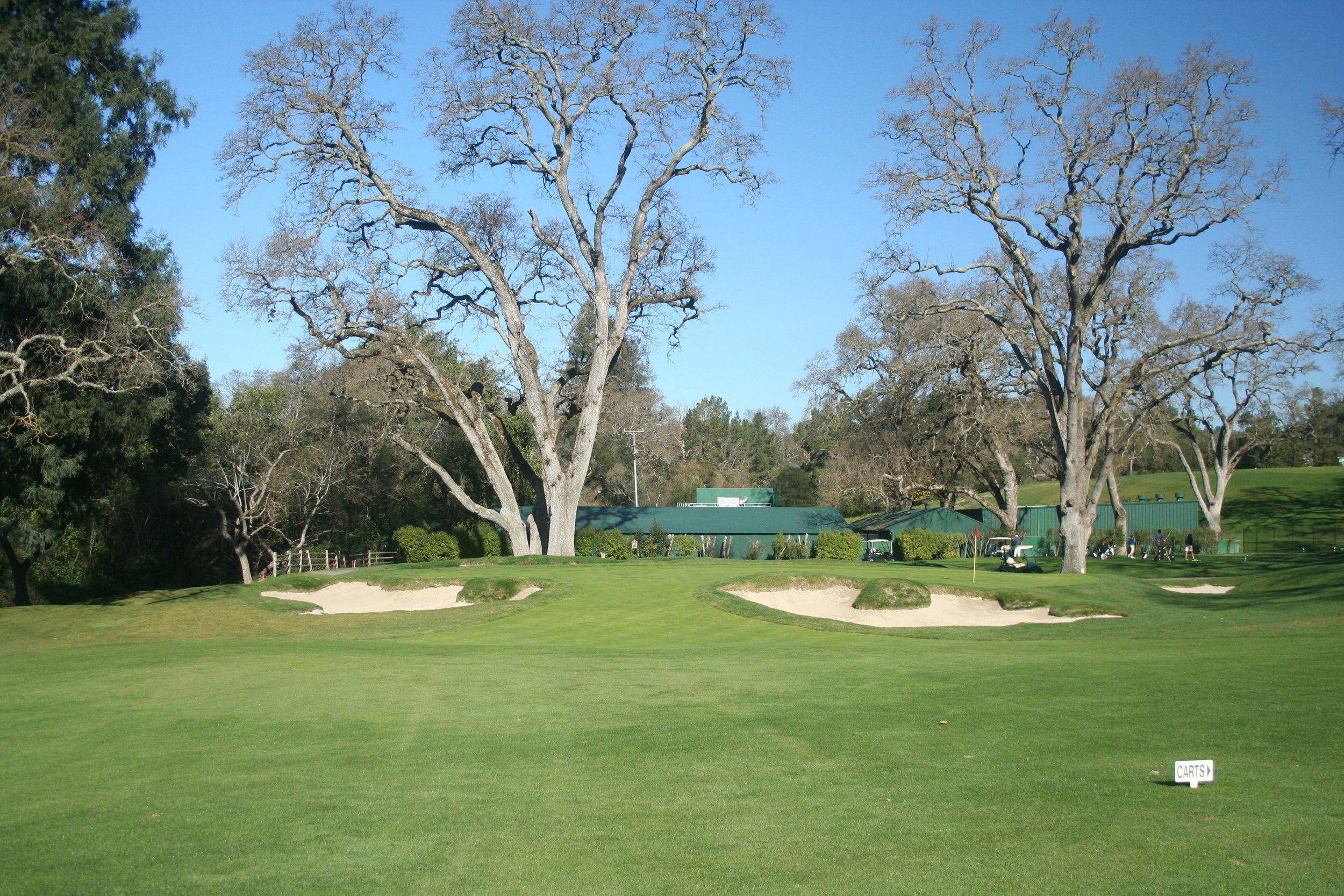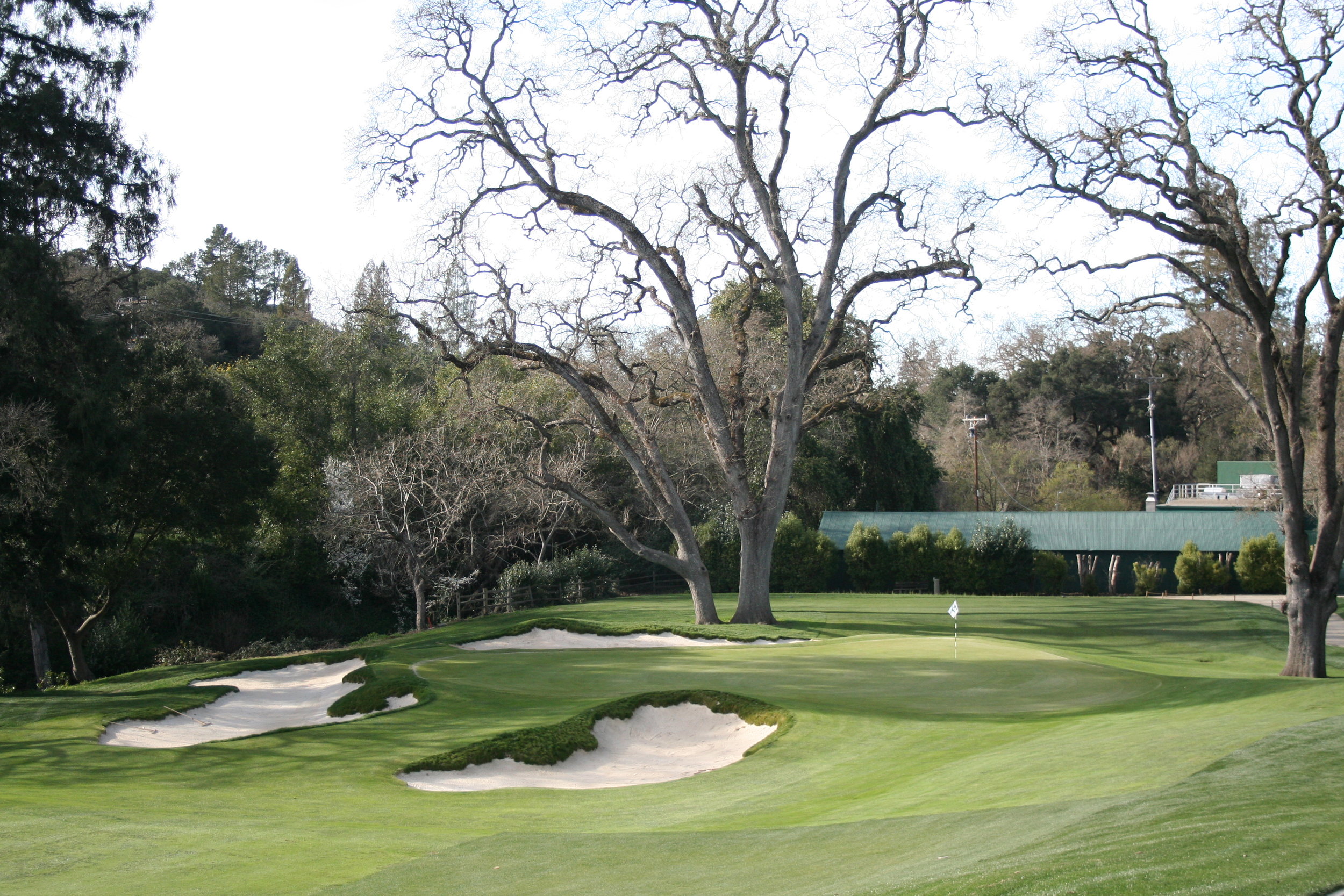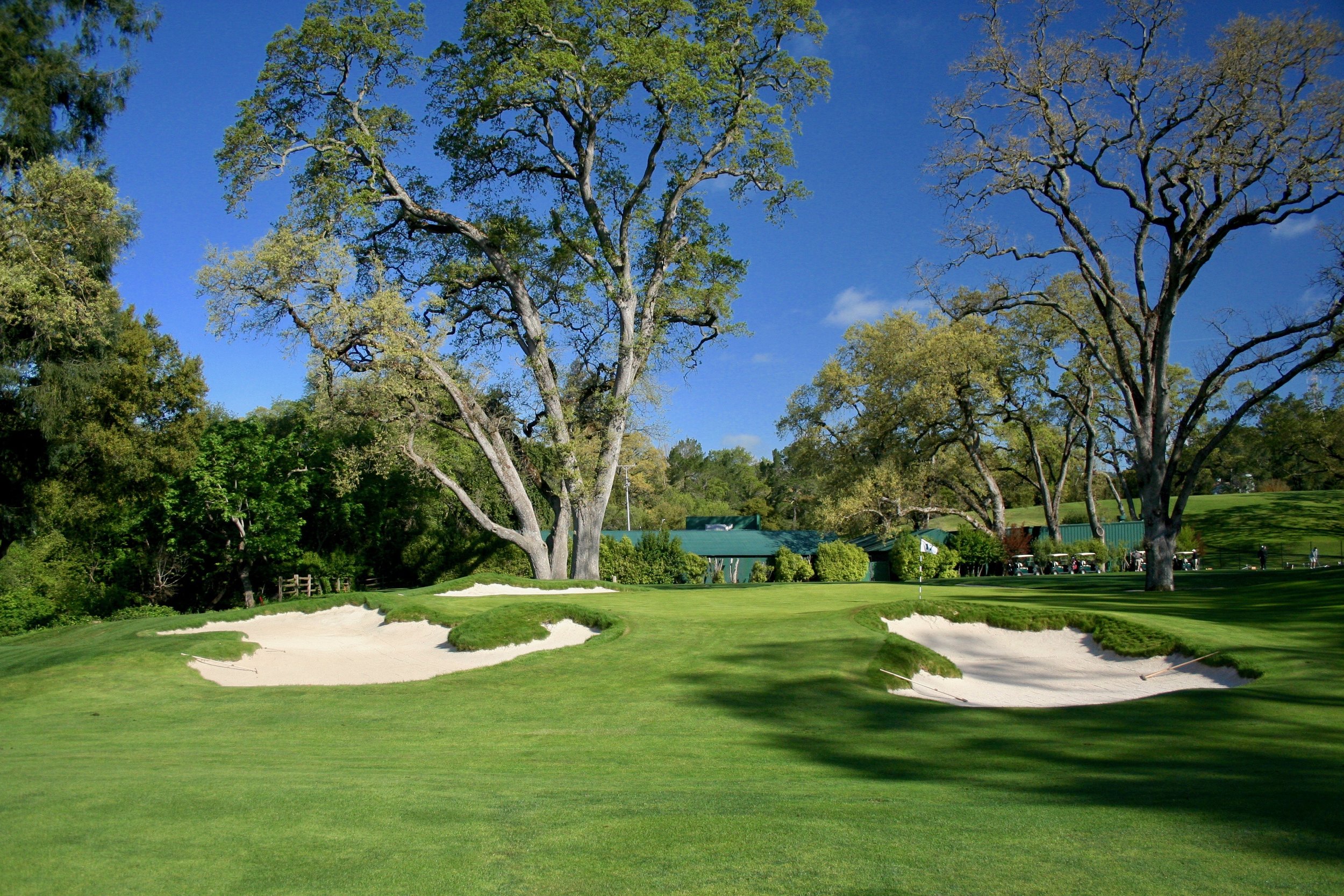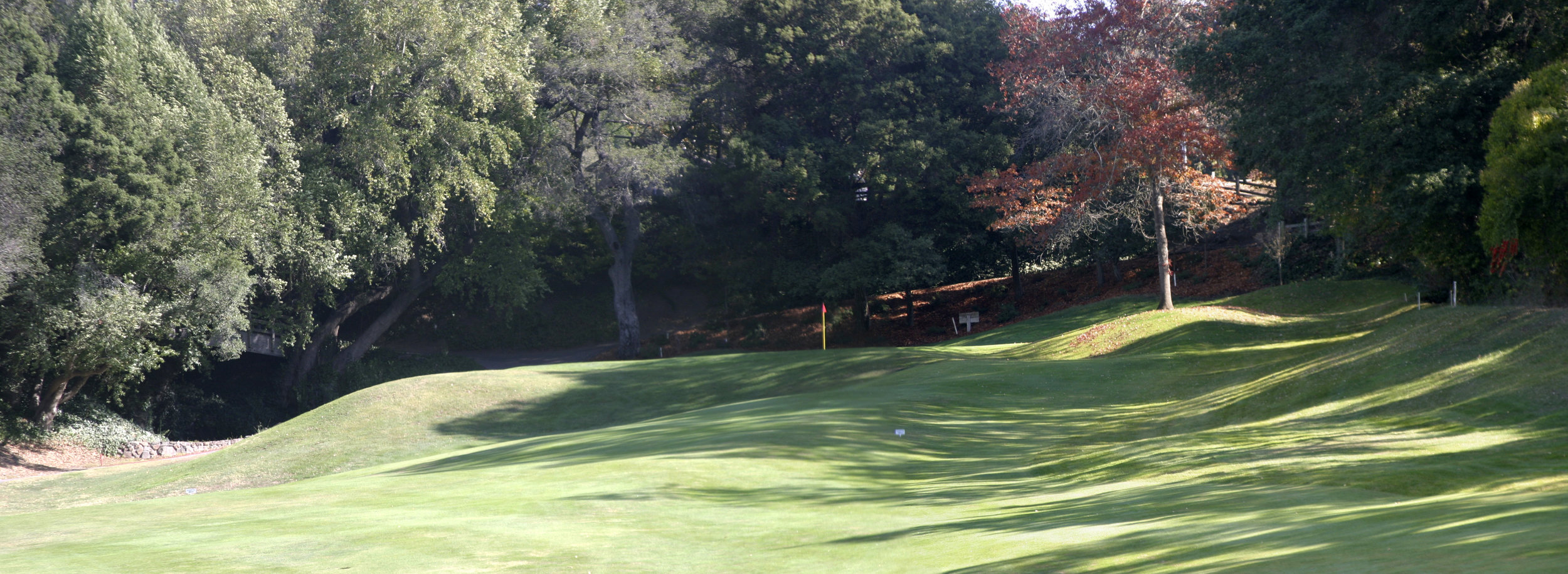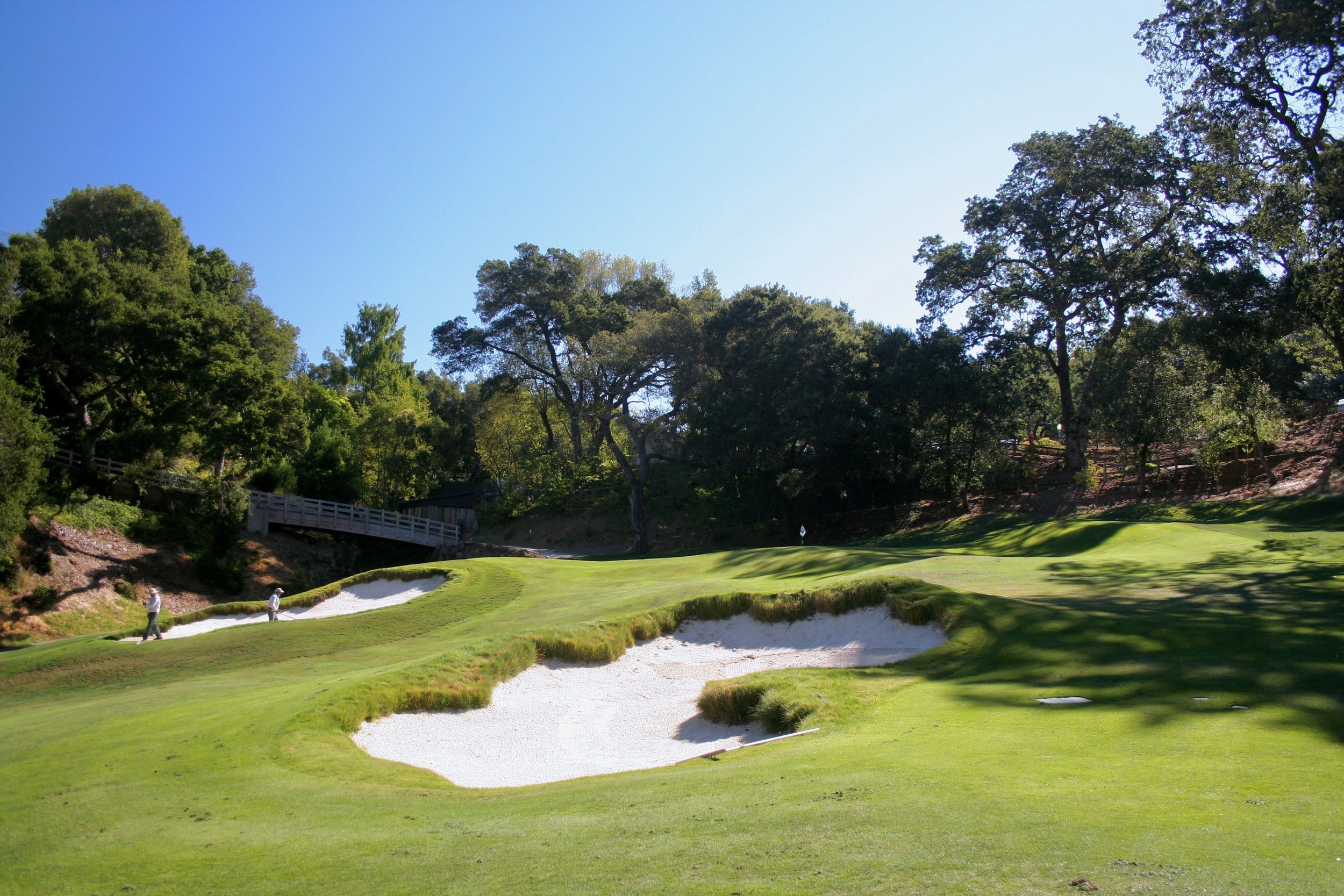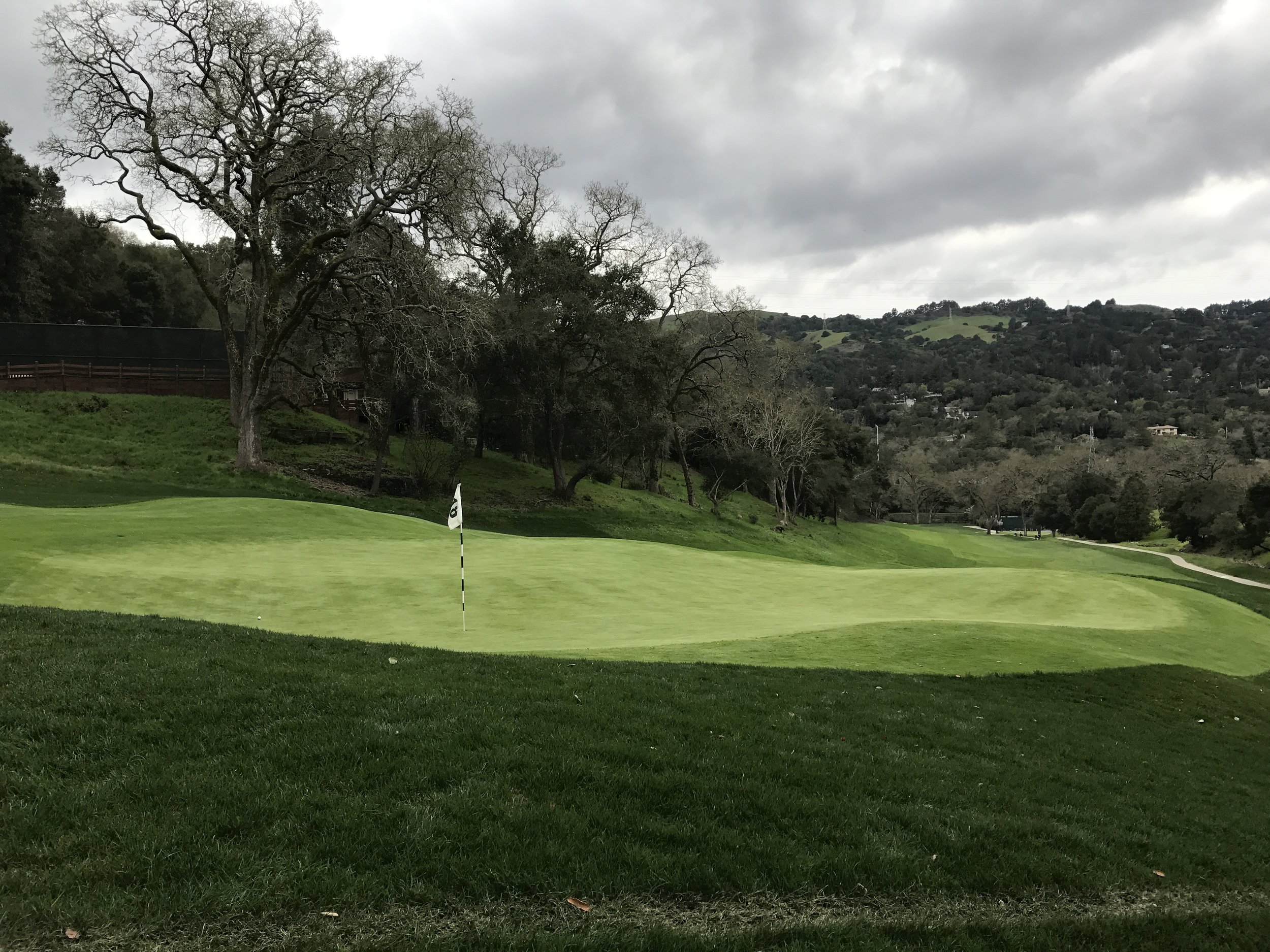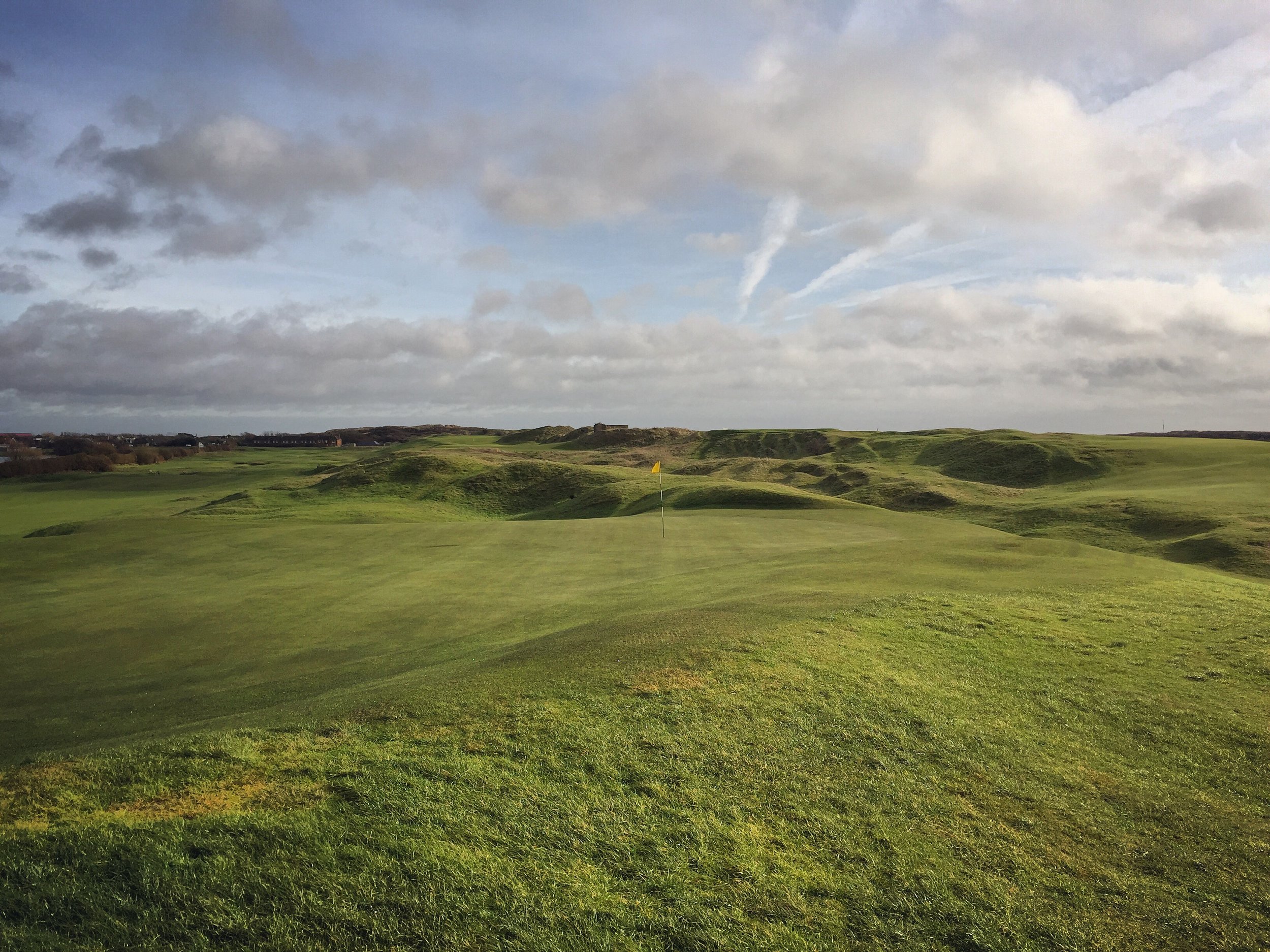Hole 14, The Saticoy Club
While we continued to chase new projects through RFPs and interviews, 2018 was highlighted by a return to the field with a full bunker renovation at The Saticoy Club near Ventura, CA. Getting back into the dirt and the excavator was good for multiple reasons—refine skills, increase experience, pay some bills—but maybe the most important of all was the reminder of how satisfying it is to get out and do creative work on a bigger scale. The whole reason I ever wanted to get into this golf design thing was to do creative work, and nothing is more of that than the actual shaping of golf features. No matter how business progresses over the years, I plan to be doing as much of this creative work as possible. It’s the driving force of everything we do.
The following contains a comprehensive look back on Hochstein Design’s 2018. I first dive into the work we did, primarily that which went into the ground (for multiple reasons, it’s too hard to comment on speculative work, as much as I would love to share some of those drawings and ideas). The second section explores some of the new golf courses visited this past year, highlighted by a study trip to Philadelphia that included visits to both Merion and Pine Valley. Finally, I round it out with some non-golf items like music and travel. Golf purists may not care what I think of that, but those things to me play an important role in shaping out the year.
As usual, everything is presented in list form for fun. Enjoy, and thanks for reading.
THE WORK
As mentioned before, Saticoy was the big project of the year. Thad Layton of Arnold Palmer Design Company called me up at the end of last year, inquiring about my interest in working at a club near Ventura with George Thomas ties in its history. It all sounded pretty good to me, and luckily it all came together with the project breaking ground in May.
The original Saticoy 9 in 1938. A lot of bunkers had clearly already been filled in, a trend during the Depression-Era 30s.
Saticoy CC (now renamed The Saticoy Club) was originally a 9 hole Thomas design down in the valley in the town of Saticoy. With a desire to grow to a full 18 though, they moved up into the nearby hills in the early 1960s and contracted William F. Bell (son of Billy Bell, George Thomas’s long time partner) to design the new course. It would be part of a newly beginning trend linking housing development and golf, but in this early version the routing seems not to have been overly compromised. Most of the housing sits up on narrow ridges that would have been difficult to place golf holes, and the best stretch of the property—the middle run of the back nine—was left alone to golf. The ground movement throughout the course is very good and interesting, and the greens are treacherously pitched, especially at today’s speeds. The bunker arrangement was quintessential 60s though—penal and repetitive—and made even moreso that way after the latest renovation by John Harbottle. They had also become especially difficult to play with sand splash build up making the deep bunkers even deeper. The first phase of the project was to work on these bunkers, first making them more playable but perhaps more importantly shifting them around to increase strategic interest among the holes. This is somewhat subtle work in the grand scheme of design, but it can have a major impact on how the hole can be played in both the long game and the short game. These sorts of changes can be just as satisfying as blowing the whole thing up and starting over.
It was a really great project to be involved with. Sure, it was bunker building in a beautiful spot, and Thad allowed a level of autonomy and input that drove me to do my best. What was really great about the project though were the people. Tim Paulson, the superintendent, was great to work with and is one of those guys who “gets it” when it comes to both turfgrass and architecture. Jeff Bradley of Coore and Crenshaw fame came in to help us along during the home stretch. As you can imagine, he was a really cool guy and great to stop and have a chat with. John Bolasky, the construction superintendent, straddles that perfect line between being easy-going and getting the job done. You can’t ask for much more than that in a contractor. And of course, Thad was a great partner throughout the project, and I really think we complemented each others’ respective skill sets. You can only hope for more projects to go like this one.
Saticoy wasn’t the only thing we did out in the field though. In August, I had to peel off the last bit of Saticoy to go build 3 new bunkers on the 7th hole at Santa Ana before returning back up to Ventura County. We also had a tee extension/renovation on the 6th hole at Cal Club, one of the benefits of which was tearing down the fence to open views of the Bay, and a reshaping project on the right side of the 17th hole at Orinda after eliminating a cart path there. Wiping out that ugly landform and returning it to how it used to be was an especially satisfying task.
Favorite Features of the Field
The Canyon Bunker just after shaping. Cutting straight into an existing landform brings instant gratification.
1. Canyon Bunker, Saticoy Funny enough, this could probably also double as my least favorite thing I worked on for how difficult and discomforting it was operating right next to the canyon edge. It was fun though to carve something straight out of the existing landform and make an instant impact. For awhile I wondered if we could even do a bunker in that spot, the concerns being overall steepness and finding a drainage solution that wouldn’t cause erosion. After seeing massive washouts coming from small pipes at Rustic Canyon and along U.S. 101, I knew that traditional bunker water collection and piping it out wouldn’t be an option unless somehow we could run the pipe all the way down to the base of the canyon—a very difficult task indeed. We decided to go for an informal “waste” bunker with straight line interceptor drains at the bottom that led to sumps in place. This means some water would be caught and held in place, and heavier rains would sheet over the edge broadly, just as they did before. With all this, we were able to achieve what we set out to do—create a visually striking feature as well as get balls to hold and keep from kicking down out of bounds into the canyon below.
2. Hole 13 Greenside Bunkers and Slope, Saticoy The first in a stretch of 3 outstanding and dramatic holes, the par 3 13th was just another hole before the project work started. It was surrounded by trees, especially at the back, and had that typical “bunker left, bunker(s) right” arrangement that every other hole on the course had. After clearing trees to open up the views, including revealing the dramatic backdrop and highlighting a couple of specimen stone pines, the feel of the hole completely changed for the better. After eliminating all the bunkers on the right, replacing them with a short grass kicker slope, and adding an additional little one on the left to cut a bit across the front of the green, the strategy of the hole is also completely different. Long hitters now have a tucked pin on the left to attack, and short hitters also have a way of finding it by hitting a running shot off the kicker slope.
Hole 13, The Saticoy Club. The backdrop was previously a wall of trees.
3. Hole 2 Greenside Bunkers and Surrounds - Saticoy This was a hole that was previously completely surrounded by bunkers, and similar to the 13th, we sought to change that up and give the shorter hitter another option to try and find the green by eliminating the left bunker and shrinking the front one in half. In place of the sand are short grass and contours that could help corral the ball onto the small, narrow putting surface. Yes, the hole is already a short par 4 for many. There are plenty of players though that still hit a longer club into the green, and it is important to consider their interests as well. On top of this, I think the arrangement turned out to be one of the more attractive sets on the course and fitting of the neat setting of the hole among giant old eucalyptus trees.
4. Hole 14 Greenside Bunkers and Surrounds - Saticoy There are a number of things to note here besides this being one of the best settings I’ve ever had the pleasure to work in. The first is that the left greenside bunker is one of my favorite individual bunkers that we rebuilt on the project. While working on it, I shifted the front part of it left about 5 or 6 feet. This is important because it makes a long approach into the par 5 green that much more inviting. The right side of the green had a bunker, but again in the name of variety, we eliminated it and replaced it with a sharp short grass falloff. Misses to the right will be pushed well away from the green, but there are more options now for how to play the recovery. The back bunker was supposed to be rebuilt in place, but the more I looked at it from the tee, the more it just felt disconnected from everything else going on. Additionally, it felt like there ought to be a bunker in the lower left approach area, where two canary pines happened to be standing at the time. I pitched this to Thad, and luckily everyone else was on board with the field change. It was a pain pulling out the stumps, and there was some difficult brush clearing that the grounds staff thankfully helped with, but the effort was well worth it.
5. Hole 15 Fairway Bunkers - Saticoy Trees and out of bounds on the left force a lot of the shorter hitters down the right of the hole, where a downslope would carry a ball right into the large first fairway bunker. To combat this, we shifted the first bunker out to the right to allow more room to skirt it. In exchange of that, we shifted the second fairway bunker to the left to catch more of the longer drives. These bunkers and the right greenside bunker all overlaid each other despite being well spread apart, and getting them to match up properly required a whole lot of cart rides back to the tees to check out how the top lines were all relating to one another.
The bunkers on the 15th at Saticoy play off of each other nicely, despite having gaps of about 40 and 70 yards between them.
6. Hole 7 New Bunkers - Santa Ana A loss of some specimen eucalyptus trees left the previously bunkerless hole a bit lacking in defense and visual features. Jay Blasi came up with a really nice scheme of 3 bunkers as a replacement solution. A big one at the turn of the grassline near the green keeps the big hitters honest, a little pot near that one also guards the aggressive line, and big bunker short and right guards what is actually the ideal line while providing nice visual balance.
New 7th hole bunkers at Santa Ana still in the dirt
7. Hole 5 Bunkers - Saticoy Besides greatly shrinking the front right greenside bunker and wrapping fairway around it, these bunkers were all just rebuilt in place. Nonetheless I really liked how they turned out and profile against one another.
Hole 18 fairway bunker almost finished, Saticoy Club
8. Hole 18 Fairway Bunker - Saticoy The biggest bunker at Saticoy by good margin, this was a fun one to build and have come together. Always nice to have a big space to work and throw dirt around!
9. 17th Fairway Cartpath erasing - Orinda Bunkers and greens are the most fun and satisfying features to work on, but erasing an ugly cartpath is not that far behind. It isn’t just the cartpath itself, it is the landforms needed to make it a flat and traversable surface. In the case of the 17th hole at Orinda, those landforms were particularly hideous as they broke up a broad, natural hillside, leaving an odd horizon line at the break. Spend a couple of hours on a dozer though, and it is mercifully gone.
10. 12th Hole Bunkers - Saticoy There was a thought at one point to eliminate the rear bunker of the left greenside pair, but after doing the same exact thing on the previous hole, it was better to leave it. Also, I thought with some tweaking that they could turn out to be a pretty nice pair. (previously it was hard to tell that they were two as the back bunker was hardly visible) They are simpler than a lot of others on the course, but I do think they work well together. As a bonus, they are now visible from the tees on 11 thanks to tree clearing. That was another reason to keep the pair together.
H.M. 6th tee renovation - Cal Club, Hole 10 Bunkers - Saticoy, Hole 11 Bunkers - Saticoy, Practice Bunker 2 - Saticoy
Favorite Features off the Field
1. Golf Guide Podcast
2. Jack Fleming Article for Golf Guide
3. Doing mock design drawings for potential work in the office (though they haven’t quite led to anything yet!)
Best Work Experiences
Good views, solitude, and beautiful evening light were the perks of working around the 14th green at Saticoy.
1. Working the greenside bunker on the 14th at Saticoy, a peaceful, natural corner with views down the canyon and out into the Pacific.
2. The Channel Islands appearing from the haze on a hot evening while working the fairway bunkers on the 5th at Saticoy.
3. Seeing the fence go down on the 6th tee at Cal Club and opening up new views to the San Francisco Bay
4. Building new bunkers on the 7th at Santa Ana. It was nice to work out there surrounded in turf as opposed to dirt for a change!
5. Working at Orinda close to home is always a good deal. It’s even better when you get to wipe out a benched-in carpath you’ve been dying to re-naturalize for years.
THE GOLF
Pine Valley, Hole 10
There is little doubt what was the highlight of golf discovery in 2018: a late September trip to Philadelphia. While I had been to the city around 10 or so times before, there had never been any time to go and have a look at any of the area’s great golf courses. With a potential visit for a family event looming, we decided to commit and make a week of it so that I could spend some time checking out a few of these great courses. In the 5 waterlogged days available to me, I was able to walk 9 different courses in both PA and NJ, including the two really big boys, Pine Valley and Merion.
Out West, I was able to check out a few courses while working at Saticoy. The South Course at LACC was the highlight, and I was able to see George Thomas’s two half-lost courses at Ojai and La Cumbre.
Along the way, I met a great number of good people, including superintendents, GMs, head professionals, enthusiastic members, and others. I’m appreciative of all these encounters and the hospitality that everyone showed me.
Best New-to-me Golf Courses Seen in 2018
Let's start by noting that this list is just a casual indicator of how good I feel a course is. It is a combination of how I think it holds up for a range of players as well as just how much I personally like it.
The brackets [ ] indicate a "Doak Scale" rating. It should be understood that I didn't spend the same amount of time on every place and that they were all first time visits. These rankings and ratings are somewhat arbitrary and based on what I saw, understood, and felt about each course. I also get admittedly swayed by firm conditions and links golf in particular; a true links course generally gets boosted by 1 or even 2 "Doak points" whenever I rate it. This didn’t actually seem to affect the soggy Philly courses too much though—their quality architecture is pretty easy to see and appreciate. Bottom line is don't get too worried if something seems too high or low--these are good golf courses that are largely interchangeable.
1. Pine Valley - Pine Valley, NJ; George Crump, with input and assistance from a number of fellow architects [10] I had always questioned Pine Valley’s status at the top, for its overall difficulty would seem to preclude it from being the ideal course. I still feel like the Old Course is the best, but damn, Pine Valley is really good. What really stands out to me about Pine Valley besides its beautifully scrubby setting is the shear amount of variety. Big greens, small greens. Open approaches, closed-off approaches. Wide fairways, tight fairways. There is a lot going on at all times, and I also felt like it was actually fairly playable for a mid-handicapper.
2. Merion (East) - Ardmore, PA; Hugh Wilson, with some revisions by William Flynn [9/Inc.] I was able to walk the East Course at the end of Gil Hanse’s renovation project with most of the course growing back in. It wasn’t a final product but it was easy enough to see everything going on, and there is a lot going on. Merion East uses the land beautifully not just to get a full 18 hole course but also to create a great variety of challenges. The course is no picnic, especially if the rough is left shaggy, but the architectural variety would make it a very fun and engaging play if your game is on. I’m probably rating this a 10 after seeing it in its re-completed state.
3. Aronimink - Newtown Square, PA; Donald Ross and J.B. McGovern* with recent restoration by Gil Hanse [8] This course is just solid. The routing is good, the bunkering is uniquely styled and well placed, and the greens have a lot of interesting stuff going on without ever crossing the line into crazy. The restoration work was carried out really well, with green edges recaptured, trees selectively cleared, and the bunkers restored to the version just after the course opened, of which there are numerous aerials available to see and mimic. It doesn’t matter whether Ross or McGovern were responsible for these bunkers, the right move was restoring to this version, which stands as unique in golf.
The 11th at Aronimink features a little of everything—clustered bunkering, the old white house, and a green with a lot going on.
4. Los Angeles Country Club (South) - Los Angeles, CA; Recent re-design by Gil Hanse [7] In just about every way, I think the Hanse team nailed this project. The South course is the perfect complement to the famous North. It is shorter, friendlier, and full of quirk. There is a great variety to the holes, including the table-like Biarritz on the 4th, the bunkerless 5th green with its front right mound, the “Redan-arritz” 9th, and the short grass Lion’s Mouth 10th green. This is all while doing excellent work with the native areas and washes and creating a bunker style similar to the North. The setting is also unlike any other, with the playing field unfolding beneath the glassy skyscrapers of Century City. While the North Course is an excellent strategic test of golf, the South is a course to just go out and have some fun. There can’t really be a much better 1-2 punch than that.
5. Merion (West) - Ardmore, PA; Hugh Wilson [7] I feel like I am much higher on this course than most people, but I really did enjoy it. The greens complexes feel even older and funkier than their East counterpart while also containing a lot of subtle beauty. The property has a few distinct sections, including a broad upper plateau, an intimate lower stream area, and rolling ground in between. The routing does a good job of meandering in and out of these different sections so well that I didn’t even realize I had returned to similar parts of the course I had already played. Throw in the short overall yardage and some quirk like the fallaway drop shot green at the 4th or the tees directly off the back of the 9th green, and you have a course that feels like it could be in the middle of the UK. That is a good thing in my book.
6. Rolling Green (Front 9 Only) - Springfield, PA; William Flynn [7/Inc.] It’s a testament to the overall strength of the Philadelphia golf scene that I previously knew little about this course. Quintessentially William Flynn, the course is a sublime mix of bold and simple. Big land movements are well used in the routing, and sweeping slopes are combined with big simple bunkering to create highly effective strategy and shot demands. Unfortunately, the rain reached such an extreme level of downpour that I retreated after nine. I am looking forward to getting back and seeing the rest though as well as what Riley Johns and Keith Rhebb are able to do in their restoration efforts.
7. Northwood - Monte Rio, CA; Alister MacKenzie [6] I finally made the trek up to the Russian River to play this fabled MacKenzie track among the redwoods. Because of how narrow and tree lined it looked, I didn’t really have that high of hopes for it despite the MacKenzie pedigree. My hopes were vastly exceeded, though. To start, the course is actually much wider than what it appears; the massive scale of the trees is what creates the narrowing effect. It’s fairly short nature also calls for more of a control game as well—I think I hit driver only 3 times. Throw in MacKenzie greens and a truly special setting, and you have a great golfing experience.
Golf Guide’s Kyle Surlow provides a nice sense of scale among the mighty redwoods of Northwood.
8. Gulph Mills - King of Prussia, PA; Primarily Donald Ross and Perry Maxwell [6] I had the misfortune of playing Gulph Mills after yet another couple of inches of rain, but that didn’t prevent me from seeing what was some pretty good architecture, even if it’s been a little jumbled over time. Gil Hanse has helped tie it all back together as well as taking out trees to open up vistas around the beautiful, pastoral property. I mainly came for the greens, especially the Maxwell ones, and they did not disappoint.
9. The Saticoy Club - Somis, CA, William F. Bell, with recent bunker revisions by Thad Layton (A.P.D.C.) [5.5] After the first phase of tree removal, there is now some room to play this up and down replacement course to the original George Thomas nine holer. It’s a 1960s housing development course, but don’t let that fool you, as there is some very good golf out here. With really good land movement, quick tilted greens, and standout holes like the 2nd, 13th, and 14th, Saticoy is worth checking out if in the area.
(t)10. Ojai Valley Inn - Ojai, CA; George Thomas, with many modifications through the years [5] George Thomas’s Golf Architecture in America is a fantastic read, but it also contains a large collection of tragic photos of dramatic SoCal golf courses that no longer exist in anything resembling that previous form. Two of those courses are his own—Ojai and La Cumbre. They both still exist, and there are still some good component features of them—the setting at Ojai is still incredible, for example—but the original drama and character is gone and not very easy to replace. It is still well worth trying to get back what you can, however. I am not sure how much incentive Ojai has in doing so at this time, but La Cumbre is starting to work with Jay Blasi, who I imagine will be working to try and put back whatever he can.
(t)10. La Cumbre - Santa Barbara, CA; George Thomas, with many modifications through the years [5] See above.
H.M. Cobb’s Creek - Philadelphia, PA, Hugh Wilson; Tavistock - Haddonfield, NJ; Alex Findlay; Bala - Philadelphia, PA, William Flynn; Corica Park - Alameda, CA, Rees Jones and Marc Logan; Quail Lodge - Carmel, CA, Robert Muir Graves, Todd Eckenrode; Contra Costa - Pleasant Hill, CA, Robert Trent Jones II redesign; Sierra View CC - Roseville, CA, Jack Fleming; Harding Park (Jack Fleming 9) - San Francisco, CA, Jack Fleming; Golden Gate Park - San Francisco, CA, Jack Fleming
*His involvement is speculated upon and mostly goes to the bunkers, which are different from Ross’s plan and anything else that Ross had built before or after.
Best New Holes Seen
This was honestly hard to discern, as so many courses in Philadelphia are almost equally solid throughout. It is also hard not to make this a list of just Pine Valley and Merion holes; nonetheless, I will shoot for diversity. Take the actual ranking with a grain of salt and just appreciate these holes as good examples of design.
1. Merion (East) No. 5
2. Pine Valley No. 13
3. LACC (South) No. 4
LACC South No. 4. I just love the feel and look of this hole.
4. Saticoy No. 14
5. Pine Valley No. 4
6. Aronimink No. 6
7. Pine Valley No. 16
8. Rolling Green No. 7
This bunker short and right is just where you would want a long iron or wood shot to land and feed onto the right-to-left tilted green.
9. Cobb’s Creek No. 12
10. Merion (West) No. 5
H.M. Pine Valley No. 1 (and every other hole), Merion (East) No. 10 (and every other hole), Saticoy No. 13, Gulph Mills Nos. 3-6, Northwood No. 6, Corica Park No. 2, Tavistock No. 11, Aronimink (Pick one, any one. It’s sure to be a good hole)
Best Greens: Design, Interest, and Sensibility
Aronimink’s greens are special and classic. Here is the 12th green with the 5th and the 4th further off in the background.
1. Pine Valley Bold, with lots of variety in size and strategy. The 1st, 4th, and 16th were my favorites.
2. Merion (East) I didn’t know what was in the ground before the recent work, but supposedly they are matched back up exactly as before by way of laser data. I liked what I saw though. The mix of bold and subtle creates challenges both on approaches and shorter putts. My favorite green was the large, tilting 5th.
3. Aronimink These aren’t quite the best Ross greens I’ve seen (hello Glens Falls), but they are pretty close to it. There is a lot of movement and variety that flow beautifully, and greens expansions in the restoration have reclaimed some very interesting pins and short game shots.
4. LACC (South) There are some really creative and bold green complexes on the South course, which also helps set it apart from the North, whose greens, while very good, are much simpler.
The short grass Lion’s Mouth-like green at LACC South is both unusual and fun.
5. Gulph Mills Perry Maxwell was responsible for a number of greens here, and you can tell as those greens have very natural looking, variable contours that while often subtle are very impactful upon play.
H.M. Northwood, Merion (West), Tavistock
Best Bunkering: Playing Importance, Aesthetics, and Context
1. Pine Valley Rugged, varied, punishing, and important to play. The tight little “surprise!” trench bunkers around the backs of greens were a highlight to me.
Rugged, beautiful, and strategic—the bunkering at Pine Valley. This is hole 13, probably my favorite on the course.
2. Aronimink Every time I checked the yardage of fairway bunkers guarding the ideal line (which was often dictated by greenside bunkering), they would be right around the yardage I would be trying to drive the ball. With some variety mixed in, that is pretty ideal for a course built to test your game. Also, McGovern’s clustered style really isn’t quite like Ross (or anything else), but kudos to the Hanse team for bringing back this version.
Jonathan Reisetter and Todd Eckenrode created some beautiful bunkering at Quail Lodge
3. Merion (East) Merion, like many old courses, always had that rugged sort of style to its bunkering. What always appealed to me though is the variety in size and scale of them. Nowhere is that more apparent than on a single hole, the 4th, which traverses across a massive fairway bunker before reaching a green surrounded by a series of little bunkers. The versions I saw had just been reworked by the Hanse team. They were still growing in when I walked around, but it will be interesting to see how they evolve aesthetically.
4. Rolling Green William Flynn is the master of dead simple strategy. Rolling Green is full of big, bold bunkers located right in the spot where you would like to play your ball.
5. LACC (South) More good work by the Hanse team. Stylistically similar to the more famous North course, the bunkers are fewer on the South, where short grass and contours come more into play and rightfully provide an ideal complement to the North.
H.M. Quail Lodge, Saticoy, Gulph Mills
The looping routing at the little par 3 course at Golden Gate Park makes it feel like an adventure while also changing up the angle of the Pacific wind.
Best Routings
(t)1. Pine Valley
(t)1. Merion
3. Rolling Green
4. Golden Gate Park
5. Merion (West)
H.M. LACC (South), Northwood, Aronimink
Champions of Fast and Firm--Best Turf + Conditions
This is a short and pretty incomplete list this year because of the abnormally wet conditions around Philadelphia this fall. If anyone watched the BMW Championship at Aronimink and saw how soft and wet it was, well, it only got worse from there. Weeks later when I visited, there were still bleachers and tournament stands all over because they could not get any equipment to them due to how soft the ground was. Outside of sandy Pine Valley, I can’t fairly assess any course for what their conditions might normally be and how they might normally play. I give a lot of credit though to every superintendent just for hanging on and staying afloat though, no pun intended.
Firm and fast rules the day at Corica Park
1. LACC (South) Short, lean and bouncy bermudagrass all over. The ground game is highly encouraged here, both from a distance and near the greens.
2. Corica Park Marc Logan, effective co-designer of the new course at Corica, is an agronomist by trade. He’s also Australian and therefore understands how to get lean, fast playing surfaces. The tight Santa Ana bermuda fairways lead right into slick approaches and surrounds of the quick, firm greens.
3. Pine Valley Not surprisingly, the only Philadelphia area course that had any semblance of firmness. Sand is good for golf.
4. Saticoy This goes particularly for the front nine, which has seen the fairways re-sodded with Santa Ana Bermuda. (The back nine will get the same treatment in a future phase of work.) The greens are notably slick and true, creating definite “no go” zones around the hole.
5. Plum Hollow Despite being the end of October after a rainy week previously, the fairways were firm and bouncy and the greens quite speedy. Superintendent John Sabat is doing a great job.
H.M. Merion (East) (Basically a futures projection), Contra Costa
Best Playing/Walking Experiences
Coming up the 9th at Aetna Springs for the final time
1. Also qualifying for “Most Bittersweet” round, my final go around at Aetna Springs tops the list. Still holding out faint hope for a comeback…
2. Walking Pine Valley with Jamie Slonis. This was a surprise invite from the night before, and it lived up to the hype. We went back nine first and were able to avoid play enough to see almost everything. This was definitely a case where I was glad to just walk for my first time out there, as I could really focus and look at things from different angles without worrying about hitting shots.
3. No clubs in tow, but getting to revisit LACC with Tommy Naccarato and learn more about its restoration process was a big highlight. Seeing the very cool South course for the first time too was a bonus.
4. Joining a Linksoul “Mandatory Golf Friday” at the last second and walking up to find I’m playing Matt Ginella and John Ashworth, both of whom I had never met. The real kicker was the Blue Angels taking off about 70 feet over our heads on the 6th tee—I don’t know if any of us had ever heard (or felt) anything that loud.
5. Finally getting in a round at Northwood with Kyle Surlow of Golf Guide. It was nice that we finished just before the monsoon, too.
(t)6. Walking Merion East with Ben Hillard of the Hanse team. Great to catch up with a friend, learn more about what they were doing, and take in a world class golf course.
(t)6. Playing Merion West alone on a nearly empty, gray fall Monday.
Merion West looking back down the 10th hole from the 18th tees
8. Another where I wasn’t playing, but walking Cobb’s Creek with historian Joe Bausch and learning all about it’s story was a really cool experience.
9. Finally playing a round at Plum Hollow with Jason and Keith, a couple of younger members enthusiastic about the historic Alison design.
(t)10. Walking Carmel Beach on Sunday of the Pebble Beach Pro-Am. As a kid watching this event in the snow of a Michigan winter, I had always wanted to be one of those people in the CBS shots of the peripheral scenery. Being there, you don’t realize just how close you actually are to the action on the 9th and 10th holes.
(t)10. Rounds at Ojai and Rustic Canyon with Thad Layton. Always fun to tee it up with Thad; always fun to tee it up at Rustic Canyon.
H.M. Solitary walk around Aronimink. Another course where it was nice to look at different angles and yardages as well as roll balls around the greens to analyze contours.
Cool Curiosities, Awesome Oddities: The Most Enjoyable Unusual Features
This year’s list of curiosities and oddities isn't quite as curious and odd as last year, but that’s what happens when the previous year included a trip to Scotland, which is not only the Home of Golf but also the home of quirk. Nonetheless, there was still some enjoyable funk to be had, most of which was in the Philadelphia area.
You usually only find tees this close to the green in the UK. 9 green and 10 tee at Merion West.
1. 9-10 tee transition, Merion (West)
2. The first tee right off the dining porch, Merion (East)
3. The quarry, Merion (West)
The barn is very much in play on the 10th at Tavistock.
4. Skyscrapers over the course, LACC (South)
5. The Devil’s A***ole, Pine Valley
6. Tavistock Barn Hole, Tavistock
7. Short grass Lion’s Mouth, LACC (South)
8. Old Hospital in middle of Bala
9. Old watertower halfway house, Pine Valley
10. Blind shot stairs, Diablo Hills
H.M. Barn House, Aronimink; The birthplace of snowboarding, Tavistock
Best Restoration Opportunities
Because I can never just relax and play golf...
MacKenzie’s landforms at Northwood are just sitting there waiting to be carved back out into bunkers.
1. Cobb’s Creek. Cobb’s story is well known, but the land and site are much more impressive than I imagined. Hope Gil Hanse and the Friends of Cobb’s Creek can get going on realizing this great story soon.
2. Northwood. Everything is right there for the taking. With Alister MacKenzie’s bunker landforms and greens contours still existing, this would be one of the easiest, most inexpensive, and most impactful restorations that can be had.
(t)3. Ojai. This and La Cumbre would top the list if full restorations seemed possible. So much has shifted around at Ojai, and outside homes/structures have imposed upon a good number of holes at La Cumbre, including some of the more famous ones. The pictures of both courses in Thomas’s book Golf Architecture in America are incredible.
(t)3. La Cumbre. See Ojai above.
Above: It would take some major earthwork to get back the 16th hole at La Cumbre, and even still the upper left fairway is now occupied by private residences.
(t)5. Merion (West). There are some really neat old funky features seemingly still lingering from Hugh Wilson’s time. Would be cool to freshen them up and bring back anything that’s missing.
(t)5. Bala. This course is like any good William Flynn course but at a smaller scale. Again, this wouldn’t be a need for major work as the main features are already there. Trees are the biggest issue.
THE EVERYTHING ELSE
These scenes were pretty nice to enjoy after a full day at Saticoy.
Travel is a side benefit of this business, especially if you don't overdo it. Seeing the world opens you up to new things in all senses--sights, sounds, tastes--and the people you get to meet make it even more worthwhile. 2018 was a bit lighter in this category, as a lot of time was spent in familiar locales around California, and my big golf visit of the year was in Philadelphia, the home of my brother+sister in law and a city I’ve previously spent a lot of time in. Nonetheless, let’s talk a little about it anyway.
Note: a big trip to Spain was excised from all of this, for it was non-golf related and will be addressed in a completely separate blog post. Not surprisingly, it would have unfairly dominated most categories.
We were lucky to stay 3 houses off this bike path in Newport Beach
Favorite Cities
1. Ventura, CA. Most underrated city on the West Coast?
2. Philadelphia, PA
3. Newport Beach, CA
Favorite food by Place
Saticoy, CA - Chile Verde Burrito, Los Comales
Ventura (Pierpont), CA - Ribeye Green Curry, Lucky Thai Restaurant
Ventura (Downtown), CA - Lamb Madras, Himalaya Restaurant
Philadelphia, PA - WaWa custom flatbreads sure come in handy for a quick lunch in between seeing courses
Newport Beach, CA - Crab feast at the Crab Cooker
Favorite Sights Seen
Again, not a whole ton to go off here this year since I never left California for work, and my big study trip was in a city I’ve spent a ton of time in. I can’t complain though, as California in itself is quite spectacular.
1. Highway 101 from Monterey southward. I had not yet experienced this stretch of road, but I very much enjoyed it, especially in the late day spring light when first driving down to Ventura.
2. Ronald Reagan Museum. It doesn’t matter what your politics are, a visit to a Presidential museum is both interesting and inspiring. Also pretty cool to get to walk around on Air Force One.
3. Balboa Pier Neighborhood. Newport Beach, CA. A bit lost in time, Balboa is a nice divergence from the rest of newer, flashier Newport. Also, there is a preponderance of frozen banana stands, and as we all know, “there’s always money in the banana stand.”
MUSIC
Anyone in this business who spends a lot of time in a machine out in the field knows how valuable a companion the art of music is. It is easy as well to draw parallels between the two, a great golf course acting as a great album with the component pieces—the holes and songs—standing individually while contributing to the work as a whole.
While there was some really good stuff I discovered this year, it felt like a step back from 2017. That happens, especially as you have heard more music over time. The more you have heard, the more difficult it is to discover something new that really gets you excited. Derek Duncan likes to ask on his Feed The Ball podcast, “How do we next advance the medium of golf architecture?” That is kind of where I am at with music.
One interesting trend though has been emerging: my affinity with female lead vocals. 6 of my top 7 albums this year prominently or exclusively feature female lead vocalists, and I’ve been into the female-led bands Alvvays and Sunflower Bean over the past few years. I am not sure if this is an overall trend, a change in personal tastes, or simply anomalous. I’m betting on some combination of trend and tastes, and I’m interested to see where it goes.
Best Albums
1. Lost Friends - Middle Kids. This is their debut full-length album, and it is fantastic with nary a bad track. There’s nothing really that unique about their sound, but I really like it and the subtle elements you pick up from multiple plays. The songwriting is the highlight with the pace and feel of each track varying speed and intensity for a very complete overall album experience.
2. Hell On - Neko Case As music critic Jim DeRogatis summarized, “even ‘ok Neko’ is still very good Neko.” I probably wouldn’t put this album in the upper half of her works, but I still really loved it. I think her voice is the best in all of music—truly raw and powerful. One listen to her live performances makes that clear.
3. Offering - Cults. A solid-to-good album from them bookended by a pair killer tracks.
4. I Don’t Run - Hinds
5. The Long Goodbye - The Essex Green A much more “normal-sounding” member of the Elephant 6, The Essex Green is especially great to listen to in autumn. It’s easy going with a subtle twang to it. After first discovering them while building bunkers in Holland, I picked up two of their albums for my Philadelphia trip. They didn’t disappoint.
6. Ok Computer - Radiohead. After many years of putting off a full listen of this famous album, I finally picked it up with the hopes of having the transcendental experience so many others have. I thought it was good, but it didn’t knock me off my feet the same way my first real listen to Wilco’s “Yankee Hotel Foxtrot” did 2 years ago. Perhaps that is just because so many elements of the album have been copied/utilized since. Or perhaps it is just like a great golf course that you don’t fully “get” the first few plays, and I need to continue listening further. We’ll see; look out for a possible retraction printed in a year’s time.
7. Hardly Electronic - The Essex Green
8. Marble Skies - Django Django
9. Hope Downs - Rolling Blackouts Coastal Fever Fast, upbeat indie rock with a little surfer twang. Good for knocking out some bunkers quickly in a decidedly SoCal setting.
(t)10. Bloom - Beach House Gotta listen to some Beach House while living in a beach house.
(t)10. 7 - Beach House
H.M. Vide Noir - Lord Huron; Twentytwo in Blue - Sunflower Bean; Out of Time - R.E.M.; Freedom’s Goblin - Ty Segall; Fín - Bigott; Case/Lang/Veirs - Case/Lang/Veirs; Bottle it In - Kurt Vile
Best Songs
As with Pine Valley and Merion with the “Best Holes” section, I struggled not letting Middle Kids and Neko Case dominate this list. Oh well…
1. "Gilded Lily" - Cults
2. “Edge of Town” - Middle Kids
3. "Halls of Sarah" - Neko Case
4. "Offering" - Cults
5. "Don’t Be Hiding" - Middle Kids
6. "Mr. Tillman" - Father John Misty
7. "Winnie" - Neko Case
8. "Karma Police" - Radiohead
9. "Nostalgic Feel" - Bedroom
10. "Lost in Time and Space" - Lord Huron
11. "Sloane Ranger" - The Essex Green
12. "Pitch or Honey" - Neko Case
13. "Shiny Happy People" - R.E.M.
14. “Tinseltown Swimming in Blood” - Destroyer
15. "Talking Straight" - Rolling Blackouts Coastal Fever
16. "New Birth in New England" - Phosphorescent
17. "My Lady’s on Fire" - Ty Segall
18. "Apocalypse” - Cigarettes after Sex
19. "Mistake" - Middle Kids
20. “One Trick Ponies” - Kurt Vile
H.M. "Other People" - Beach House, "Colors” - Beck, “Please” - Middle Kids, “Total Football” - Parquet Courts, “The Late Great Cassiopia” - The Essex Green, “Seven Wonders” - Fleetwood Mac, “Burn it Down” - Sunflower Bean
Best New Podcasts
Podcasts have started to dominate my headphones as time goes on. While I still love music, I’m feel like I am hitting a plateau as far as my discovery with it goes. Podcasts offer a chance to learn something new, get lost in a story, or just have feel like you have some company while working out on the far corner of the property.
As a lot of these are friends/social media friends, and I have contributed to one of them, I’ve listed this alphabetically instead of by ranking.
- Feed the Ball.
- Golf Guide Podcast.
- Golfer’s Journal Podcast
- iSeek Golf Podcast
- Sound Opinions
Also, I haven’t been able to listen to too much of Erik Anders Lang’s Podcast, but his episode with Sean Tully of the Meadow Club was fantastic. Hoping I can get into more of it in 2019.
Non-Golf Experiences of the Year
If you can believe it, golf isn't the only important thing in life. Visits to special places, once-in a lifetime events, and time spent with your best people is a huge part of the picture. These moments contribute to personal happiness and indirectly serve as inspiration to what we do out on the golf course site.
Toledo, Spain
1. Spanish Adventure with the Wife. This is number one with a bullet. For the first time in a number of years, we took a trip that was entirely on our own and had nothing to do with a golf project. And it was good—really good. It was not just the sights (which were incredible) or the food (which was delicious) or the arts (which were inspiring)—it was just getting to disconnect from everything else for two weeks and spend time with each other. As life will surely only get more busy and crazy, this is an important lesson to keep in mind.
2. Showing my brother and his wife around NorCal. For a multitude of reasons, this was my brother’s first trip out to the Golden State. We made sure to make the most of it though, exploring San Francisco and our favorite spots, catching a Warriors playoff game at Stadium Pub in Walnut Creek, and heading up to the mountains, which was highlighted by a visit to Yosemite.
3. Sharing the Big House with California Friends. Having lived in California for over 8 years now, I’ve developed some really good friendships. Just through living here and working, I am pretty familiar with their upbringings and where they grew up. Nobody had seen where I grew up though. My one good friend is a Penn State business school alum and the other a Northwestern grad. As such, they were interested in seeing a game sometime at Michigan Stadium and suggested going to this year’s tilt against Penn State. After first visiting my parents and driving around my native area, which was full of late peak fall color, we made a full weekend of it in Ann Arbor. The game didn’t go so great for them, but it was really special to share that experience and play tour guide for a place I once called home.
4. Welcoming a new niece and a newly expected nephew. I have officially entered into the uncharted waters of being an uncle, first with my brother and sister-in-law and next year with my own brother. These are certainly exciting times; I’m really looking forward to teaching them the value of playing the ball along the ground.
(t)5. Weddings. Only two this year (and both in NorCal!), but it’s always exciting to see your good friends get married. Both also happened to be at golf courses too, the first at The Bridges in San Ramon and the second at Tehama—two courses that make for a very pretty wedding backdrop but would also eat your lunch playing if your long game wasn’t sharp.
(t)5. Michigan’s surprise Final Four run. The first 12 or so years of my Michigan basketball fandom was not very fun at all. John Beilein has undoubtedly rectified this. Early in last year’s season though, the team squeaked out a come-from-behind OT win at home over an unranked UCLA team. At the time this felt like what they needed to eventually snag a 10 or 11 seed in the Tournament. Starting in early February though, the defense really clicked, and the team went on an absolute tear, winning the Big 10 Tournament (again) and making it all the way to the National Championship Game, where they fizzled out with poor shooting. I still regret not making it to either L.A. or San Antonio for one of the games, but who knows, maybe there will be another opportunity this year…
H.M. Watching U.S. Men’s Curling win gold in the wee hours. Never thought I would see it happen, but they did it, curling like a team on an absolute mission, which they were.
A Word of Thanks, and On to 2019...
Another good year getting to do what I love calls for another heap of thanks.
Thank you to everyone that accommodated me in my visits to your courses, especially those who took time to discuss them and architecture in general. The golf industry is a special group, and I always enjoy new encounters.
Thank you to everyone I worked with this year. I can luckily say it was a real pleasure on every job, big and small.
And lastly, thank you to the friends and family who help support this craziness, especially my fun-loving wife, who kills it in a job she works remotely and travels with me whenever she can. That effort and sacrifice makes all of this possible.
On to 2019, where we already have some exciting work lined up and will continue pushing Hochstein Design to the next level.
Thanks for reading, and cheers,
Brett

















